Systematic Review on Yoga as Effective as Physical Therapy to Reduce Lymphedema in Head and Neck Cancer Patients
VerifiedAdded on 2023/01/09
|32
|12486
|90
AI Summary
This systematic review explores the effectiveness of yoga as a physical therapy in reducing lymphedema in head and neck cancer patients. It examines the benefits of yoga, evaluates its impact on lymphedema, and provides intervention and recommendations for improving health outcomes.
Contribute Materials
Your contribution can guide someone’s learning journey. Share your
documents today.

Healthcare Leadership
Secure Best Marks with AI Grader
Need help grading? Try our AI Grader for instant feedback on your assignments.
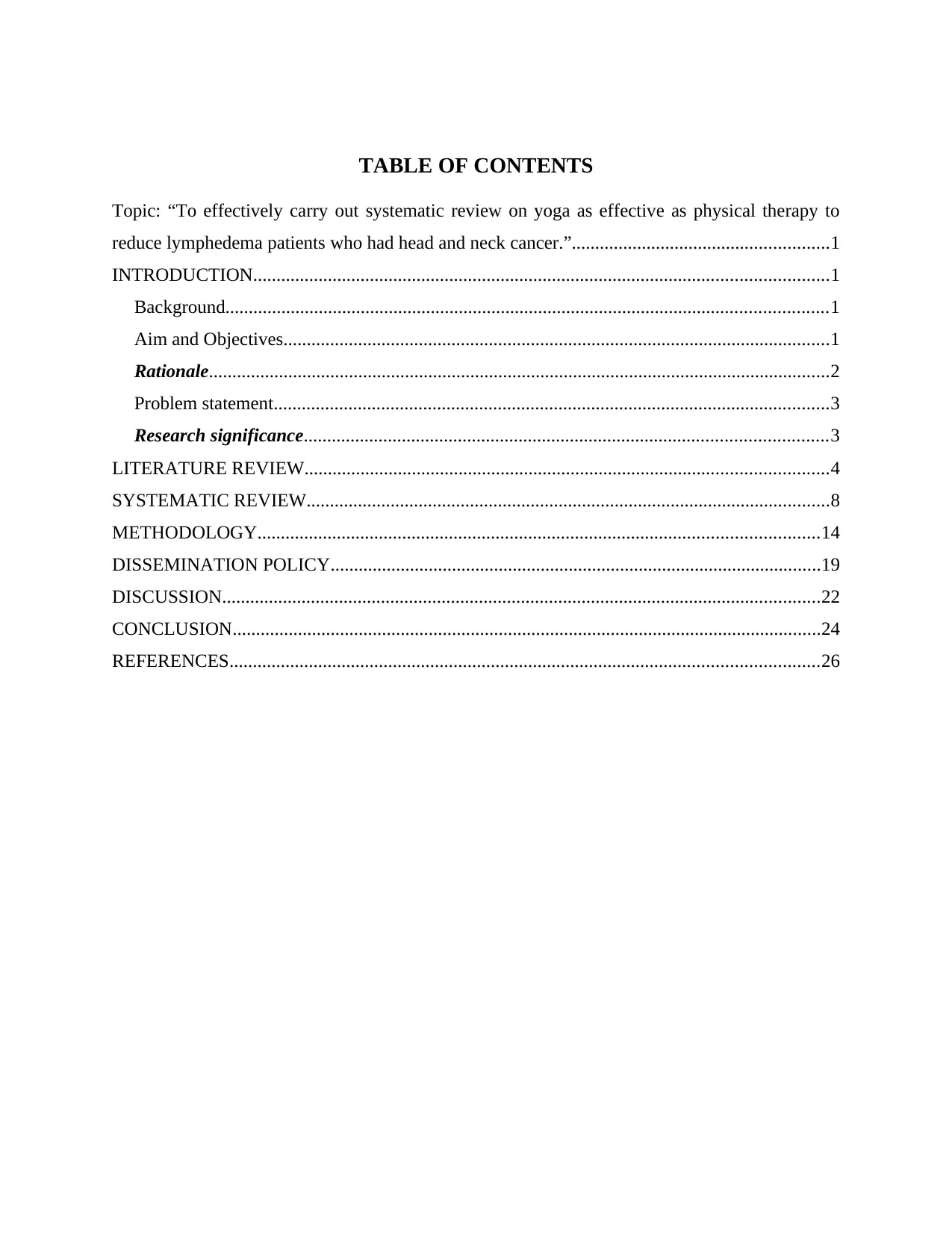
TABLE OF CONTENTS
Topic: “To effectively carry out systematic review on yoga as effective as physical therapy to
reduce lymphedema patients who had head and neck cancer.”.......................................................1
INTRODUCTION...........................................................................................................................1
Background.................................................................................................................................1
Aim and Objectives.....................................................................................................................1
Rationale.....................................................................................................................................2
Problem statement.......................................................................................................................3
Research significance................................................................................................................3
LITERATURE REVIEW................................................................................................................4
SYSTEMATIC REVIEW................................................................................................................8
METHODOLOGY........................................................................................................................14
DISSEMINATION POLICY.........................................................................................................19
DISCUSSION................................................................................................................................22
CONCLUSION..............................................................................................................................24
REFERENCES..............................................................................................................................26
Topic: “To effectively carry out systematic review on yoga as effective as physical therapy to
reduce lymphedema patients who had head and neck cancer.”.......................................................1
INTRODUCTION...........................................................................................................................1
Background.................................................................................................................................1
Aim and Objectives.....................................................................................................................1
Rationale.....................................................................................................................................2
Problem statement.......................................................................................................................3
Research significance................................................................................................................3
LITERATURE REVIEW................................................................................................................4
SYSTEMATIC REVIEW................................................................................................................8
METHODOLOGY........................................................................................................................14
DISSEMINATION POLICY.........................................................................................................19
DISCUSSION................................................................................................................................22
CONCLUSION..............................................................................................................................24
REFERENCES..............................................................................................................................26
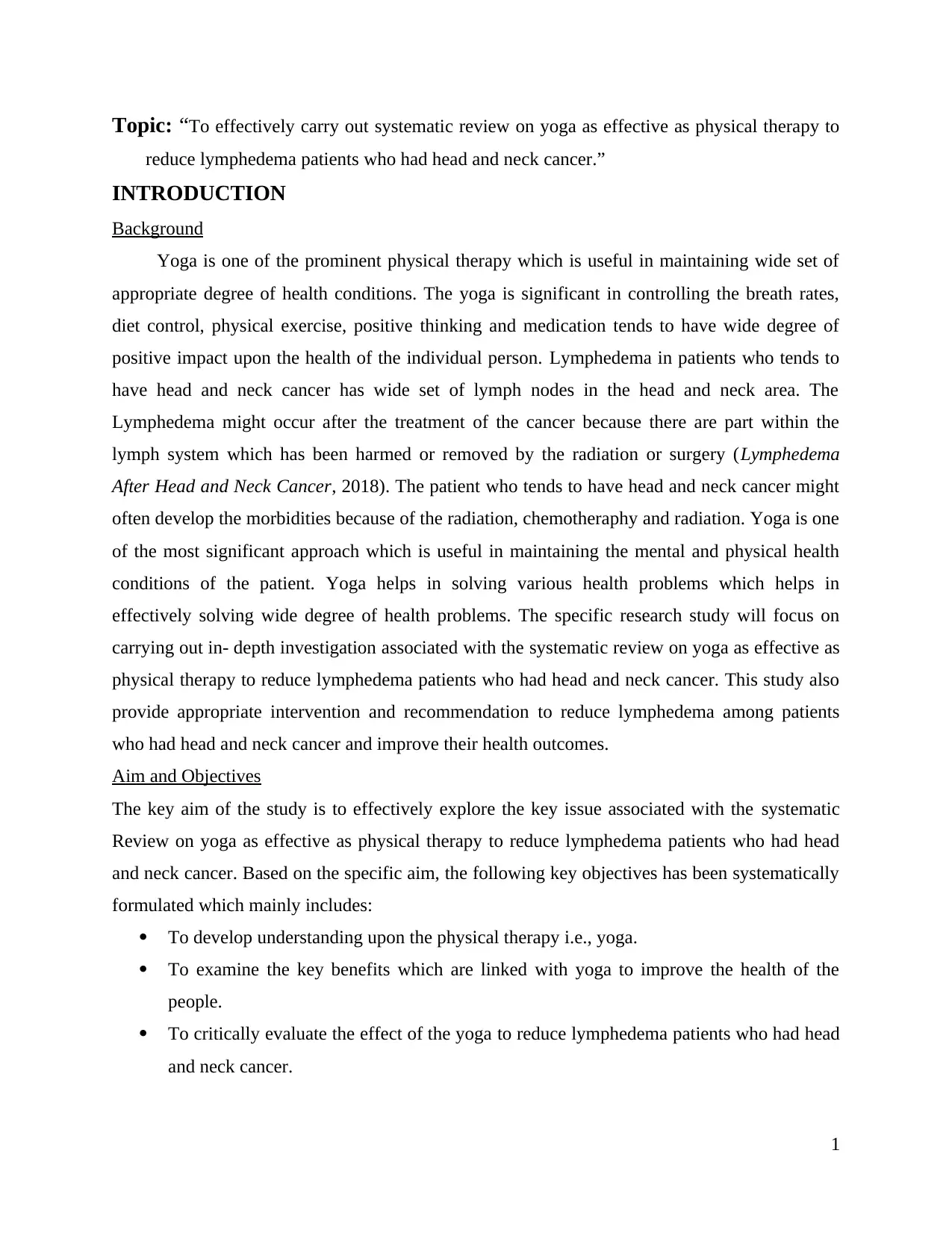
Topic: “To effectively carry out systematic review on yoga as effective as physical therapy to
reduce lymphedema patients who had head and neck cancer.”
INTRODUCTION
Background
Yoga is one of the prominent physical therapy which is useful in maintaining wide set of
appropriate degree of health conditions. The yoga is significant in controlling the breath rates,
diet control, physical exercise, positive thinking and medication tends to have wide degree of
positive impact upon the health of the individual person. Lymphedema in patients who tends to
have head and neck cancer has wide set of lymph nodes in the head and neck area. The
Lymphedema might occur after the treatment of the cancer because there are part within the
lymph system which has been harmed or removed by the radiation or surgery (Lymphedema
After Head and Neck Cancer, 2018). The patient who tends to have head and neck cancer might
often develop the morbidities because of the radiation, chemotheraphy and radiation. Yoga is one
of the most significant approach which is useful in maintaining the mental and physical health
conditions of the patient. Yoga helps in solving various health problems which helps in
effectively solving wide degree of health problems. The specific research study will focus on
carrying out in- depth investigation associated with the systematic review on yoga as effective as
physical therapy to reduce lymphedema patients who had head and neck cancer. This study also
provide appropriate intervention and recommendation to reduce lymphedema among patients
who had head and neck cancer and improve their health outcomes.
Aim and Objectives
The key aim of the study is to effectively explore the key issue associated with the systematic
Review on yoga as effective as physical therapy to reduce lymphedema patients who had head
and neck cancer. Based on the specific aim, the following key objectives has been systematically
formulated which mainly includes:
To develop understanding upon the physical therapy i.e., yoga.
To examine the key benefits which are linked with yoga to improve the health of the
people.
To critically evaluate the effect of the yoga to reduce lymphedema patients who had head
and neck cancer.
1
reduce lymphedema patients who had head and neck cancer.”
INTRODUCTION
Background
Yoga is one of the prominent physical therapy which is useful in maintaining wide set of
appropriate degree of health conditions. The yoga is significant in controlling the breath rates,
diet control, physical exercise, positive thinking and medication tends to have wide degree of
positive impact upon the health of the individual person. Lymphedema in patients who tends to
have head and neck cancer has wide set of lymph nodes in the head and neck area. The
Lymphedema might occur after the treatment of the cancer because there are part within the
lymph system which has been harmed or removed by the radiation or surgery (Lymphedema
After Head and Neck Cancer, 2018). The patient who tends to have head and neck cancer might
often develop the morbidities because of the radiation, chemotheraphy and radiation. Yoga is one
of the most significant approach which is useful in maintaining the mental and physical health
conditions of the patient. Yoga helps in solving various health problems which helps in
effectively solving wide degree of health problems. The specific research study will focus on
carrying out in- depth investigation associated with the systematic review on yoga as effective as
physical therapy to reduce lymphedema patients who had head and neck cancer. This study also
provide appropriate intervention and recommendation to reduce lymphedema among patients
who had head and neck cancer and improve their health outcomes.
Aim and Objectives
The key aim of the study is to effectively explore the key issue associated with the systematic
Review on yoga as effective as physical therapy to reduce lymphedema patients who had head
and neck cancer. Based on the specific aim, the following key objectives has been systematically
formulated which mainly includes:
To develop understanding upon the physical therapy i.e., yoga.
To examine the key benefits which are linked with yoga to improve the health of the
people.
To critically evaluate the effect of the yoga to reduce lymphedema patients who had head
and neck cancer.
1
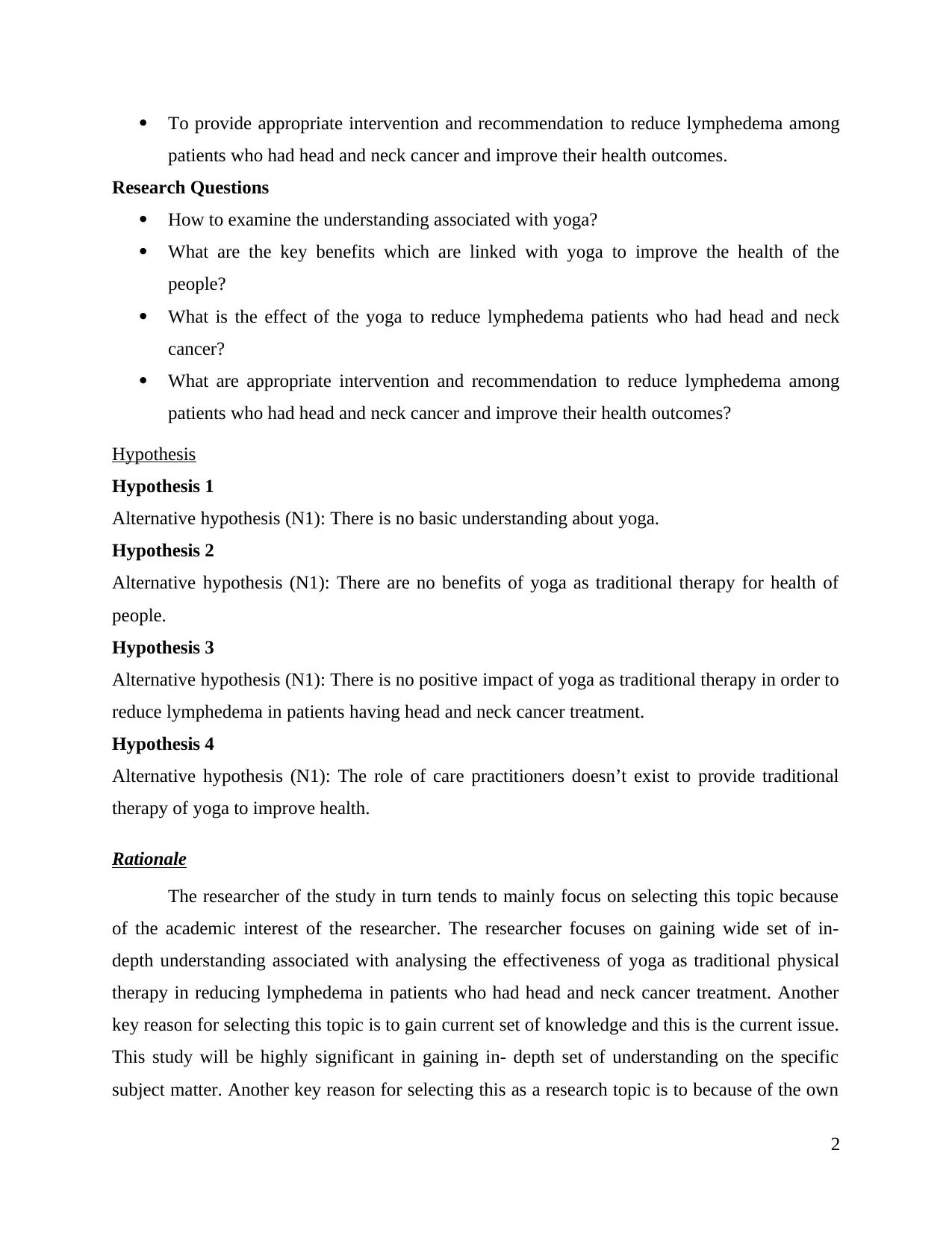
To provide appropriate intervention and recommendation to reduce lymphedema among
patients who had head and neck cancer and improve their health outcomes.
Research Questions
How to examine the understanding associated with yoga?
What are the key benefits which are linked with yoga to improve the health of the
people?
What is the effect of the yoga to reduce lymphedema patients who had head and neck
cancer?
What are appropriate intervention and recommendation to reduce lymphedema among
patients who had head and neck cancer and improve their health outcomes?
Hypothesis
Hypothesis 1
Alternative hypothesis (N1): There is no basic understanding about yoga.
Hypothesis 2
Alternative hypothesis (N1): There are no benefits of yoga as traditional therapy for health of
people.
Hypothesis 3
Alternative hypothesis (N1): There is no positive impact of yoga as traditional therapy in order to
reduce lymphedema in patients having head and neck cancer treatment.
Hypothesis 4
Alternative hypothesis (N1): The role of care practitioners doesn’t exist to provide traditional
therapy of yoga to improve health.
Rationale
The researcher of the study in turn tends to mainly focus on selecting this topic because
of the academic interest of the researcher. The researcher focuses on gaining wide set of in-
depth understanding associated with analysing the effectiveness of yoga as traditional physical
therapy in reducing lymphedema in patients who had head and neck cancer treatment. Another
key reason for selecting this topic is to gain current set of knowledge and this is the current issue.
This study will be highly significant in gaining in- depth set of understanding on the specific
subject matter. Another key reason for selecting this as a research topic is to because of the own
2
patients who had head and neck cancer and improve their health outcomes.
Research Questions
How to examine the understanding associated with yoga?
What are the key benefits which are linked with yoga to improve the health of the
people?
What is the effect of the yoga to reduce lymphedema patients who had head and neck
cancer?
What are appropriate intervention and recommendation to reduce lymphedema among
patients who had head and neck cancer and improve their health outcomes?
Hypothesis
Hypothesis 1
Alternative hypothesis (N1): There is no basic understanding about yoga.
Hypothesis 2
Alternative hypothesis (N1): There are no benefits of yoga as traditional therapy for health of
people.
Hypothesis 3
Alternative hypothesis (N1): There is no positive impact of yoga as traditional therapy in order to
reduce lymphedema in patients having head and neck cancer treatment.
Hypothesis 4
Alternative hypothesis (N1): The role of care practitioners doesn’t exist to provide traditional
therapy of yoga to improve health.
Rationale
The researcher of the study in turn tends to mainly focus on selecting this topic because
of the academic interest of the researcher. The researcher focuses on gaining wide set of in-
depth understanding associated with analysing the effectiveness of yoga as traditional physical
therapy in reducing lymphedema in patients who had head and neck cancer treatment. Another
key reason for selecting this topic is to gain current set of knowledge and this is the current issue.
This study will be highly significant in gaining in- depth set of understanding on the specific
subject matter. Another key reason for selecting this as a research topic is to because of the own
2
Secure Best Marks with AI Grader
Need help grading? Try our AI Grader for instant feedback on your assignments.
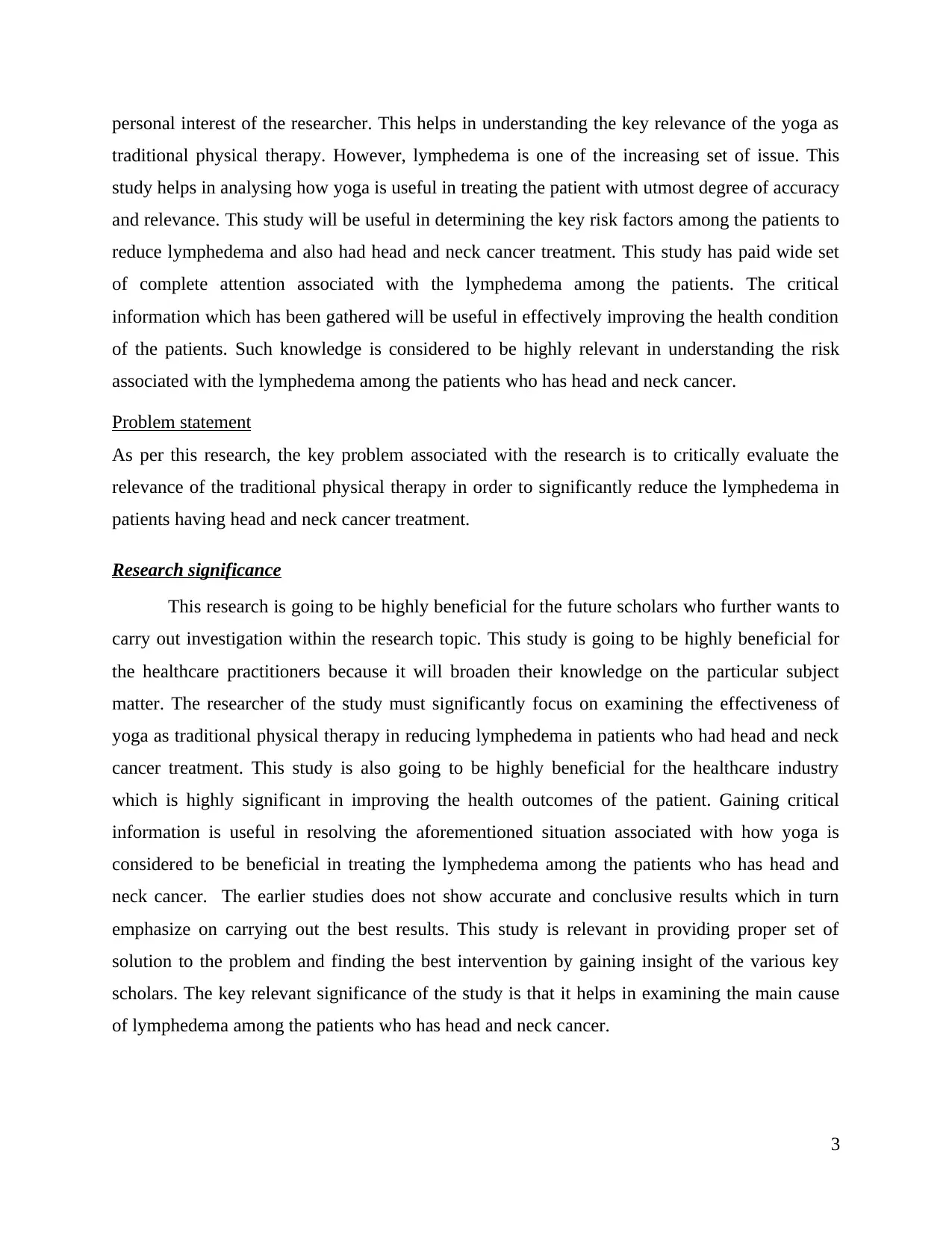
personal interest of the researcher. This helps in understanding the key relevance of the yoga as
traditional physical therapy. However, lymphedema is one of the increasing set of issue. This
study helps in analysing how yoga is useful in treating the patient with utmost degree of accuracy
and relevance. This study will be useful in determining the key risk factors among the patients to
reduce lymphedema and also had head and neck cancer treatment. This study has paid wide set
of complete attention associated with the lymphedema among the patients. The critical
information which has been gathered will be useful in effectively improving the health condition
of the patients. Such knowledge is considered to be highly relevant in understanding the risk
associated with the lymphedema among the patients who has head and neck cancer.
Problem statement
As per this research, the key problem associated with the research is to critically evaluate the
relevance of the traditional physical therapy in order to significantly reduce the lymphedema in
patients having head and neck cancer treatment.
Research significance
This research is going to be highly beneficial for the future scholars who further wants to
carry out investigation within the research topic. This study is going to be highly beneficial for
the healthcare practitioners because it will broaden their knowledge on the particular subject
matter. The researcher of the study must significantly focus on examining the effectiveness of
yoga as traditional physical therapy in reducing lymphedema in patients who had head and neck
cancer treatment. This study is also going to be highly beneficial for the healthcare industry
which is highly significant in improving the health outcomes of the patient. Gaining critical
information is useful in resolving the aforementioned situation associated with how yoga is
considered to be beneficial in treating the lymphedema among the patients who has head and
neck cancer. The earlier studies does not show accurate and conclusive results which in turn
emphasize on carrying out the best results. This study is relevant in providing proper set of
solution to the problem and finding the best intervention by gaining insight of the various key
scholars. The key relevant significance of the study is that it helps in examining the main cause
of lymphedema among the patients who has head and neck cancer.
3
traditional physical therapy. However, lymphedema is one of the increasing set of issue. This
study helps in analysing how yoga is useful in treating the patient with utmost degree of accuracy
and relevance. This study will be useful in determining the key risk factors among the patients to
reduce lymphedema and also had head and neck cancer treatment. This study has paid wide set
of complete attention associated with the lymphedema among the patients. The critical
information which has been gathered will be useful in effectively improving the health condition
of the patients. Such knowledge is considered to be highly relevant in understanding the risk
associated with the lymphedema among the patients who has head and neck cancer.
Problem statement
As per this research, the key problem associated with the research is to critically evaluate the
relevance of the traditional physical therapy in order to significantly reduce the lymphedema in
patients having head and neck cancer treatment.
Research significance
This research is going to be highly beneficial for the future scholars who further wants to
carry out investigation within the research topic. This study is going to be highly beneficial for
the healthcare practitioners because it will broaden their knowledge on the particular subject
matter. The researcher of the study must significantly focus on examining the effectiveness of
yoga as traditional physical therapy in reducing lymphedema in patients who had head and neck
cancer treatment. This study is also going to be highly beneficial for the healthcare industry
which is highly significant in improving the health outcomes of the patient. Gaining critical
information is useful in resolving the aforementioned situation associated with how yoga is
considered to be beneficial in treating the lymphedema among the patients who has head and
neck cancer. The earlier studies does not show accurate and conclusive results which in turn
emphasize on carrying out the best results. This study is relevant in providing proper set of
solution to the problem and finding the best intervention by gaining insight of the various key
scholars. The key relevant significance of the study is that it helps in examining the main cause
of lymphedema among the patients who has head and neck cancer.
3
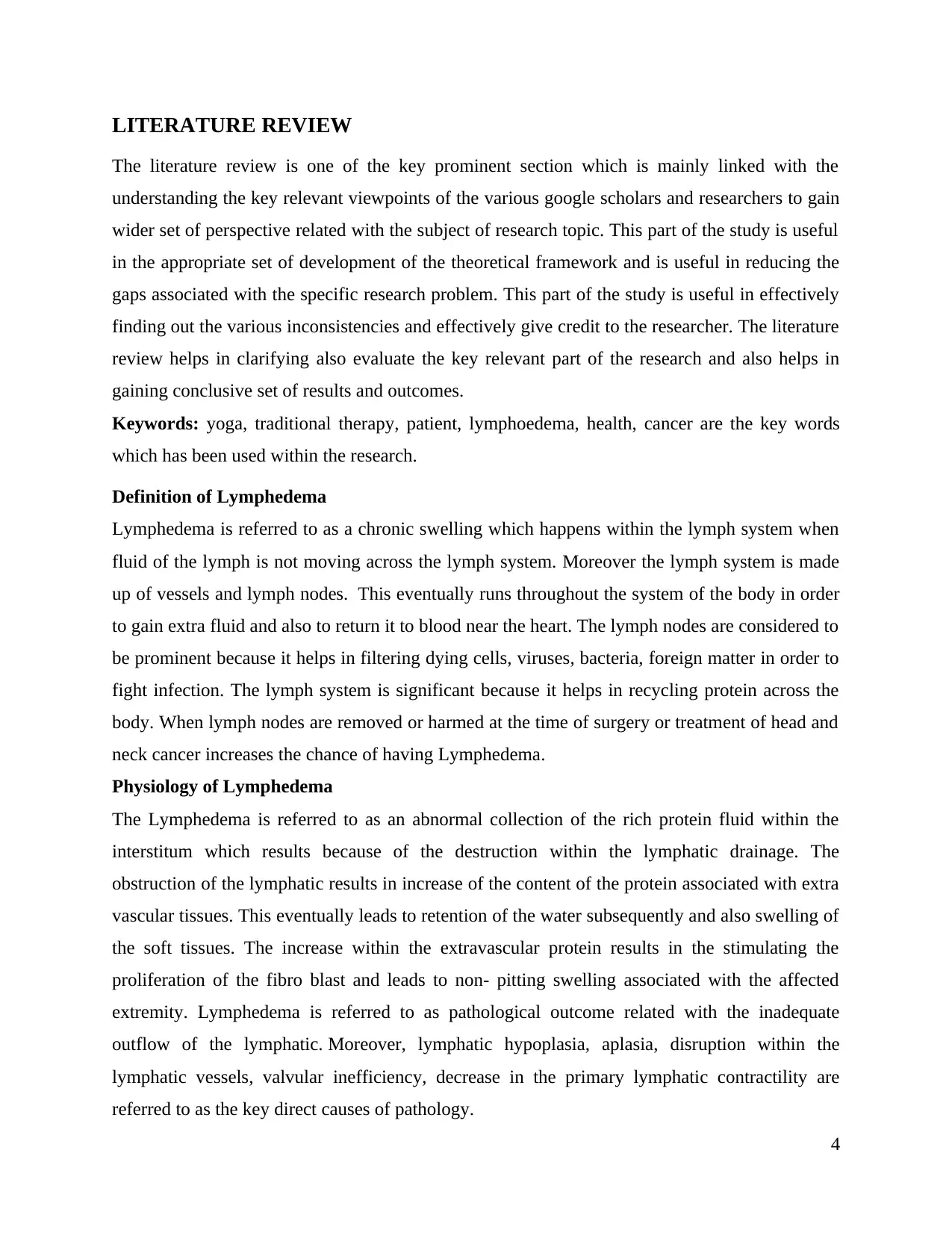
LITERATURE REVIEW
The literature review is one of the key prominent section which is mainly linked with the
understanding the key relevant viewpoints of the various google scholars and researchers to gain
wider set of perspective related with the subject of research topic. This part of the study is useful
in the appropriate set of development of the theoretical framework and is useful in reducing the
gaps associated with the specific research problem. This part of the study is useful in effectively
finding out the various inconsistencies and effectively give credit to the researcher. The literature
review helps in clarifying also evaluate the key relevant part of the research and also helps in
gaining conclusive set of results and outcomes.
Keywords: yoga, traditional therapy, patient, lymphoedema, health, cancer are the key words
which has been used within the research.
Definition of Lymphedema
Lymphedema is referred to as a chronic swelling which happens within the lymph system when
fluid of the lymph is not moving across the lymph system. Moreover the lymph system is made
up of vessels and lymph nodes. This eventually runs throughout the system of the body in order
to gain extra fluid and also to return it to blood near the heart. The lymph nodes are considered to
be prominent because it helps in filtering dying cells, viruses, bacteria, foreign matter in order to
fight infection. The lymph system is significant because it helps in recycling protein across the
body. When lymph nodes are removed or harmed at the time of surgery or treatment of head and
neck cancer increases the chance of having Lymphedema.
Physiology of Lymphedema
The Lymphedema is referred to as an abnormal collection of the rich protein fluid within the
interstitum which results because of the destruction within the lymphatic drainage. The
obstruction of the lymphatic results in increase of the content of the protein associated with extra
vascular tissues. This eventually leads to retention of the water subsequently and also swelling of
the soft tissues. The increase within the extravascular protein results in the stimulating the
proliferation of the fibro blast and leads to non- pitting swelling associated with the affected
extremity. Lymphedema is referred to as pathological outcome related with the inadequate
outflow of the lymphatic. Moreover, lymphatic hypoplasia, aplasia, disruption within the
lymphatic vessels, valvular inefficiency, decrease in the primary lymphatic contractility are
referred to as the key direct causes of pathology.
4
The literature review is one of the key prominent section which is mainly linked with the
understanding the key relevant viewpoints of the various google scholars and researchers to gain
wider set of perspective related with the subject of research topic. This part of the study is useful
in the appropriate set of development of the theoretical framework and is useful in reducing the
gaps associated with the specific research problem. This part of the study is useful in effectively
finding out the various inconsistencies and effectively give credit to the researcher. The literature
review helps in clarifying also evaluate the key relevant part of the research and also helps in
gaining conclusive set of results and outcomes.
Keywords: yoga, traditional therapy, patient, lymphoedema, health, cancer are the key words
which has been used within the research.
Definition of Lymphedema
Lymphedema is referred to as a chronic swelling which happens within the lymph system when
fluid of the lymph is not moving across the lymph system. Moreover the lymph system is made
up of vessels and lymph nodes. This eventually runs throughout the system of the body in order
to gain extra fluid and also to return it to blood near the heart. The lymph nodes are considered to
be prominent because it helps in filtering dying cells, viruses, bacteria, foreign matter in order to
fight infection. The lymph system is significant because it helps in recycling protein across the
body. When lymph nodes are removed or harmed at the time of surgery or treatment of head and
neck cancer increases the chance of having Lymphedema.
Physiology of Lymphedema
The Lymphedema is referred to as an abnormal collection of the rich protein fluid within the
interstitum which results because of the destruction within the lymphatic drainage. The
obstruction of the lymphatic results in increase of the content of the protein associated with extra
vascular tissues. This eventually leads to retention of the water subsequently and also swelling of
the soft tissues. The increase within the extravascular protein results in the stimulating the
proliferation of the fibro blast and leads to non- pitting swelling associated with the affected
extremity. Lymphedema is referred to as pathological outcome related with the inadequate
outflow of the lymphatic. Moreover, lymphatic hypoplasia, aplasia, disruption within the
lymphatic vessels, valvular inefficiency, decrease in the primary lymphatic contractility are
referred to as the key direct causes of pathology.
4
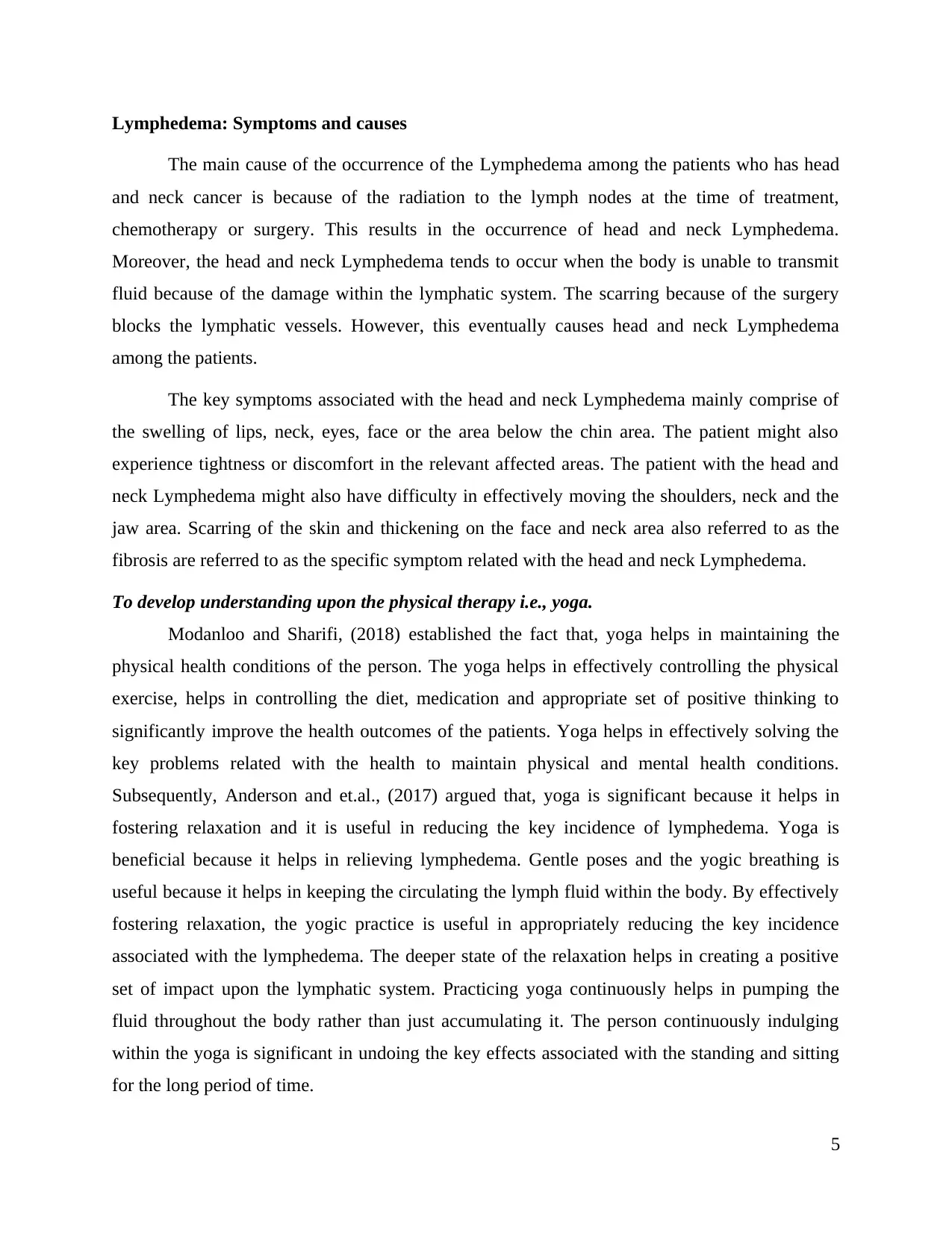
Lymphedema: Symptoms and causes
The main cause of the occurrence of the Lymphedema among the patients who has head
and neck cancer is because of the radiation to the lymph nodes at the time of treatment,
chemotherapy or surgery. This results in the occurrence of head and neck Lymphedema.
Moreover, the head and neck Lymphedema tends to occur when the body is unable to transmit
fluid because of the damage within the lymphatic system. The scarring because of the surgery
blocks the lymphatic vessels. However, this eventually causes head and neck Lymphedema
among the patients.
The key symptoms associated with the head and neck Lymphedema mainly comprise of
the swelling of lips, neck, eyes, face or the area below the chin area. The patient might also
experience tightness or discomfort in the relevant affected areas. The patient with the head and
neck Lymphedema might also have difficulty in effectively moving the shoulders, neck and the
jaw area. Scarring of the skin and thickening on the face and neck area also referred to as the
fibrosis are referred to as the specific symptom related with the head and neck Lymphedema.
To develop understanding upon the physical therapy i.e., yoga.
Modanloo and Sharifi, (2018) established the fact that, yoga helps in maintaining the
physical health conditions of the person. The yoga helps in effectively controlling the physical
exercise, helps in controlling the diet, medication and appropriate set of positive thinking to
significantly improve the health outcomes of the patients. Yoga helps in effectively solving the
key problems related with the health to maintain physical and mental health conditions.
Subsequently, Anderson and et.al., (2017) argued that, yoga is significant because it helps in
fostering relaxation and it is useful in reducing the key incidence of lymphedema. Yoga is
beneficial because it helps in relieving lymphedema. Gentle poses and the yogic breathing is
useful because it helps in keeping the circulating the lymph fluid within the body. By effectively
fostering relaxation, the yogic practice is useful in appropriately reducing the key incidence
associated with the lymphedema. The deeper state of the relaxation helps in creating a positive
set of impact upon the lymphatic system. Practicing yoga continuously helps in pumping the
fluid throughout the body rather than just accumulating it. The person continuously indulging
within the yoga is significant in undoing the key effects associated with the standing and sitting
for the long period of time.
5
The main cause of the occurrence of the Lymphedema among the patients who has head
and neck cancer is because of the radiation to the lymph nodes at the time of treatment,
chemotherapy or surgery. This results in the occurrence of head and neck Lymphedema.
Moreover, the head and neck Lymphedema tends to occur when the body is unable to transmit
fluid because of the damage within the lymphatic system. The scarring because of the surgery
blocks the lymphatic vessels. However, this eventually causes head and neck Lymphedema
among the patients.
The key symptoms associated with the head and neck Lymphedema mainly comprise of
the swelling of lips, neck, eyes, face or the area below the chin area. The patient might also
experience tightness or discomfort in the relevant affected areas. The patient with the head and
neck Lymphedema might also have difficulty in effectively moving the shoulders, neck and the
jaw area. Scarring of the skin and thickening on the face and neck area also referred to as the
fibrosis are referred to as the specific symptom related with the head and neck Lymphedema.
To develop understanding upon the physical therapy i.e., yoga.
Modanloo and Sharifi, (2018) established the fact that, yoga helps in maintaining the
physical health conditions of the person. The yoga helps in effectively controlling the physical
exercise, helps in controlling the diet, medication and appropriate set of positive thinking to
significantly improve the health outcomes of the patients. Yoga helps in effectively solving the
key problems related with the health to maintain physical and mental health conditions.
Subsequently, Anderson and et.al., (2017) argued that, yoga is significant because it helps in
fostering relaxation and it is useful in reducing the key incidence of lymphedema. Yoga is
beneficial because it helps in relieving lymphedema. Gentle poses and the yogic breathing is
useful because it helps in keeping the circulating the lymph fluid within the body. By effectively
fostering relaxation, the yogic practice is useful in appropriately reducing the key incidence
associated with the lymphedema. The deeper state of the relaxation helps in creating a positive
set of impact upon the lymphatic system. Practicing yoga continuously helps in pumping the
fluid throughout the body rather than just accumulating it. The person continuously indulging
within the yoga is significant in undoing the key effects associated with the standing and sitting
for the long period of time.
5
Paraphrase This Document
Need a fresh take? Get an instant paraphrase of this document with our AI Paraphraser
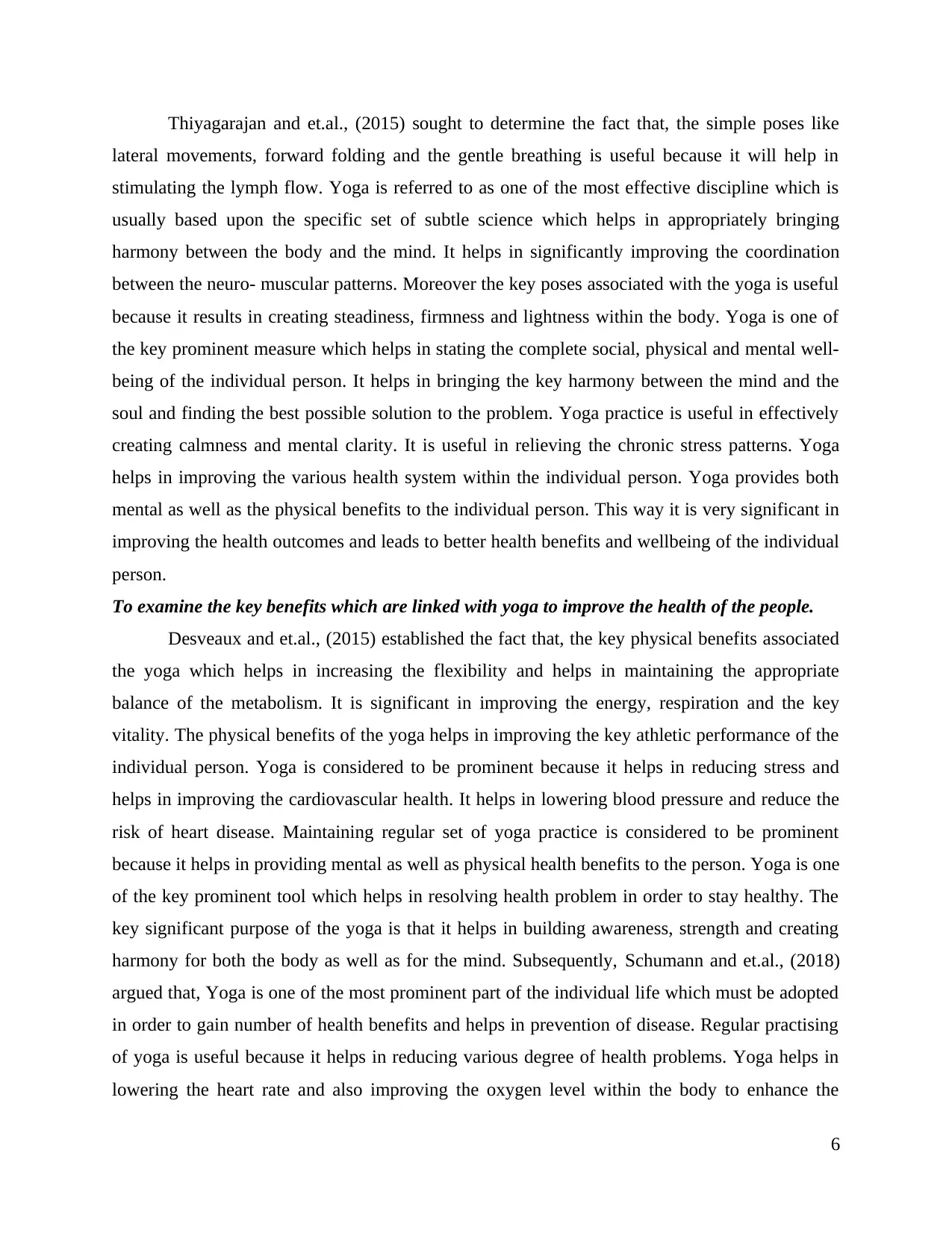
Thiyagarajan and et.al., (2015) sought to determine the fact that, the simple poses like
lateral movements, forward folding and the gentle breathing is useful because it will help in
stimulating the lymph flow. Yoga is referred to as one of the most effective discipline which is
usually based upon the specific set of subtle science which helps in appropriately bringing
harmony between the body and the mind. It helps in significantly improving the coordination
between the neuro- muscular patterns. Moreover the key poses associated with the yoga is useful
because it results in creating steadiness, firmness and lightness within the body. Yoga is one of
the key prominent measure which helps in stating the complete social, physical and mental well-
being of the individual person. It helps in bringing the key harmony between the mind and the
soul and finding the best possible solution to the problem. Yoga practice is useful in effectively
creating calmness and mental clarity. It is useful in relieving the chronic stress patterns. Yoga
helps in improving the various health system within the individual person. Yoga provides both
mental as well as the physical benefits to the individual person. This way it is very significant in
improving the health outcomes and leads to better health benefits and wellbeing of the individual
person.
To examine the key benefits which are linked with yoga to improve the health of the people.
Desveaux and et.al., (2015) established the fact that, the key physical benefits associated
the yoga which helps in increasing the flexibility and helps in maintaining the appropriate
balance of the metabolism. It is significant in improving the energy, respiration and the key
vitality. The physical benefits of the yoga helps in improving the key athletic performance of the
individual person. Yoga is considered to be prominent because it helps in reducing stress and
helps in improving the cardiovascular health. It helps in lowering blood pressure and reduce the
risk of heart disease. Maintaining regular set of yoga practice is considered to be prominent
because it helps in providing mental as well as physical health benefits to the person. Yoga is one
of the key prominent tool which helps in resolving health problem in order to stay healthy. The
key significant purpose of the yoga is that it helps in building awareness, strength and creating
harmony for both the body as well as for the mind. Subsequently, Schumann and et.al., (2018)
argued that, Yoga is one of the most prominent part of the individual life which must be adopted
in order to gain number of health benefits and helps in prevention of disease. Regular practising
of yoga is useful because it helps in reducing various degree of health problems. Yoga helps in
lowering the heart rate and also improving the oxygen level within the body to enhance the
6
lateral movements, forward folding and the gentle breathing is useful because it will help in
stimulating the lymph flow. Yoga is referred to as one of the most effective discipline which is
usually based upon the specific set of subtle science which helps in appropriately bringing
harmony between the body and the mind. It helps in significantly improving the coordination
between the neuro- muscular patterns. Moreover the key poses associated with the yoga is useful
because it results in creating steadiness, firmness and lightness within the body. Yoga is one of
the key prominent measure which helps in stating the complete social, physical and mental well-
being of the individual person. It helps in bringing the key harmony between the mind and the
soul and finding the best possible solution to the problem. Yoga practice is useful in effectively
creating calmness and mental clarity. It is useful in relieving the chronic stress patterns. Yoga
helps in improving the various health system within the individual person. Yoga provides both
mental as well as the physical benefits to the individual person. This way it is very significant in
improving the health outcomes and leads to better health benefits and wellbeing of the individual
person.
To examine the key benefits which are linked with yoga to improve the health of the people.
Desveaux and et.al., (2015) established the fact that, the key physical benefits associated
the yoga which helps in increasing the flexibility and helps in maintaining the appropriate
balance of the metabolism. It is significant in improving the energy, respiration and the key
vitality. The physical benefits of the yoga helps in improving the key athletic performance of the
individual person. Yoga is considered to be prominent because it helps in reducing stress and
helps in improving the cardiovascular health. It helps in lowering blood pressure and reduce the
risk of heart disease. Maintaining regular set of yoga practice is considered to be prominent
because it helps in providing mental as well as physical health benefits to the person. Yoga is one
of the key prominent tool which helps in resolving health problem in order to stay healthy. The
key significant purpose of the yoga is that it helps in building awareness, strength and creating
harmony for both the body as well as for the mind. Subsequently, Schumann and et.al., (2018)
argued that, Yoga is one of the most prominent part of the individual life which must be adopted
in order to gain number of health benefits and helps in prevention of disease. Regular practising
of yoga is useful because it helps in reducing various degree of health problems. Yoga helps in
lowering the heart rate and also improving the oxygen level within the body to enhance the
6
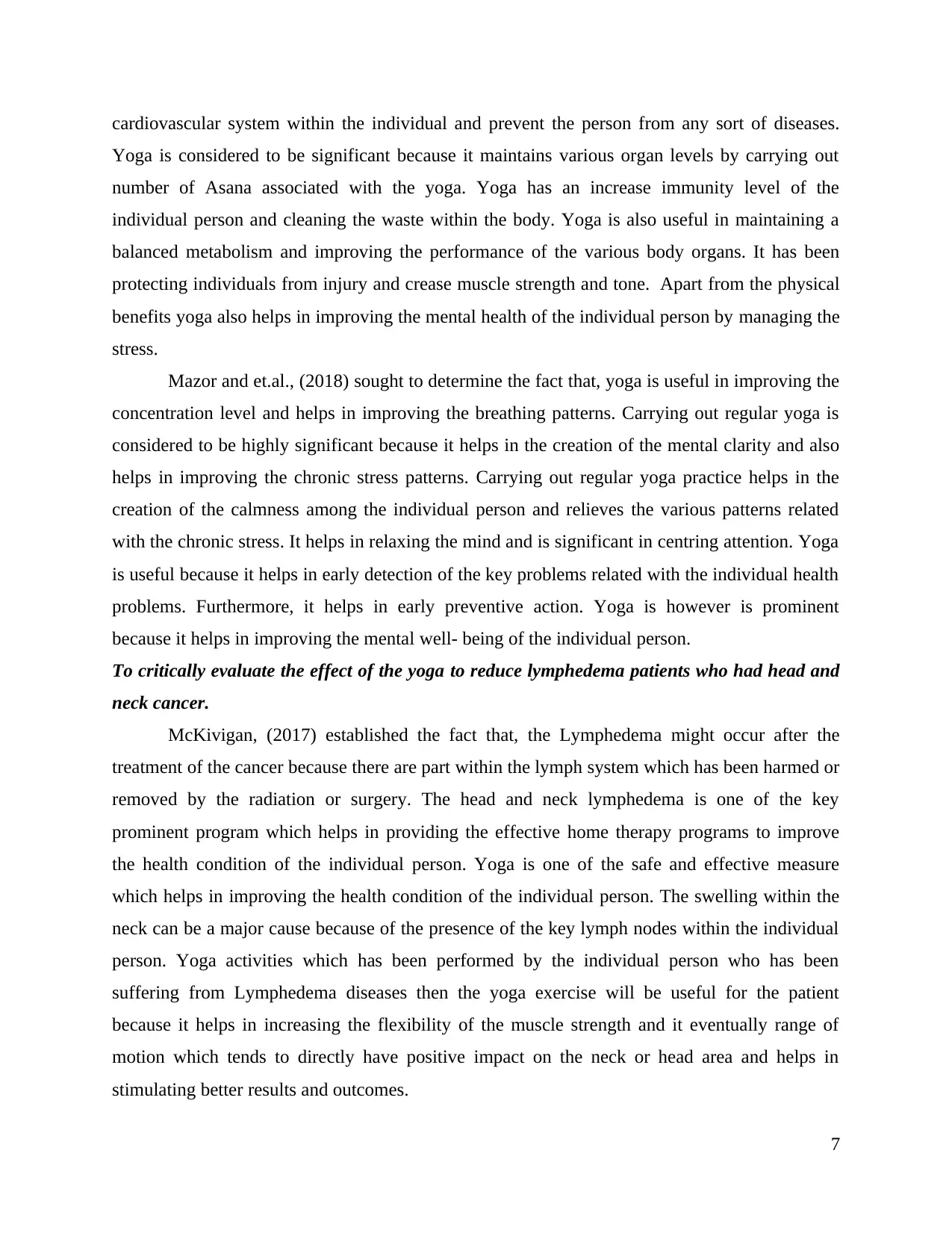
cardiovascular system within the individual and prevent the person from any sort of diseases.
Yoga is considered to be significant because it maintains various organ levels by carrying out
number of Asana associated with the yoga. Yoga has an increase immunity level of the
individual person and cleaning the waste within the body. Yoga is also useful in maintaining a
balanced metabolism and improving the performance of the various body organs. It has been
protecting individuals from injury and crease muscle strength and tone. Apart from the physical
benefits yoga also helps in improving the mental health of the individual person by managing the
stress.
Mazor and et.al., (2018) sought to determine the fact that, yoga is useful in improving the
concentration level and helps in improving the breathing patterns. Carrying out regular yoga is
considered to be highly significant because it helps in the creation of the mental clarity and also
helps in improving the chronic stress patterns. Carrying out regular yoga practice helps in the
creation of the calmness among the individual person and relieves the various patterns related
with the chronic stress. It helps in relaxing the mind and is significant in centring attention. Yoga
is useful because it helps in early detection of the key problems related with the individual health
problems. Furthermore, it helps in early preventive action. Yoga is however is prominent
because it helps in improving the mental well- being of the individual person.
To critically evaluate the effect of the yoga to reduce lymphedema patients who had head and
neck cancer.
McKivigan, (2017) established the fact that, the Lymphedema might occur after the
treatment of the cancer because there are part within the lymph system which has been harmed or
removed by the radiation or surgery. The head and neck lymphedema is one of the key
prominent program which helps in providing the effective home therapy programs to improve
the health condition of the individual person. Yoga is one of the safe and effective measure
which helps in improving the health condition of the individual person. The swelling within the
neck can be a major cause because of the presence of the key lymph nodes within the individual
person. Yoga activities which has been performed by the individual person who has been
suffering from Lymphedema diseases then the yoga exercise will be useful for the patient
because it helps in increasing the flexibility of the muscle strength and it eventually range of
motion which tends to directly have positive impact on the neck or head area and helps in
stimulating better results and outcomes.
7
Yoga is considered to be significant because it maintains various organ levels by carrying out
number of Asana associated with the yoga. Yoga has an increase immunity level of the
individual person and cleaning the waste within the body. Yoga is also useful in maintaining a
balanced metabolism and improving the performance of the various body organs. It has been
protecting individuals from injury and crease muscle strength and tone. Apart from the physical
benefits yoga also helps in improving the mental health of the individual person by managing the
stress.
Mazor and et.al., (2018) sought to determine the fact that, yoga is useful in improving the
concentration level and helps in improving the breathing patterns. Carrying out regular yoga is
considered to be highly significant because it helps in the creation of the mental clarity and also
helps in improving the chronic stress patterns. Carrying out regular yoga practice helps in the
creation of the calmness among the individual person and relieves the various patterns related
with the chronic stress. It helps in relaxing the mind and is significant in centring attention. Yoga
is useful because it helps in early detection of the key problems related with the individual health
problems. Furthermore, it helps in early preventive action. Yoga is however is prominent
because it helps in improving the mental well- being of the individual person.
To critically evaluate the effect of the yoga to reduce lymphedema patients who had head and
neck cancer.
McKivigan, (2017) established the fact that, the Lymphedema might occur after the
treatment of the cancer because there are part within the lymph system which has been harmed or
removed by the radiation or surgery. The head and neck lymphedema is one of the key
prominent program which helps in providing the effective home therapy programs to improve
the health condition of the individual person. Yoga is one of the safe and effective measure
which helps in improving the health condition of the individual person. The swelling within the
neck can be a major cause because of the presence of the key lymph nodes within the individual
person. Yoga activities which has been performed by the individual person who has been
suffering from Lymphedema diseases then the yoga exercise will be useful for the patient
because it helps in increasing the flexibility of the muscle strength and it eventually range of
motion which tends to directly have positive impact on the neck or head area and helps in
stimulating better results and outcomes.
7
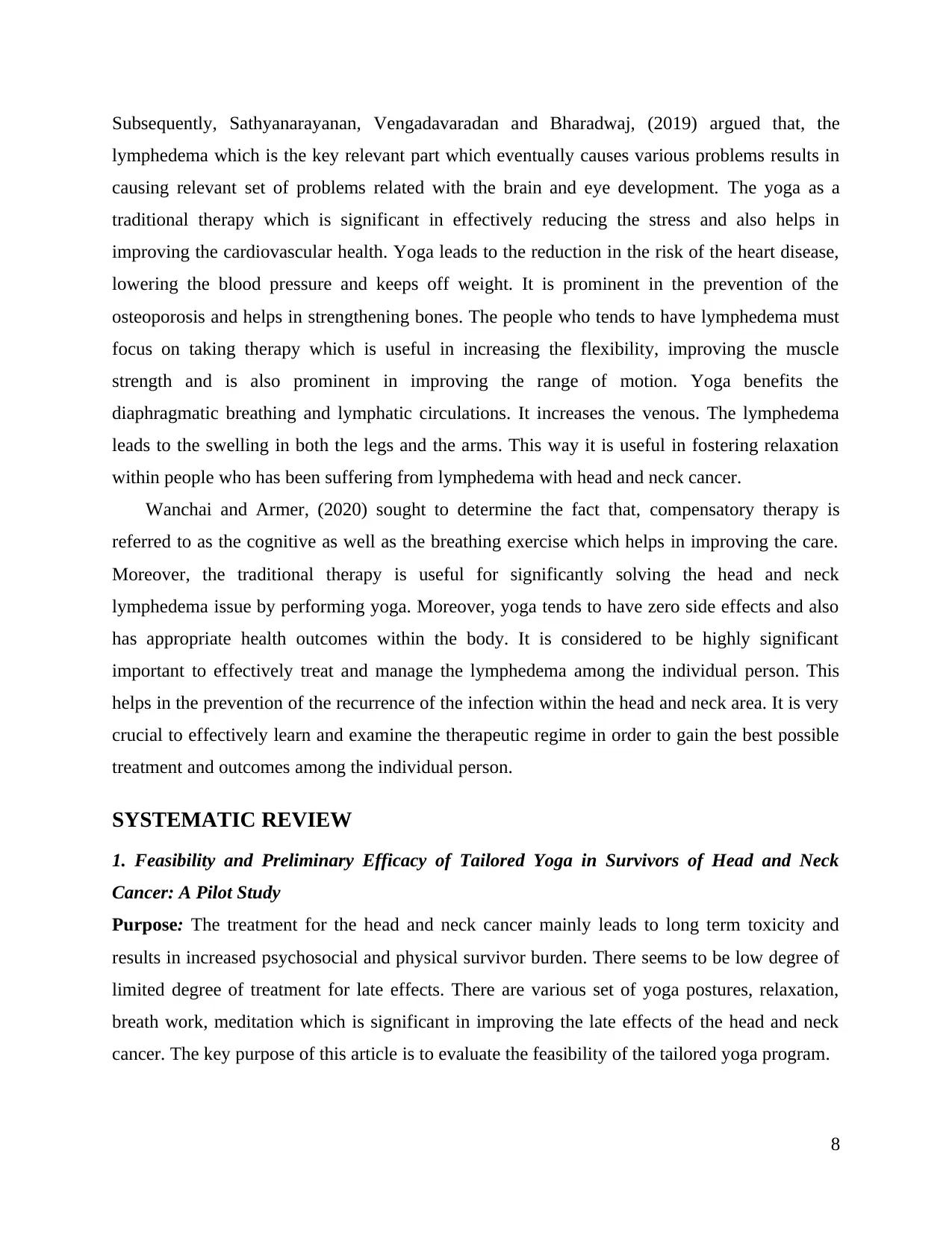
Subsequently, Sathyanarayanan, Vengadavaradan and Bharadwaj, (2019) argued that, the
lymphedema which is the key relevant part which eventually causes various problems results in
causing relevant set of problems related with the brain and eye development. The yoga as a
traditional therapy which is significant in effectively reducing the stress and also helps in
improving the cardiovascular health. Yoga leads to the reduction in the risk of the heart disease,
lowering the blood pressure and keeps off weight. It is prominent in the prevention of the
osteoporosis and helps in strengthening bones. The people who tends to have lymphedema must
focus on taking therapy which is useful in increasing the flexibility, improving the muscle
strength and is also prominent in improving the range of motion. Yoga benefits the
diaphragmatic breathing and lymphatic circulations. It increases the venous. The lymphedema
leads to the swelling in both the legs and the arms. This way it is useful in fostering relaxation
within people who has been suffering from lymphedema with head and neck cancer.
Wanchai and Armer, (2020) sought to determine the fact that, compensatory therapy is
referred to as the cognitive as well as the breathing exercise which helps in improving the care.
Moreover, the traditional therapy is useful for significantly solving the head and neck
lymphedema issue by performing yoga. Moreover, yoga tends to have zero side effects and also
has appropriate health outcomes within the body. It is considered to be highly significant
important to effectively treat and manage the lymphedema among the individual person. This
helps in the prevention of the recurrence of the infection within the head and neck area. It is very
crucial to effectively learn and examine the therapeutic regime in order to gain the best possible
treatment and outcomes among the individual person.
SYSTEMATIC REVIEW
1. Feasibility and Preliminary Efficacy of Tailored Yoga in Survivors of Head and Neck
Cancer: A Pilot Study
Purpose: The treatment for the head and neck cancer mainly leads to long term toxicity and
results in increased psychosocial and physical survivor burden. There seems to be low degree of
limited degree of treatment for late effects. There are various set of yoga postures, relaxation,
breath work, meditation which is significant in improving the late effects of the head and neck
cancer. The key purpose of this article is to evaluate the feasibility of the tailored yoga program.
8
lymphedema which is the key relevant part which eventually causes various problems results in
causing relevant set of problems related with the brain and eye development. The yoga as a
traditional therapy which is significant in effectively reducing the stress and also helps in
improving the cardiovascular health. Yoga leads to the reduction in the risk of the heart disease,
lowering the blood pressure and keeps off weight. It is prominent in the prevention of the
osteoporosis and helps in strengthening bones. The people who tends to have lymphedema must
focus on taking therapy which is useful in increasing the flexibility, improving the muscle
strength and is also prominent in improving the range of motion. Yoga benefits the
diaphragmatic breathing and lymphatic circulations. It increases the venous. The lymphedema
leads to the swelling in both the legs and the arms. This way it is useful in fostering relaxation
within people who has been suffering from lymphedema with head and neck cancer.
Wanchai and Armer, (2020) sought to determine the fact that, compensatory therapy is
referred to as the cognitive as well as the breathing exercise which helps in improving the care.
Moreover, the traditional therapy is useful for significantly solving the head and neck
lymphedema issue by performing yoga. Moreover, yoga tends to have zero side effects and also
has appropriate health outcomes within the body. It is considered to be highly significant
important to effectively treat and manage the lymphedema among the individual person. This
helps in the prevention of the recurrence of the infection within the head and neck area. It is very
crucial to effectively learn and examine the therapeutic regime in order to gain the best possible
treatment and outcomes among the individual person.
SYSTEMATIC REVIEW
1. Feasibility and Preliminary Efficacy of Tailored Yoga in Survivors of Head and Neck
Cancer: A Pilot Study
Purpose: The treatment for the head and neck cancer mainly leads to long term toxicity and
results in increased psychosocial and physical survivor burden. There seems to be low degree of
limited degree of treatment for late effects. There are various set of yoga postures, relaxation,
breath work, meditation which is significant in improving the late effects of the head and neck
cancer. The key purpose of this article is to evaluate the feasibility of the tailored yoga program.
8
Secure Best Marks with AI Grader
Need help grading? Try our AI Grader for instant feedback on your assignments.
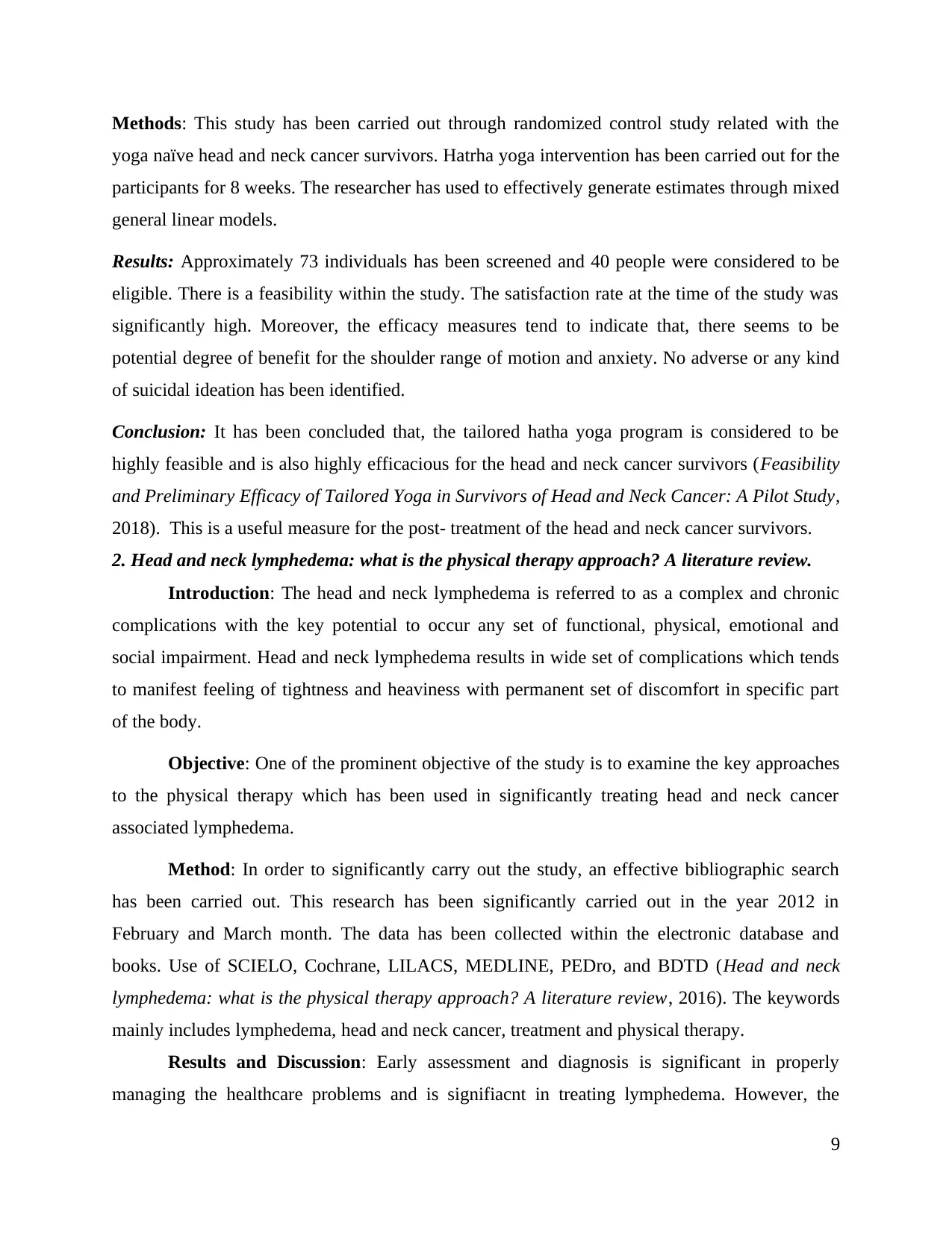
Methods: This study has been carried out through randomized control study related with the
yoga naïve head and neck cancer survivors. Hatrha yoga intervention has been carried out for the
participants for 8 weeks. The researcher has used to effectively generate estimates through mixed
general linear models.
Results: Approximately 73 individuals has been screened and 40 people were considered to be
eligible. There is a feasibility within the study. The satisfaction rate at the time of the study was
significantly high. Moreover, the efficacy measures tend to indicate that, there seems to be
potential degree of benefit for the shoulder range of motion and anxiety. No adverse or any kind
of suicidal ideation has been identified.
Conclusion: It has been concluded that, the tailored hatha yoga program is considered to be
highly feasible and is also highly efficacious for the head and neck cancer survivors (Feasibility
and Preliminary Efficacy of Tailored Yoga in Survivors of Head and Neck Cancer: A Pilot Study,
2018). This is a useful measure for the post- treatment of the head and neck cancer survivors.
2. Head and neck lymphedema: what is the physical therapy approach? A literature review.
Introduction: The head and neck lymphedema is referred to as a complex and chronic
complications with the key potential to occur any set of functional, physical, emotional and
social impairment. Head and neck lymphedema results in wide set of complications which tends
to manifest feeling of tightness and heaviness with permanent set of discomfort in specific part
of the body.
Objective: One of the prominent objective of the study is to examine the key approaches
to the physical therapy which has been used in significantly treating head and neck cancer
associated lymphedema.
Method: In order to significantly carry out the study, an effective bibliographic search
has been carried out. This research has been significantly carried out in the year 2012 in
February and March month. The data has been collected within the electronic database and
books. Use of SCIELO, Cochrane, LILACS, MEDLINE, PEDro, and BDTD (Head and neck
lymphedema: what is the physical therapy approach? A literature review, 2016). The keywords
mainly includes lymphedema, head and neck cancer, treatment and physical therapy.
Results and Discussion: Early assessment and diagnosis is significant in properly
managing the healthcare problems and is signifiacnt in treating lymphedema. However, the
9
yoga naïve head and neck cancer survivors. Hatrha yoga intervention has been carried out for the
participants for 8 weeks. The researcher has used to effectively generate estimates through mixed
general linear models.
Results: Approximately 73 individuals has been screened and 40 people were considered to be
eligible. There is a feasibility within the study. The satisfaction rate at the time of the study was
significantly high. Moreover, the efficacy measures tend to indicate that, there seems to be
potential degree of benefit for the shoulder range of motion and anxiety. No adverse or any kind
of suicidal ideation has been identified.
Conclusion: It has been concluded that, the tailored hatha yoga program is considered to be
highly feasible and is also highly efficacious for the head and neck cancer survivors (Feasibility
and Preliminary Efficacy of Tailored Yoga in Survivors of Head and Neck Cancer: A Pilot Study,
2018). This is a useful measure for the post- treatment of the head and neck cancer survivors.
2. Head and neck lymphedema: what is the physical therapy approach? A literature review.
Introduction: The head and neck lymphedema is referred to as a complex and chronic
complications with the key potential to occur any set of functional, physical, emotional and
social impairment. Head and neck lymphedema results in wide set of complications which tends
to manifest feeling of tightness and heaviness with permanent set of discomfort in specific part
of the body.
Objective: One of the prominent objective of the study is to examine the key approaches
to the physical therapy which has been used in significantly treating head and neck cancer
associated lymphedema.
Method: In order to significantly carry out the study, an effective bibliographic search
has been carried out. This research has been significantly carried out in the year 2012 in
February and March month. The data has been collected within the electronic database and
books. Use of SCIELO, Cochrane, LILACS, MEDLINE, PEDro, and BDTD (Head and neck
lymphedema: what is the physical therapy approach? A literature review, 2016). The keywords
mainly includes lymphedema, head and neck cancer, treatment and physical therapy.
Results and Discussion: Early assessment and diagnosis is significant in properly
managing the healthcare problems and is signifiacnt in treating lymphedema. However, the
9
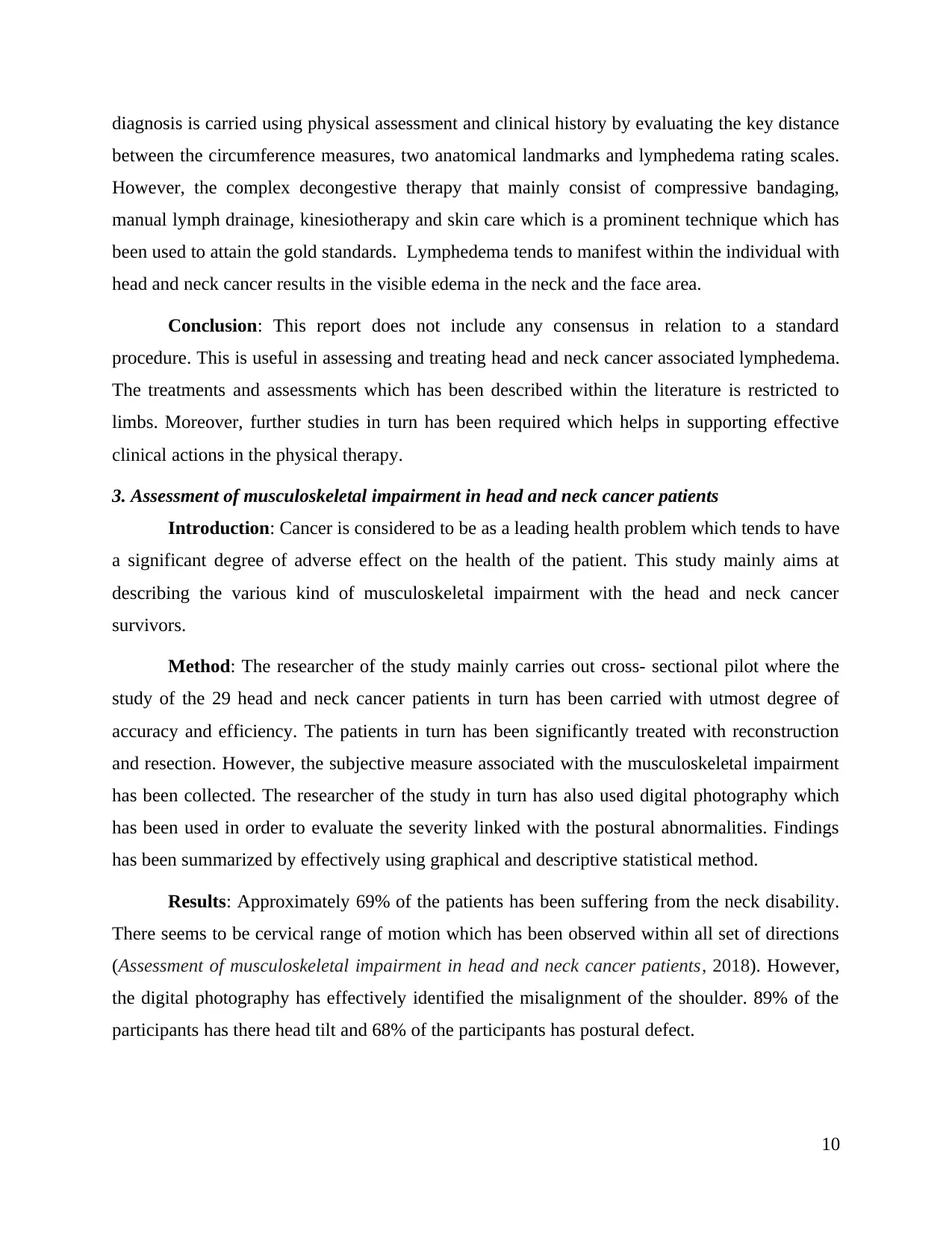
diagnosis is carried using physical assessment and clinical history by evaluating the key distance
between the circumference measures, two anatomical landmarks and lymphedema rating scales.
However, the complex decongestive therapy that mainly consist of compressive bandaging,
manual lymph drainage, kinesiotherapy and skin care which is a prominent technique which has
been used to attain the gold standards. Lymphedema tends to manifest within the individual with
head and neck cancer results in the visible edema in the neck and the face area.
Conclusion: This report does not include any consensus in relation to a standard
procedure. This is useful in assessing and treating head and neck cancer associated lymphedema.
The treatments and assessments which has been described within the literature is restricted to
limbs. Moreover, further studies in turn has been required which helps in supporting effective
clinical actions in the physical therapy.
3. Assessment of musculoskeletal impairment in head and neck cancer patients
Introduction: Cancer is considered to be as a leading health problem which tends to have
a significant degree of adverse effect on the health of the patient. This study mainly aims at
describing the various kind of musculoskeletal impairment with the head and neck cancer
survivors.
Method: The researcher of the study mainly carries out cross- sectional pilot where the
study of the 29 head and neck cancer patients in turn has been carried with utmost degree of
accuracy and efficiency. The patients in turn has been significantly treated with reconstruction
and resection. However, the subjective measure associated with the musculoskeletal impairment
has been collected. The researcher of the study in turn has also used digital photography which
has been used in order to evaluate the severity linked with the postural abnormalities. Findings
has been summarized by effectively using graphical and descriptive statistical method.
Results: Approximately 69% of the patients has been suffering from the neck disability.
There seems to be cervical range of motion which has been observed within all set of directions
(Assessment of musculoskeletal impairment in head and neck cancer patients, 2018). However,
the digital photography has effectively identified the misalignment of the shoulder. 89% of the
participants has there head tilt and 68% of the participants has postural defect.
10
between the circumference measures, two anatomical landmarks and lymphedema rating scales.
However, the complex decongestive therapy that mainly consist of compressive bandaging,
manual lymph drainage, kinesiotherapy and skin care which is a prominent technique which has
been used to attain the gold standards. Lymphedema tends to manifest within the individual with
head and neck cancer results in the visible edema in the neck and the face area.
Conclusion: This report does not include any consensus in relation to a standard
procedure. This is useful in assessing and treating head and neck cancer associated lymphedema.
The treatments and assessments which has been described within the literature is restricted to
limbs. Moreover, further studies in turn has been required which helps in supporting effective
clinical actions in the physical therapy.
3. Assessment of musculoskeletal impairment in head and neck cancer patients
Introduction: Cancer is considered to be as a leading health problem which tends to have
a significant degree of adverse effect on the health of the patient. This study mainly aims at
describing the various kind of musculoskeletal impairment with the head and neck cancer
survivors.
Method: The researcher of the study mainly carries out cross- sectional pilot where the
study of the 29 head and neck cancer patients in turn has been carried with utmost degree of
accuracy and efficiency. The patients in turn has been significantly treated with reconstruction
and resection. However, the subjective measure associated with the musculoskeletal impairment
has been collected. The researcher of the study in turn has also used digital photography which
has been used in order to evaluate the severity linked with the postural abnormalities. Findings
has been summarized by effectively using graphical and descriptive statistical method.
Results: Approximately 69% of the patients has been suffering from the neck disability.
There seems to be cervical range of motion which has been observed within all set of directions
(Assessment of musculoskeletal impairment in head and neck cancer patients, 2018). However,
the digital photography has effectively identified the misalignment of the shoulder. 89% of the
participants has there head tilt and 68% of the participants has postural defect.
10
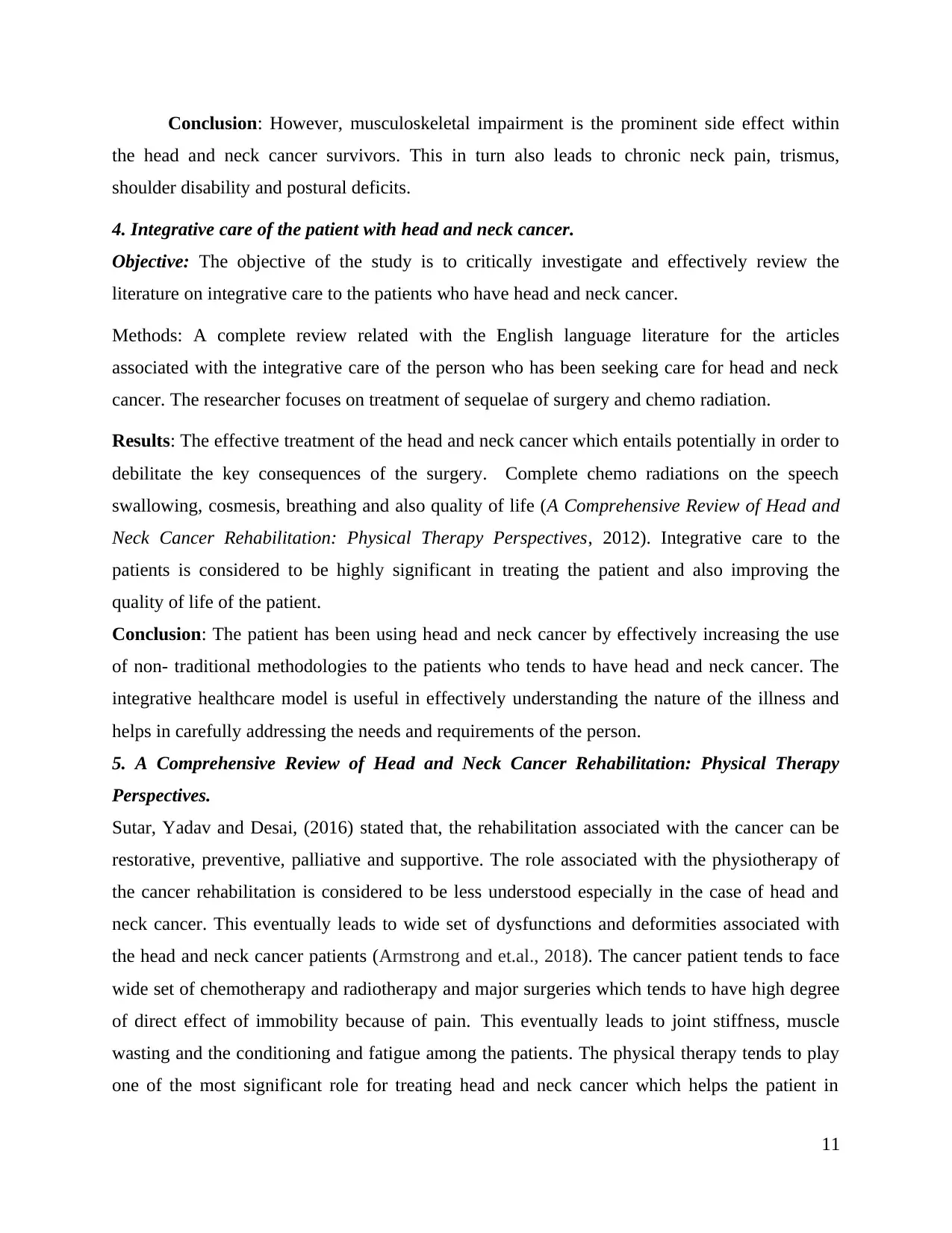
Conclusion: However, musculoskeletal impairment is the prominent side effect within
the head and neck cancer survivors. This in turn also leads to chronic neck pain, trismus,
shoulder disability and postural deficits.
4. Integrative care of the patient with head and neck cancer.
Objective: The objective of the study is to critically investigate and effectively review the
literature on integrative care to the patients who have head and neck cancer.
Methods: A complete review related with the English language literature for the articles
associated with the integrative care of the person who has been seeking care for head and neck
cancer. The researcher focuses on treatment of sequelae of surgery and chemo radiation.
Results: The effective treatment of the head and neck cancer which entails potentially in order to
debilitate the key consequences of the surgery. Complete chemo radiations on the speech
swallowing, cosmesis, breathing and also quality of life (A Comprehensive Review of Head and
Neck Cancer Rehabilitation: Physical Therapy Perspectives, 2012). Integrative care to the
patients is considered to be highly significant in treating the patient and also improving the
quality of life of the patient.
Conclusion: The patient has been using head and neck cancer by effectively increasing the use
of non- traditional methodologies to the patients who tends to have head and neck cancer. The
integrative healthcare model is useful in effectively understanding the nature of the illness and
helps in carefully addressing the needs and requirements of the person.
5. A Comprehensive Review of Head and Neck Cancer Rehabilitation: Physical Therapy
Perspectives.
Sutar, Yadav and Desai, (2016) stated that, the rehabilitation associated with the cancer can be
restorative, preventive, palliative and supportive. The role associated with the physiotherapy of
the cancer rehabilitation is considered to be less understood especially in the case of head and
neck cancer. This eventually leads to wide set of dysfunctions and deformities associated with
the head and neck cancer patients (Armstrong and et.al., 2018). The cancer patient tends to face
wide set of chemotherapy and radiotherapy and major surgeries which tends to have high degree
of direct effect of immobility because of pain. This eventually leads to joint stiffness, muscle
wasting and the conditioning and fatigue among the patients. The physical therapy tends to play
one of the most significant role for treating head and neck cancer which helps the patient in
11
the head and neck cancer survivors. This in turn also leads to chronic neck pain, trismus,
shoulder disability and postural deficits.
4. Integrative care of the patient with head and neck cancer.
Objective: The objective of the study is to critically investigate and effectively review the
literature on integrative care to the patients who have head and neck cancer.
Methods: A complete review related with the English language literature for the articles
associated with the integrative care of the person who has been seeking care for head and neck
cancer. The researcher focuses on treatment of sequelae of surgery and chemo radiation.
Results: The effective treatment of the head and neck cancer which entails potentially in order to
debilitate the key consequences of the surgery. Complete chemo radiations on the speech
swallowing, cosmesis, breathing and also quality of life (A Comprehensive Review of Head and
Neck Cancer Rehabilitation: Physical Therapy Perspectives, 2012). Integrative care to the
patients is considered to be highly significant in treating the patient and also improving the
quality of life of the patient.
Conclusion: The patient has been using head and neck cancer by effectively increasing the use
of non- traditional methodologies to the patients who tends to have head and neck cancer. The
integrative healthcare model is useful in effectively understanding the nature of the illness and
helps in carefully addressing the needs and requirements of the person.
5. A Comprehensive Review of Head and Neck Cancer Rehabilitation: Physical Therapy
Perspectives.
Sutar, Yadav and Desai, (2016) stated that, the rehabilitation associated with the cancer can be
restorative, preventive, palliative and supportive. The role associated with the physiotherapy of
the cancer rehabilitation is considered to be less understood especially in the case of head and
neck cancer. This eventually leads to wide set of dysfunctions and deformities associated with
the head and neck cancer patients (Armstrong and et.al., 2018). The cancer patient tends to face
wide set of chemotherapy and radiotherapy and major surgeries which tends to have high degree
of direct effect of immobility because of pain. This eventually leads to joint stiffness, muscle
wasting and the conditioning and fatigue among the patients. The physical therapy tends to play
one of the most significant role for treating head and neck cancer which helps the patient in
11
Paraphrase This Document
Need a fresh take? Get an instant paraphrase of this document with our AI Paraphraser
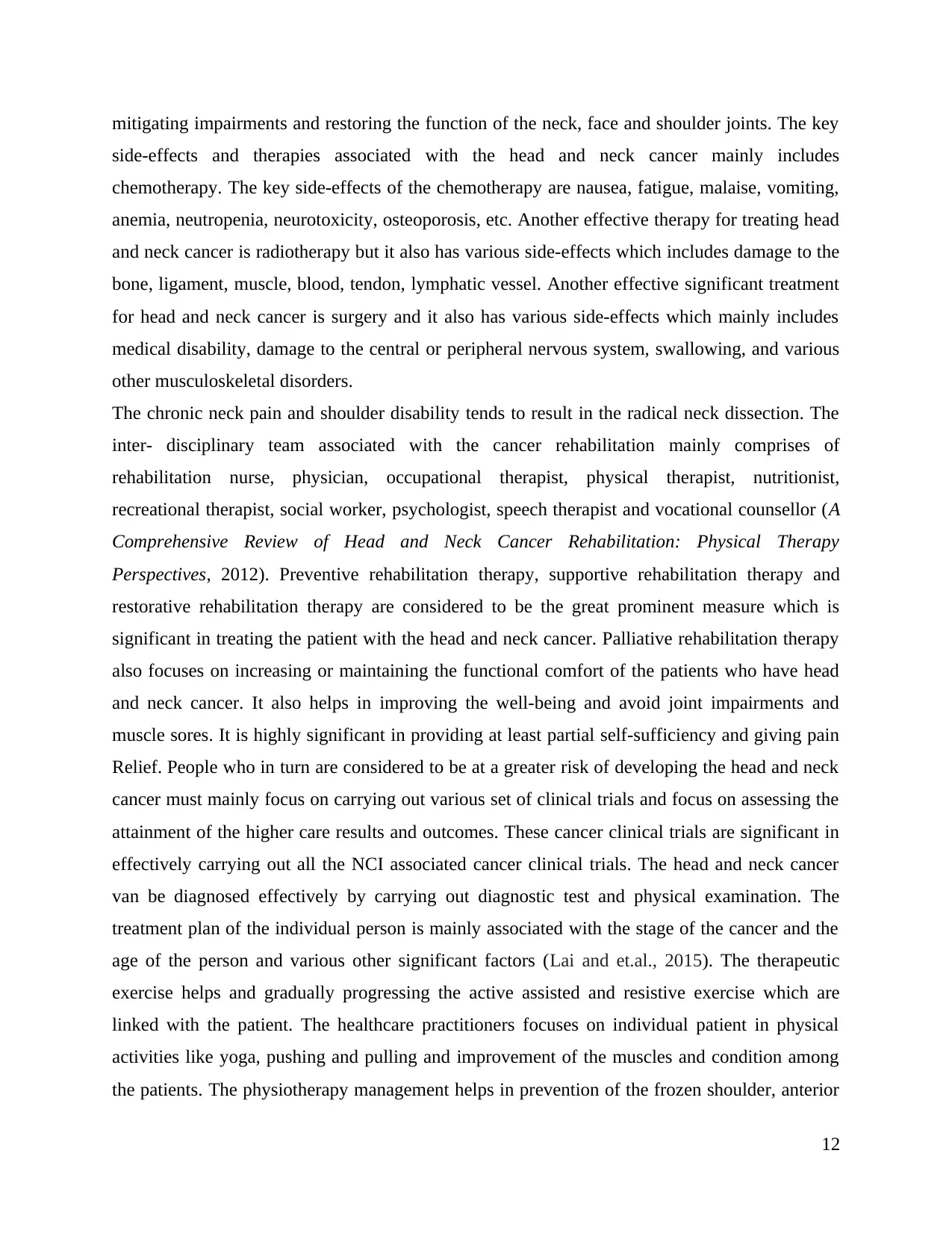
mitigating impairments and restoring the function of the neck, face and shoulder joints. The key
side-effects and therapies associated with the head and neck cancer mainly includes
chemotherapy. The key side-effects of the chemotherapy are nausea, fatigue, malaise, vomiting,
anemia, neutropenia, neurotoxicity, osteoporosis, etc. Another effective therapy for treating head
and neck cancer is radiotherapy but it also has various side-effects which includes damage to the
bone, ligament, muscle, blood, tendon, lymphatic vessel. Another effective significant treatment
for head and neck cancer is surgery and it also has various side-effects which mainly includes
medical disability, damage to the central or peripheral nervous system, swallowing, and various
other musculoskeletal disorders.
The chronic neck pain and shoulder disability tends to result in the radical neck dissection. The
inter- disciplinary team associated with the cancer rehabilitation mainly comprises of
rehabilitation nurse, physician, occupational therapist, physical therapist, nutritionist,
recreational therapist, social worker, psychologist, speech therapist and vocational counsellor (A
Comprehensive Review of Head and Neck Cancer Rehabilitation: Physical Therapy
Perspectives, 2012). Preventive rehabilitation therapy, supportive rehabilitation therapy and
restorative rehabilitation therapy are considered to be the great prominent measure which is
significant in treating the patient with the head and neck cancer. Palliative rehabilitation therapy
also focuses on increasing or maintaining the functional comfort of the patients who have head
and neck cancer. It also helps in improving the well-being and avoid joint impairments and
muscle sores. It is highly significant in providing at least partial self-sufficiency and giving pain
Relief. People who in turn are considered to be at a greater risk of developing the head and neck
cancer must mainly focus on carrying out various set of clinical trials and focus on assessing the
attainment of the higher care results and outcomes. These cancer clinical trials are significant in
effectively carrying out all the NCI associated cancer clinical trials. The head and neck cancer
van be diagnosed effectively by carrying out diagnostic test and physical examination. The
treatment plan of the individual person is mainly associated with the stage of the cancer and the
age of the person and various other significant factors (Lai and et.al., 2015). The therapeutic
exercise helps and gradually progressing the active assisted and resistive exercise which are
linked with the patient. The healthcare practitioners focuses on individual patient in physical
activities like yoga, pushing and pulling and improvement of the muscles and condition among
the patients. The physiotherapy management helps in prevention of the frozen shoulder, anterior
12
side-effects and therapies associated with the head and neck cancer mainly includes
chemotherapy. The key side-effects of the chemotherapy are nausea, fatigue, malaise, vomiting,
anemia, neutropenia, neurotoxicity, osteoporosis, etc. Another effective therapy for treating head
and neck cancer is radiotherapy but it also has various side-effects which includes damage to the
bone, ligament, muscle, blood, tendon, lymphatic vessel. Another effective significant treatment
for head and neck cancer is surgery and it also has various side-effects which mainly includes
medical disability, damage to the central or peripheral nervous system, swallowing, and various
other musculoskeletal disorders.
The chronic neck pain and shoulder disability tends to result in the radical neck dissection. The
inter- disciplinary team associated with the cancer rehabilitation mainly comprises of
rehabilitation nurse, physician, occupational therapist, physical therapist, nutritionist,
recreational therapist, social worker, psychologist, speech therapist and vocational counsellor (A
Comprehensive Review of Head and Neck Cancer Rehabilitation: Physical Therapy
Perspectives, 2012). Preventive rehabilitation therapy, supportive rehabilitation therapy and
restorative rehabilitation therapy are considered to be the great prominent measure which is
significant in treating the patient with the head and neck cancer. Palliative rehabilitation therapy
also focuses on increasing or maintaining the functional comfort of the patients who have head
and neck cancer. It also helps in improving the well-being and avoid joint impairments and
muscle sores. It is highly significant in providing at least partial self-sufficiency and giving pain
Relief. People who in turn are considered to be at a greater risk of developing the head and neck
cancer must mainly focus on carrying out various set of clinical trials and focus on assessing the
attainment of the higher care results and outcomes. These cancer clinical trials are significant in
effectively carrying out all the NCI associated cancer clinical trials. The head and neck cancer
van be diagnosed effectively by carrying out diagnostic test and physical examination. The
treatment plan of the individual person is mainly associated with the stage of the cancer and the
age of the person and various other significant factors (Lai and et.al., 2015). The therapeutic
exercise helps and gradually progressing the active assisted and resistive exercise which are
linked with the patient. The healthcare practitioners focuses on individual patient in physical
activities like yoga, pushing and pulling and improvement of the muscles and condition among
the patients. The physiotherapy management helps in prevention of the frozen shoulder, anterior
12
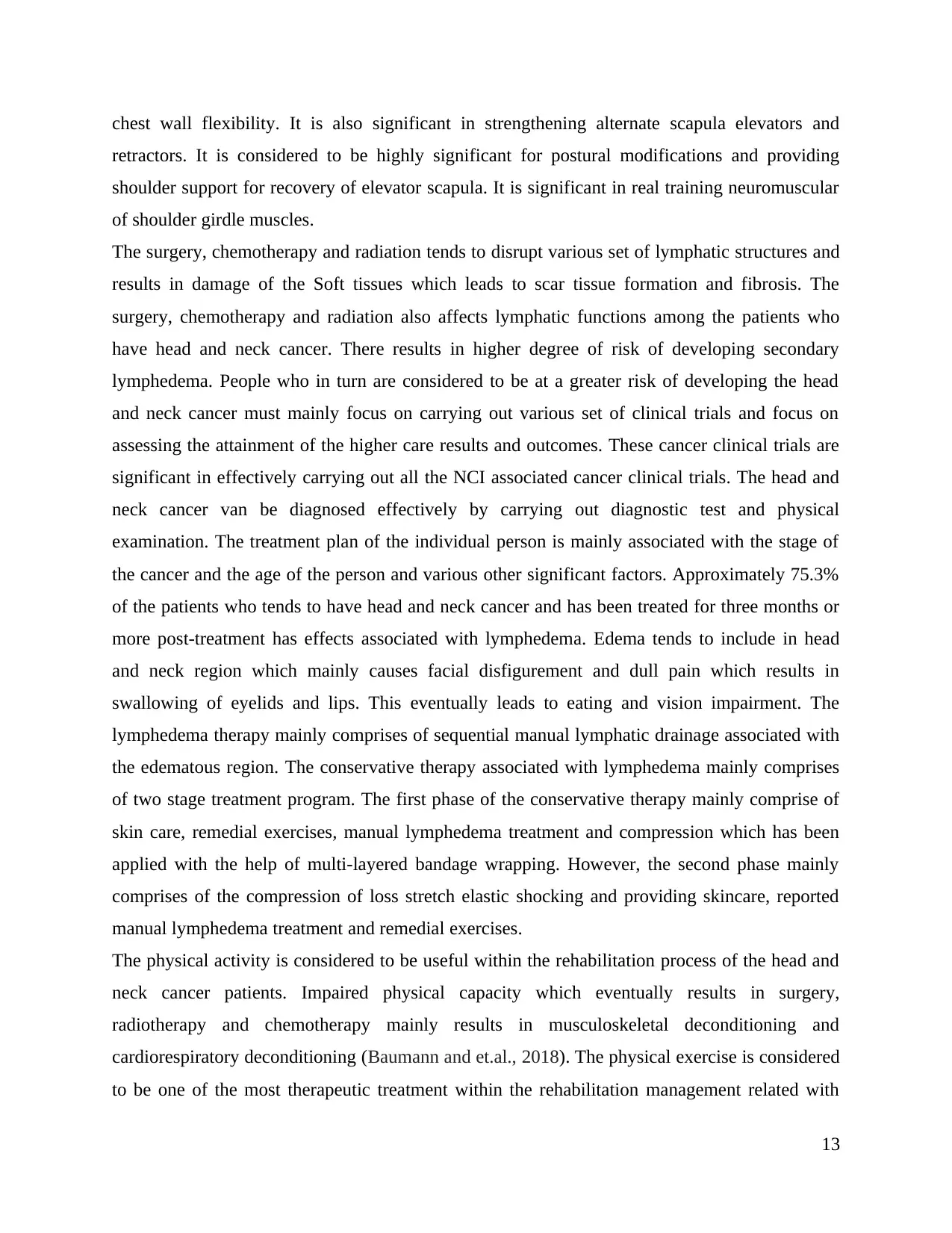
chest wall flexibility. It is also significant in strengthening alternate scapula elevators and
retractors. It is considered to be highly significant for postural modifications and providing
shoulder support for recovery of elevator scapula. It is significant in real training neuromuscular
of shoulder girdle muscles.
The surgery, chemotherapy and radiation tends to disrupt various set of lymphatic structures and
results in damage of the Soft tissues which leads to scar tissue formation and fibrosis. The
surgery, chemotherapy and radiation also affects lymphatic functions among the patients who
have head and neck cancer. There results in higher degree of risk of developing secondary
lymphedema. People who in turn are considered to be at a greater risk of developing the head
and neck cancer must mainly focus on carrying out various set of clinical trials and focus on
assessing the attainment of the higher care results and outcomes. These cancer clinical trials are
significant in effectively carrying out all the NCI associated cancer clinical trials. The head and
neck cancer van be diagnosed effectively by carrying out diagnostic test and physical
examination. The treatment plan of the individual person is mainly associated with the stage of
the cancer and the age of the person and various other significant factors. Approximately 75.3%
of the patients who tends to have head and neck cancer and has been treated for three months or
more post-treatment has effects associated with lymphedema. Edema tends to include in head
and neck region which mainly causes facial disfigurement and dull pain which results in
swallowing of eyelids and lips. This eventually leads to eating and vision impairment. The
lymphedema therapy mainly comprises of sequential manual lymphatic drainage associated with
the edematous region. The conservative therapy associated with lymphedema mainly comprises
of two stage treatment program. The first phase of the conservative therapy mainly comprise of
skin care, remedial exercises, manual lymphedema treatment and compression which has been
applied with the help of multi-layered bandage wrapping. However, the second phase mainly
comprises of the compression of loss stretch elastic shocking and providing skincare, reported
manual lymphedema treatment and remedial exercises.
The physical activity is considered to be useful within the rehabilitation process of the head and
neck cancer patients. Impaired physical capacity which eventually results in surgery,
radiotherapy and chemotherapy mainly results in musculoskeletal deconditioning and
cardiorespiratory deconditioning (Baumann and et.al., 2018). The physical exercise is considered
to be one of the most therapeutic treatment within the rehabilitation management related with
13
retractors. It is considered to be highly significant for postural modifications and providing
shoulder support for recovery of elevator scapula. It is significant in real training neuromuscular
of shoulder girdle muscles.
The surgery, chemotherapy and radiation tends to disrupt various set of lymphatic structures and
results in damage of the Soft tissues which leads to scar tissue formation and fibrosis. The
surgery, chemotherapy and radiation also affects lymphatic functions among the patients who
have head and neck cancer. There results in higher degree of risk of developing secondary
lymphedema. People who in turn are considered to be at a greater risk of developing the head
and neck cancer must mainly focus on carrying out various set of clinical trials and focus on
assessing the attainment of the higher care results and outcomes. These cancer clinical trials are
significant in effectively carrying out all the NCI associated cancer clinical trials. The head and
neck cancer van be diagnosed effectively by carrying out diagnostic test and physical
examination. The treatment plan of the individual person is mainly associated with the stage of
the cancer and the age of the person and various other significant factors. Approximately 75.3%
of the patients who tends to have head and neck cancer and has been treated for three months or
more post-treatment has effects associated with lymphedema. Edema tends to include in head
and neck region which mainly causes facial disfigurement and dull pain which results in
swallowing of eyelids and lips. This eventually leads to eating and vision impairment. The
lymphedema therapy mainly comprises of sequential manual lymphatic drainage associated with
the edematous region. The conservative therapy associated with lymphedema mainly comprises
of two stage treatment program. The first phase of the conservative therapy mainly comprise of
skin care, remedial exercises, manual lymphedema treatment and compression which has been
applied with the help of multi-layered bandage wrapping. However, the second phase mainly
comprises of the compression of loss stretch elastic shocking and providing skincare, reported
manual lymphedema treatment and remedial exercises.
The physical activity is considered to be useful within the rehabilitation process of the head and
neck cancer patients. Impaired physical capacity which eventually results in surgery,
radiotherapy and chemotherapy mainly results in musculoskeletal deconditioning and
cardiorespiratory deconditioning (Baumann and et.al., 2018). The physical exercise is considered
to be one of the most therapeutic treatment within the rehabilitation management related with
13
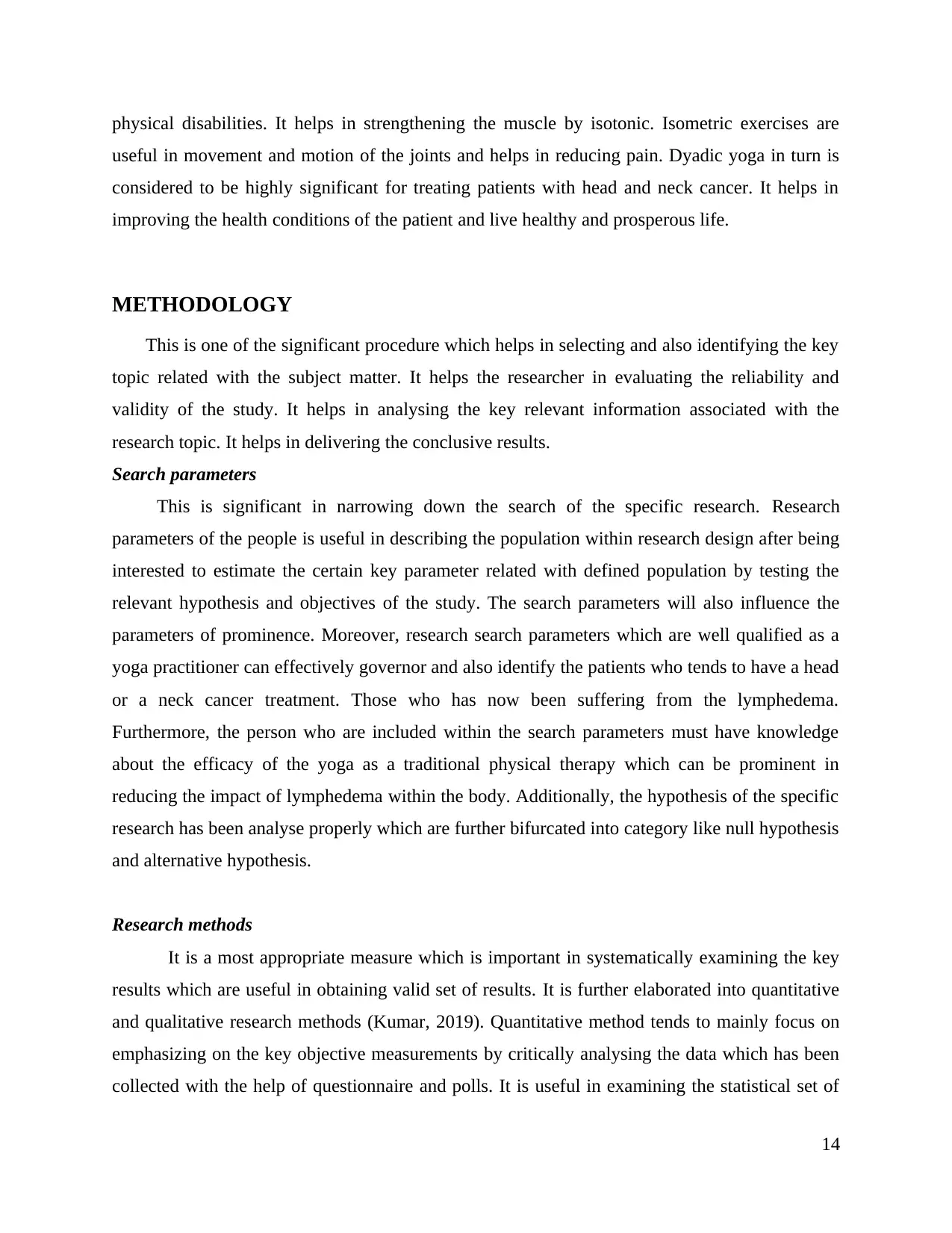
physical disabilities. It helps in strengthening the muscle by isotonic. Isometric exercises are
useful in movement and motion of the joints and helps in reducing pain. Dyadic yoga in turn is
considered to be highly significant for treating patients with head and neck cancer. It helps in
improving the health conditions of the patient and live healthy and prosperous life.
METHODOLOGY
This is one of the significant procedure which helps in selecting and also identifying the key
topic related with the subject matter. It helps the researcher in evaluating the reliability and
validity of the study. It helps in analysing the key relevant information associated with the
research topic. It helps in delivering the conclusive results.
Search parameters
This is significant in narrowing down the search of the specific research. Research
parameters of the people is useful in describing the population within research design after being
interested to estimate the certain key parameter related with defined population by testing the
relevant hypothesis and objectives of the study. The search parameters will also influence the
parameters of prominence. Moreover, research search parameters which are well qualified as a
yoga practitioner can effectively governor and also identify the patients who tends to have a head
or a neck cancer treatment. Those who has now been suffering from the lymphedema.
Furthermore, the person who are included within the search parameters must have knowledge
about the efficacy of the yoga as a traditional physical therapy which can be prominent in
reducing the impact of lymphedema within the body. Additionally, the hypothesis of the specific
research has been analyse properly which are further bifurcated into category like null hypothesis
and alternative hypothesis.
Research methods
It is a most appropriate measure which is important in systematically examining the key
results which are useful in obtaining valid set of results. It is further elaborated into quantitative
and qualitative research methods (Kumar, 2019). Quantitative method tends to mainly focus on
emphasizing on the key objective measurements by critically analysing the data which has been
collected with the help of questionnaire and polls. It is useful in examining the statistical set of
14
useful in movement and motion of the joints and helps in reducing pain. Dyadic yoga in turn is
considered to be highly significant for treating patients with head and neck cancer. It helps in
improving the health conditions of the patient and live healthy and prosperous life.
METHODOLOGY
This is one of the significant procedure which helps in selecting and also identifying the key
topic related with the subject matter. It helps the researcher in evaluating the reliability and
validity of the study. It helps in analysing the key relevant information associated with the
research topic. It helps in delivering the conclusive results.
Search parameters
This is significant in narrowing down the search of the specific research. Research
parameters of the people is useful in describing the population within research design after being
interested to estimate the certain key parameter related with defined population by testing the
relevant hypothesis and objectives of the study. The search parameters will also influence the
parameters of prominence. Moreover, research search parameters which are well qualified as a
yoga practitioner can effectively governor and also identify the patients who tends to have a head
or a neck cancer treatment. Those who has now been suffering from the lymphedema.
Furthermore, the person who are included within the search parameters must have knowledge
about the efficacy of the yoga as a traditional physical therapy which can be prominent in
reducing the impact of lymphedema within the body. Additionally, the hypothesis of the specific
research has been analyse properly which are further bifurcated into category like null hypothesis
and alternative hypothesis.
Research methods
It is a most appropriate measure which is important in systematically examining the key
results which are useful in obtaining valid set of results. It is further elaborated into quantitative
and qualitative research methods (Kumar, 2019). Quantitative method tends to mainly focus on
emphasizing on the key objective measurements by critically analysing the data which has been
collected with the help of questionnaire and polls. It is useful in examining the statistical set of
14
Secure Best Marks with AI Grader
Need help grading? Try our AI Grader for instant feedback on your assignments.
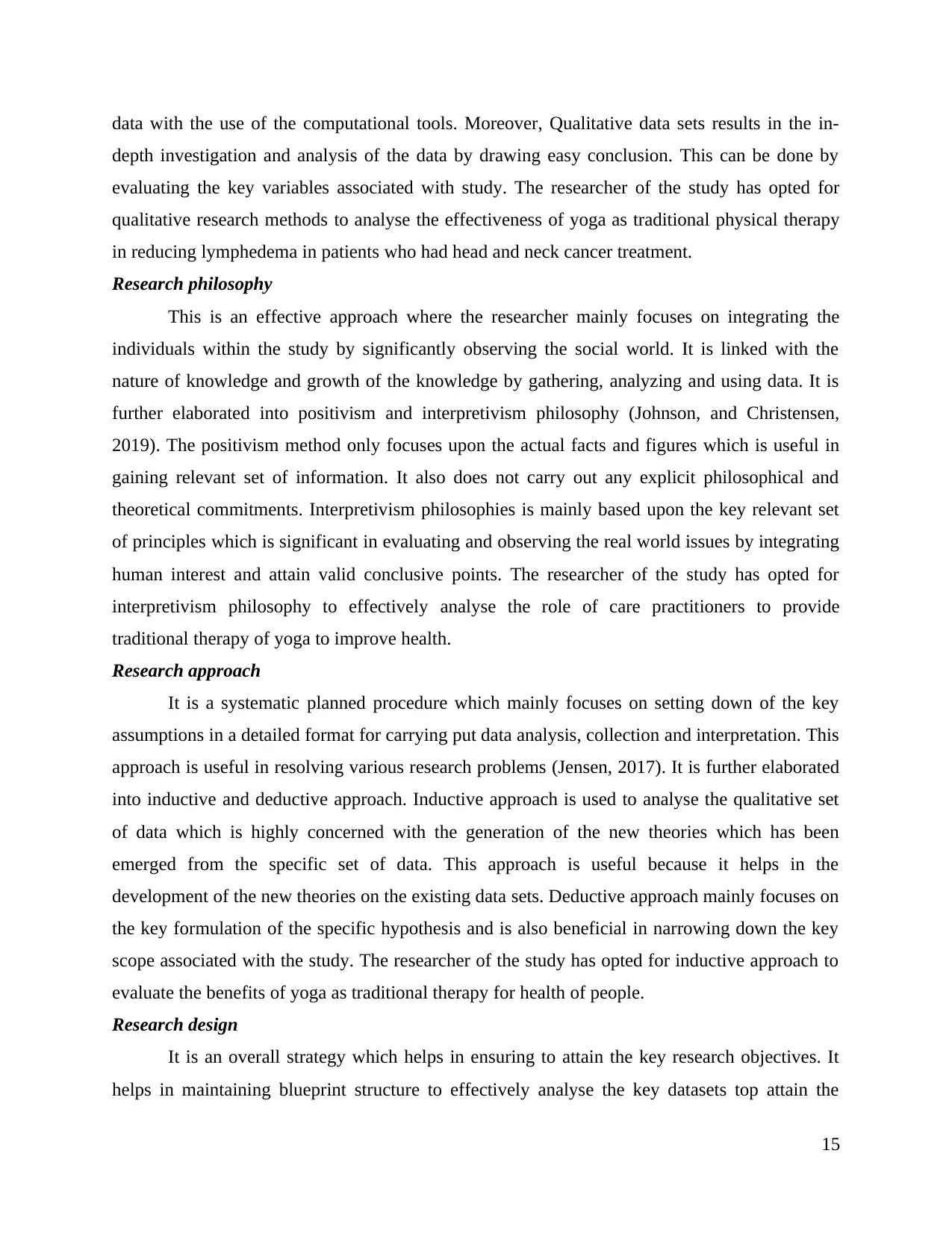
data with the use of the computational tools. Moreover, Qualitative data sets results in the in-
depth investigation and analysis of the data by drawing easy conclusion. This can be done by
evaluating the key variables associated with study. The researcher of the study has opted for
qualitative research methods to analyse the effectiveness of yoga as traditional physical therapy
in reducing lymphedema in patients who had head and neck cancer treatment.
Research philosophy
This is an effective approach where the researcher mainly focuses on integrating the
individuals within the study by significantly observing the social world. It is linked with the
nature of knowledge and growth of the knowledge by gathering, analyzing and using data. It is
further elaborated into positivism and interpretivism philosophy (Johnson, and Christensen,
2019). The positivism method only focuses upon the actual facts and figures which is useful in
gaining relevant set of information. It also does not carry out any explicit philosophical and
theoretical commitments. Interpretivism philosophies is mainly based upon the key relevant set
of principles which is significant in evaluating and observing the real world issues by integrating
human interest and attain valid conclusive points. The researcher of the study has opted for
interpretivism philosophy to effectively analyse the role of care practitioners to provide
traditional therapy of yoga to improve health.
Research approach
It is a systematic planned procedure which mainly focuses on setting down of the key
assumptions in a detailed format for carrying put data analysis, collection and interpretation. This
approach is useful in resolving various research problems (Jensen, 2017). It is further elaborated
into inductive and deductive approach. Inductive approach is used to analyse the qualitative set
of data which is highly concerned with the generation of the new theories which has been
emerged from the specific set of data. This approach is useful because it helps in the
development of the new theories on the existing data sets. Deductive approach mainly focuses on
the key formulation of the specific hypothesis and is also beneficial in narrowing down the key
scope associated with the study. The researcher of the study has opted for inductive approach to
evaluate the benefits of yoga as traditional therapy for health of people.
Research design
It is an overall strategy which helps in ensuring to attain the key research objectives. It
helps in maintaining blueprint structure to effectively analyse the key datasets top attain the
15
depth investigation and analysis of the data by drawing easy conclusion. This can be done by
evaluating the key variables associated with study. The researcher of the study has opted for
qualitative research methods to analyse the effectiveness of yoga as traditional physical therapy
in reducing lymphedema in patients who had head and neck cancer treatment.
Research philosophy
This is an effective approach where the researcher mainly focuses on integrating the
individuals within the study by significantly observing the social world. It is linked with the
nature of knowledge and growth of the knowledge by gathering, analyzing and using data. It is
further elaborated into positivism and interpretivism philosophy (Johnson, and Christensen,
2019). The positivism method only focuses upon the actual facts and figures which is useful in
gaining relevant set of information. It also does not carry out any explicit philosophical and
theoretical commitments. Interpretivism philosophies is mainly based upon the key relevant set
of principles which is significant in evaluating and observing the real world issues by integrating
human interest and attain valid conclusive points. The researcher of the study has opted for
interpretivism philosophy to effectively analyse the role of care practitioners to provide
traditional therapy of yoga to improve health.
Research approach
It is a systematic planned procedure which mainly focuses on setting down of the key
assumptions in a detailed format for carrying put data analysis, collection and interpretation. This
approach is useful in resolving various research problems (Jensen, 2017). It is further elaborated
into inductive and deductive approach. Inductive approach is used to analyse the qualitative set
of data which is highly concerned with the generation of the new theories which has been
emerged from the specific set of data. This approach is useful because it helps in the
development of the new theories on the existing data sets. Deductive approach mainly focuses on
the key formulation of the specific hypothesis and is also beneficial in narrowing down the key
scope associated with the study. The researcher of the study has opted for inductive approach to
evaluate the benefits of yoga as traditional therapy for health of people.
Research design
It is an overall strategy which helps in ensuring to attain the key research objectives. It
helps in maintaining blueprint structure to effectively analyse the key datasets top attain the
15
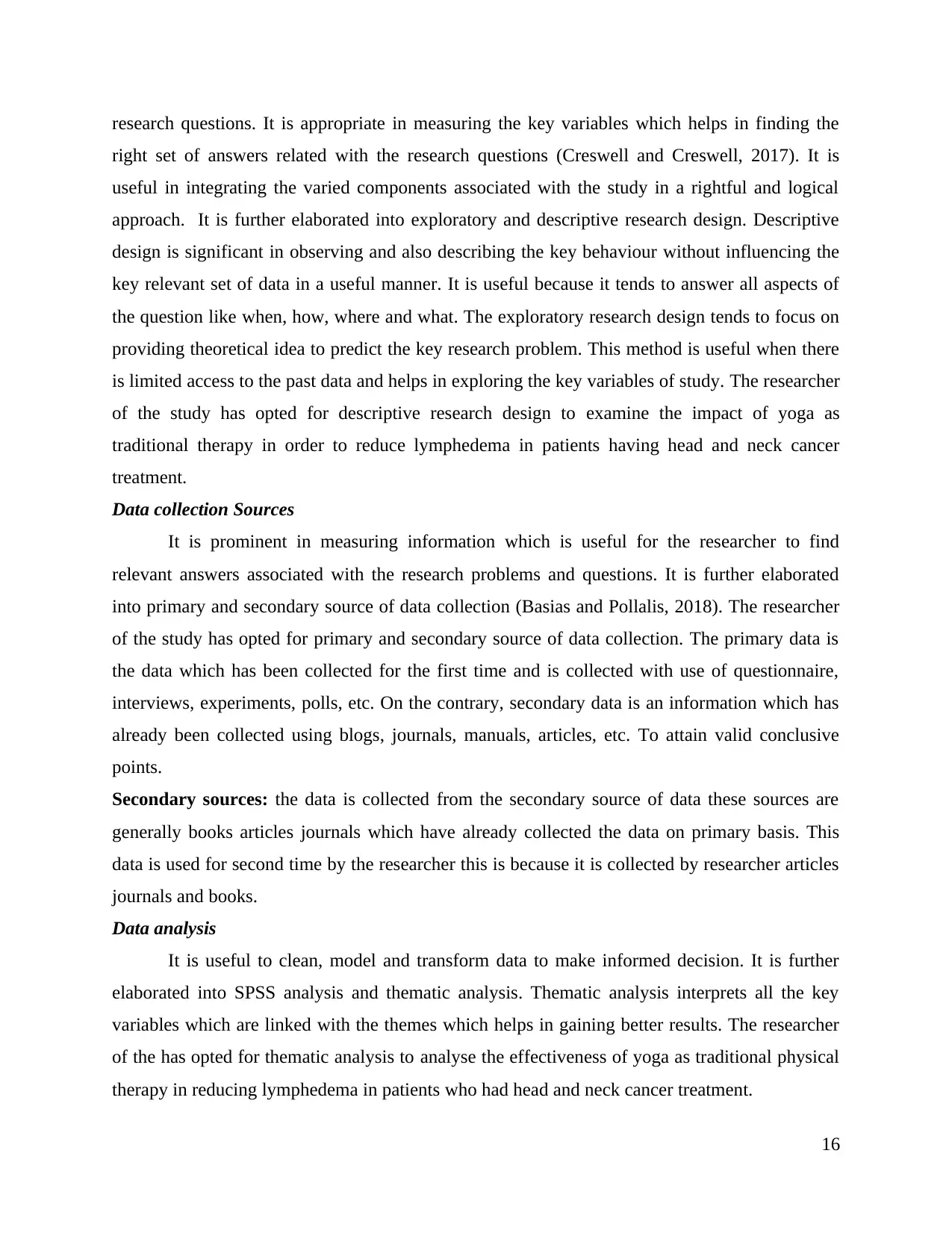
research questions. It is appropriate in measuring the key variables which helps in finding the
right set of answers related with the research questions (Creswell and Creswell, 2017). It is
useful in integrating the varied components associated with the study in a rightful and logical
approach. It is further elaborated into exploratory and descriptive research design. Descriptive
design is significant in observing and also describing the key behaviour without influencing the
key relevant set of data in a useful manner. It is useful because it tends to answer all aspects of
the question like when, how, where and what. The exploratory research design tends to focus on
providing theoretical idea to predict the key research problem. This method is useful when there
is limited access to the past data and helps in exploring the key variables of study. The researcher
of the study has opted for descriptive research design to examine the impact of yoga as
traditional therapy in order to reduce lymphedema in patients having head and neck cancer
treatment.
Data collection Sources
It is prominent in measuring information which is useful for the researcher to find
relevant answers associated with the research problems and questions. It is further elaborated
into primary and secondary source of data collection (Basias and Pollalis, 2018). The researcher
of the study has opted for primary and secondary source of data collection. The primary data is
the data which has been collected for the first time and is collected with use of questionnaire,
interviews, experiments, polls, etc. On the contrary, secondary data is an information which has
already been collected using blogs, journals, manuals, articles, etc. To attain valid conclusive
points.
Secondary sources: the data is collected from the secondary source of data these sources are
generally books articles journals which have already collected the data on primary basis. This
data is used for second time by the researcher this is because it is collected by researcher articles
journals and books.
Data analysis
It is useful to clean, model and transform data to make informed decision. It is further
elaborated into SPSS analysis and thematic analysis. Thematic analysis interprets all the key
variables which are linked with the themes which helps in gaining better results. The researcher
of the has opted for thematic analysis to analyse the effectiveness of yoga as traditional physical
therapy in reducing lymphedema in patients who had head and neck cancer treatment.
16
right set of answers related with the research questions (Creswell and Creswell, 2017). It is
useful in integrating the varied components associated with the study in a rightful and logical
approach. It is further elaborated into exploratory and descriptive research design. Descriptive
design is significant in observing and also describing the key behaviour without influencing the
key relevant set of data in a useful manner. It is useful because it tends to answer all aspects of
the question like when, how, where and what. The exploratory research design tends to focus on
providing theoretical idea to predict the key research problem. This method is useful when there
is limited access to the past data and helps in exploring the key variables of study. The researcher
of the study has opted for descriptive research design to examine the impact of yoga as
traditional therapy in order to reduce lymphedema in patients having head and neck cancer
treatment.
Data collection Sources
It is prominent in measuring information which is useful for the researcher to find
relevant answers associated with the research problems and questions. It is further elaborated
into primary and secondary source of data collection (Basias and Pollalis, 2018). The researcher
of the study has opted for primary and secondary source of data collection. The primary data is
the data which has been collected for the first time and is collected with use of questionnaire,
interviews, experiments, polls, etc. On the contrary, secondary data is an information which has
already been collected using blogs, journals, manuals, articles, etc. To attain valid conclusive
points.
Secondary sources: the data is collected from the secondary source of data these sources are
generally books articles journals which have already collected the data on primary basis. This
data is used for second time by the researcher this is because it is collected by researcher articles
journals and books.
Data analysis
It is useful to clean, model and transform data to make informed decision. It is further
elaborated into SPSS analysis and thematic analysis. Thematic analysis interprets all the key
variables which are linked with the themes which helps in gaining better results. The researcher
of the has opted for thematic analysis to analyse the effectiveness of yoga as traditional physical
therapy in reducing lymphedema in patients who had head and neck cancer treatment.
16
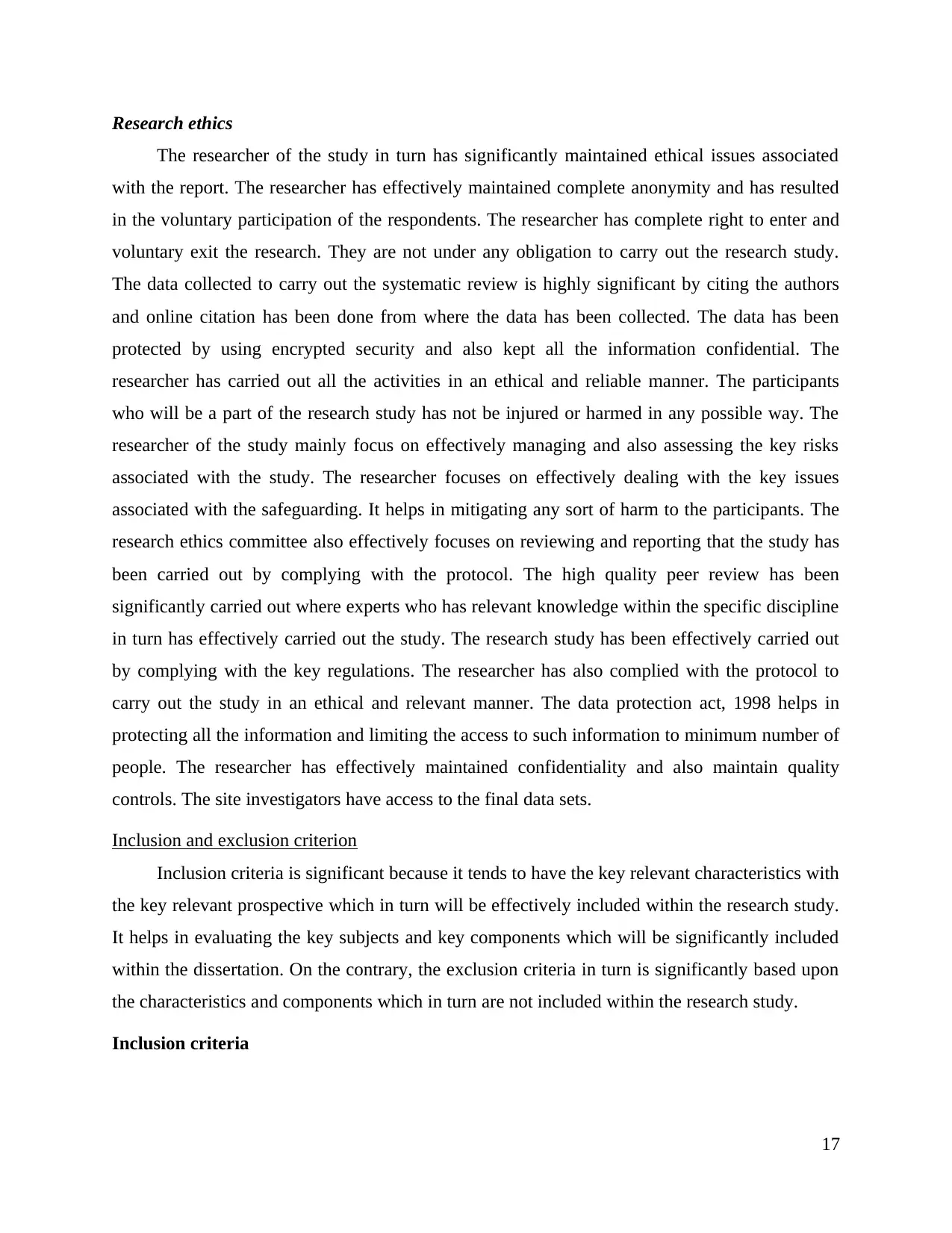
Research ethics
The researcher of the study in turn has significantly maintained ethical issues associated
with the report. The researcher has effectively maintained complete anonymity and has resulted
in the voluntary participation of the respondents. The researcher has complete right to enter and
voluntary exit the research. They are not under any obligation to carry out the research study.
The data collected to carry out the systematic review is highly significant by citing the authors
and online citation has been done from where the data has been collected. The data has been
protected by using encrypted security and also kept all the information confidential. The
researcher has carried out all the activities in an ethical and reliable manner. The participants
who will be a part of the research study has not be injured or harmed in any possible way. The
researcher of the study mainly focus on effectively managing and also assessing the key risks
associated with the study. The researcher focuses on effectively dealing with the key issues
associated with the safeguarding. It helps in mitigating any sort of harm to the participants. The
research ethics committee also effectively focuses on reviewing and reporting that the study has
been carried out by complying with the protocol. The high quality peer review has been
significantly carried out where experts who has relevant knowledge within the specific discipline
in turn has effectively carried out the study. The research study has been effectively carried out
by complying with the key regulations. The researcher has also complied with the protocol to
carry out the study in an ethical and relevant manner. The data protection act, 1998 helps in
protecting all the information and limiting the access to such information to minimum number of
people. The researcher has effectively maintained confidentiality and also maintain quality
controls. The site investigators have access to the final data sets.
Inclusion and exclusion criterion
Inclusion criteria is significant because it tends to have the key relevant characteristics with
the key relevant prospective which in turn will be effectively included within the research study.
It helps in evaluating the key subjects and key components which will be significantly included
within the dissertation. On the contrary, the exclusion criteria in turn is significantly based upon
the characteristics and components which in turn are not included within the research study.
Inclusion criteria
17
The researcher of the study in turn has significantly maintained ethical issues associated
with the report. The researcher has effectively maintained complete anonymity and has resulted
in the voluntary participation of the respondents. The researcher has complete right to enter and
voluntary exit the research. They are not under any obligation to carry out the research study.
The data collected to carry out the systematic review is highly significant by citing the authors
and online citation has been done from where the data has been collected. The data has been
protected by using encrypted security and also kept all the information confidential. The
researcher has carried out all the activities in an ethical and reliable manner. The participants
who will be a part of the research study has not be injured or harmed in any possible way. The
researcher of the study mainly focus on effectively managing and also assessing the key risks
associated with the study. The researcher focuses on effectively dealing with the key issues
associated with the safeguarding. It helps in mitigating any sort of harm to the participants. The
research ethics committee also effectively focuses on reviewing and reporting that the study has
been carried out by complying with the protocol. The high quality peer review has been
significantly carried out where experts who has relevant knowledge within the specific discipline
in turn has effectively carried out the study. The research study has been effectively carried out
by complying with the key regulations. The researcher has also complied with the protocol to
carry out the study in an ethical and relevant manner. The data protection act, 1998 helps in
protecting all the information and limiting the access to such information to minimum number of
people. The researcher has effectively maintained confidentiality and also maintain quality
controls. The site investigators have access to the final data sets.
Inclusion and exclusion criterion
Inclusion criteria is significant because it tends to have the key relevant characteristics with
the key relevant prospective which in turn will be effectively included within the research study.
It helps in evaluating the key subjects and key components which will be significantly included
within the dissertation. On the contrary, the exclusion criteria in turn is significantly based upon
the characteristics and components which in turn are not included within the research study.
Inclusion criteria
17
Paraphrase This Document
Need a fresh take? Get an instant paraphrase of this document with our AI Paraphraser
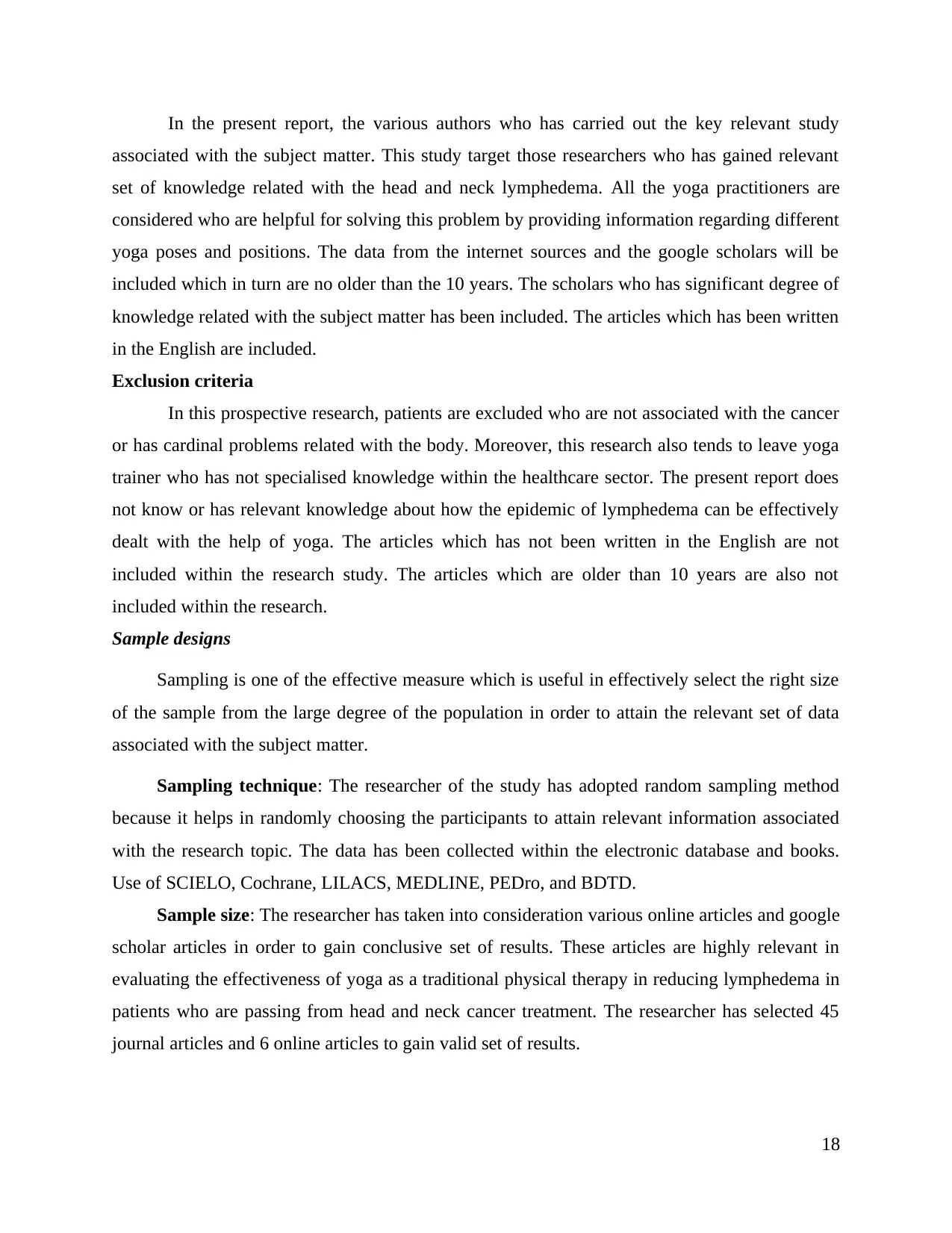
In the present report, the various authors who has carried out the key relevant study
associated with the subject matter. This study target those researchers who has gained relevant
set of knowledge related with the head and neck lymphedema. All the yoga practitioners are
considered who are helpful for solving this problem by providing information regarding different
yoga poses and positions. The data from the internet sources and the google scholars will be
included which in turn are no older than the 10 years. The scholars who has significant degree of
knowledge related with the subject matter has been included. The articles which has been written
in the English are included.
Exclusion criteria
In this prospective research, patients are excluded who are not associated with the cancer
or has cardinal problems related with the body. Moreover, this research also tends to leave yoga
trainer who has not specialised knowledge within the healthcare sector. The present report does
not know or has relevant knowledge about how the epidemic of lymphedema can be effectively
dealt with the help of yoga. The articles which has not been written in the English are not
included within the research study. The articles which are older than 10 years are also not
included within the research.
Sample designs
Sampling is one of the effective measure which is useful in effectively select the right size
of the sample from the large degree of the population in order to attain the relevant set of data
associated with the subject matter.
Sampling technique: The researcher of the study has adopted random sampling method
because it helps in randomly choosing the participants to attain relevant information associated
with the research topic. The data has been collected within the electronic database and books.
Use of SCIELO, Cochrane, LILACS, MEDLINE, PEDro, and BDTD.
Sample size: The researcher has taken into consideration various online articles and google
scholar articles in order to gain conclusive set of results. These articles are highly relevant in
evaluating the effectiveness of yoga as a traditional physical therapy in reducing lymphedema in
patients who are passing from head and neck cancer treatment. The researcher has selected 45
journal articles and 6 online articles to gain valid set of results.
18
associated with the subject matter. This study target those researchers who has gained relevant
set of knowledge related with the head and neck lymphedema. All the yoga practitioners are
considered who are helpful for solving this problem by providing information regarding different
yoga poses and positions. The data from the internet sources and the google scholars will be
included which in turn are no older than the 10 years. The scholars who has significant degree of
knowledge related with the subject matter has been included. The articles which has been written
in the English are included.
Exclusion criteria
In this prospective research, patients are excluded who are not associated with the cancer
or has cardinal problems related with the body. Moreover, this research also tends to leave yoga
trainer who has not specialised knowledge within the healthcare sector. The present report does
not know or has relevant knowledge about how the epidemic of lymphedema can be effectively
dealt with the help of yoga. The articles which has not been written in the English are not
included within the research study. The articles which are older than 10 years are also not
included within the research.
Sample designs
Sampling is one of the effective measure which is useful in effectively select the right size
of the sample from the large degree of the population in order to attain the relevant set of data
associated with the subject matter.
Sampling technique: The researcher of the study has adopted random sampling method
because it helps in randomly choosing the participants to attain relevant information associated
with the research topic. The data has been collected within the electronic database and books.
Use of SCIELO, Cochrane, LILACS, MEDLINE, PEDro, and BDTD.
Sample size: The researcher has taken into consideration various online articles and google
scholar articles in order to gain conclusive set of results. These articles are highly relevant in
evaluating the effectiveness of yoga as a traditional physical therapy in reducing lymphedema in
patients who are passing from head and neck cancer treatment. The researcher has selected 45
journal articles and 6 online articles to gain valid set of results.
18
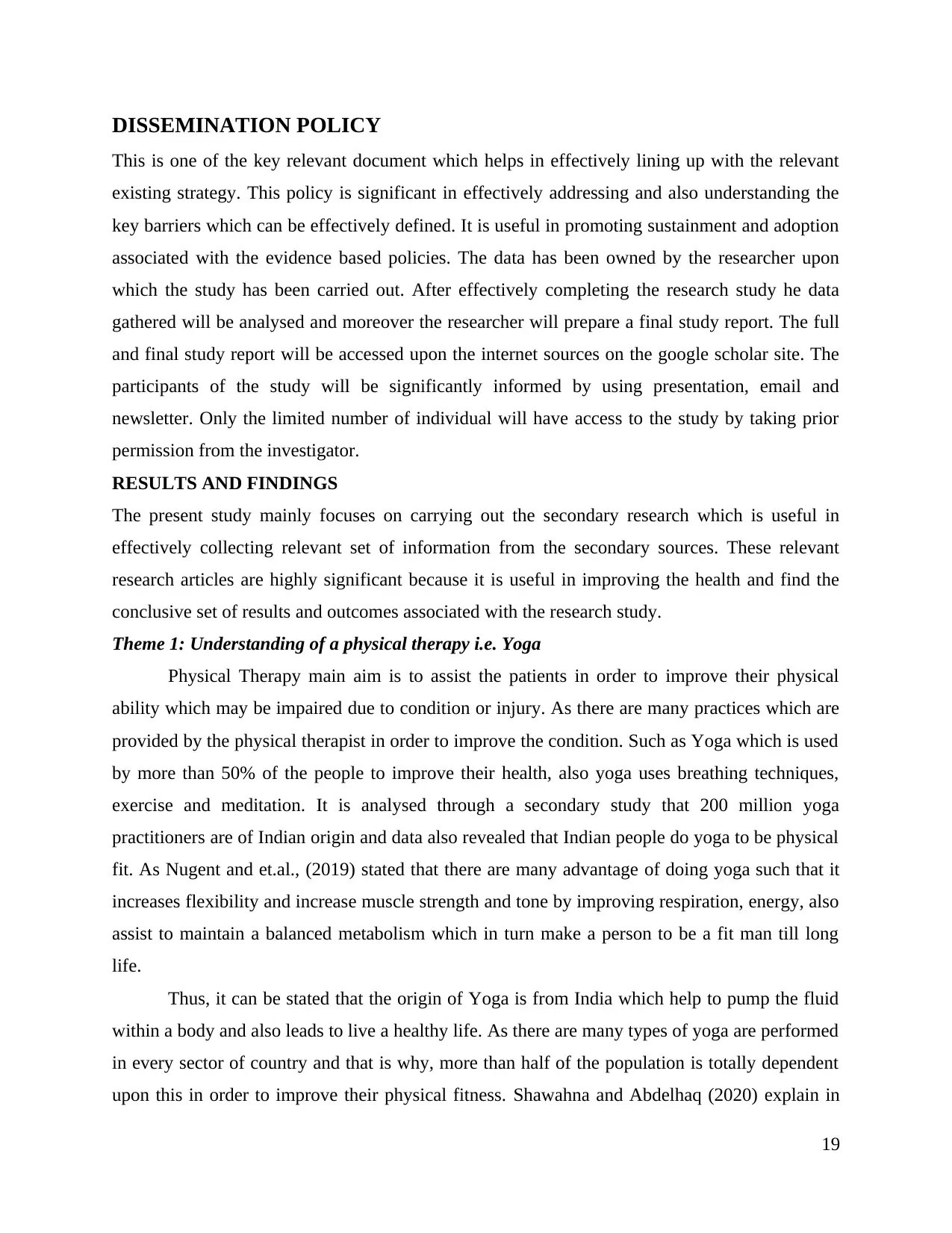
DISSEMINATION POLICY
This is one of the key relevant document which helps in effectively lining up with the relevant
existing strategy. This policy is significant in effectively addressing and also understanding the
key barriers which can be effectively defined. It is useful in promoting sustainment and adoption
associated with the evidence based policies. The data has been owned by the researcher upon
which the study has been carried out. After effectively completing the research study he data
gathered will be analysed and moreover the researcher will prepare a final study report. The full
and final study report will be accessed upon the internet sources on the google scholar site. The
participants of the study will be significantly informed by using presentation, email and
newsletter. Only the limited number of individual will have access to the study by taking prior
permission from the investigator.
RESULTS AND FINDINGS
The present study mainly focuses on carrying out the secondary research which is useful in
effectively collecting relevant set of information from the secondary sources. These relevant
research articles are highly significant because it is useful in improving the health and find the
conclusive set of results and outcomes associated with the research study.
Theme 1: Understanding of a physical therapy i.e. Yoga
Physical Therapy main aim is to assist the patients in order to improve their physical
ability which may be impaired due to condition or injury. As there are many practices which are
provided by the physical therapist in order to improve the condition. Such as Yoga which is used
by more than 50% of the people to improve their health, also yoga uses breathing techniques,
exercise and meditation. It is analysed through a secondary study that 200 million yoga
practitioners are of Indian origin and data also revealed that Indian people do yoga to be physical
fit. As Nugent and et.al., (2019) stated that there are many advantage of doing yoga such that it
increases flexibility and increase muscle strength and tone by improving respiration, energy, also
assist to maintain a balanced metabolism which in turn make a person to be a fit man till long
life.
Thus, it can be stated that the origin of Yoga is from India which help to pump the fluid
within a body and also leads to live a healthy life. As there are many types of yoga are performed
in every sector of country and that is why, more than half of the population is totally dependent
upon this in order to improve their physical fitness. Shawahna and Abdelhaq (2020) explain in
19
This is one of the key relevant document which helps in effectively lining up with the relevant
existing strategy. This policy is significant in effectively addressing and also understanding the
key barriers which can be effectively defined. It is useful in promoting sustainment and adoption
associated with the evidence based policies. The data has been owned by the researcher upon
which the study has been carried out. After effectively completing the research study he data
gathered will be analysed and moreover the researcher will prepare a final study report. The full
and final study report will be accessed upon the internet sources on the google scholar site. The
participants of the study will be significantly informed by using presentation, email and
newsletter. Only the limited number of individual will have access to the study by taking prior
permission from the investigator.
RESULTS AND FINDINGS
The present study mainly focuses on carrying out the secondary research which is useful in
effectively collecting relevant set of information from the secondary sources. These relevant
research articles are highly significant because it is useful in improving the health and find the
conclusive set of results and outcomes associated with the research study.
Theme 1: Understanding of a physical therapy i.e. Yoga
Physical Therapy main aim is to assist the patients in order to improve their physical
ability which may be impaired due to condition or injury. As there are many practices which are
provided by the physical therapist in order to improve the condition. Such as Yoga which is used
by more than 50% of the people to improve their health, also yoga uses breathing techniques,
exercise and meditation. It is analysed through a secondary study that 200 million yoga
practitioners are of Indian origin and data also revealed that Indian people do yoga to be physical
fit. As Nugent and et.al., (2019) stated that there are many advantage of doing yoga such that it
increases flexibility and increase muscle strength and tone by improving respiration, energy, also
assist to maintain a balanced metabolism which in turn make a person to be a fit man till long
life.
Thus, it can be stated that the origin of Yoga is from India which help to pump the fluid
within a body and also leads to live a healthy life. As there are many types of yoga are performed
in every sector of country and that is why, more than half of the population is totally dependent
upon this in order to improve their physical fitness. Shawahna and Abdelhaq (2020) explain in
19
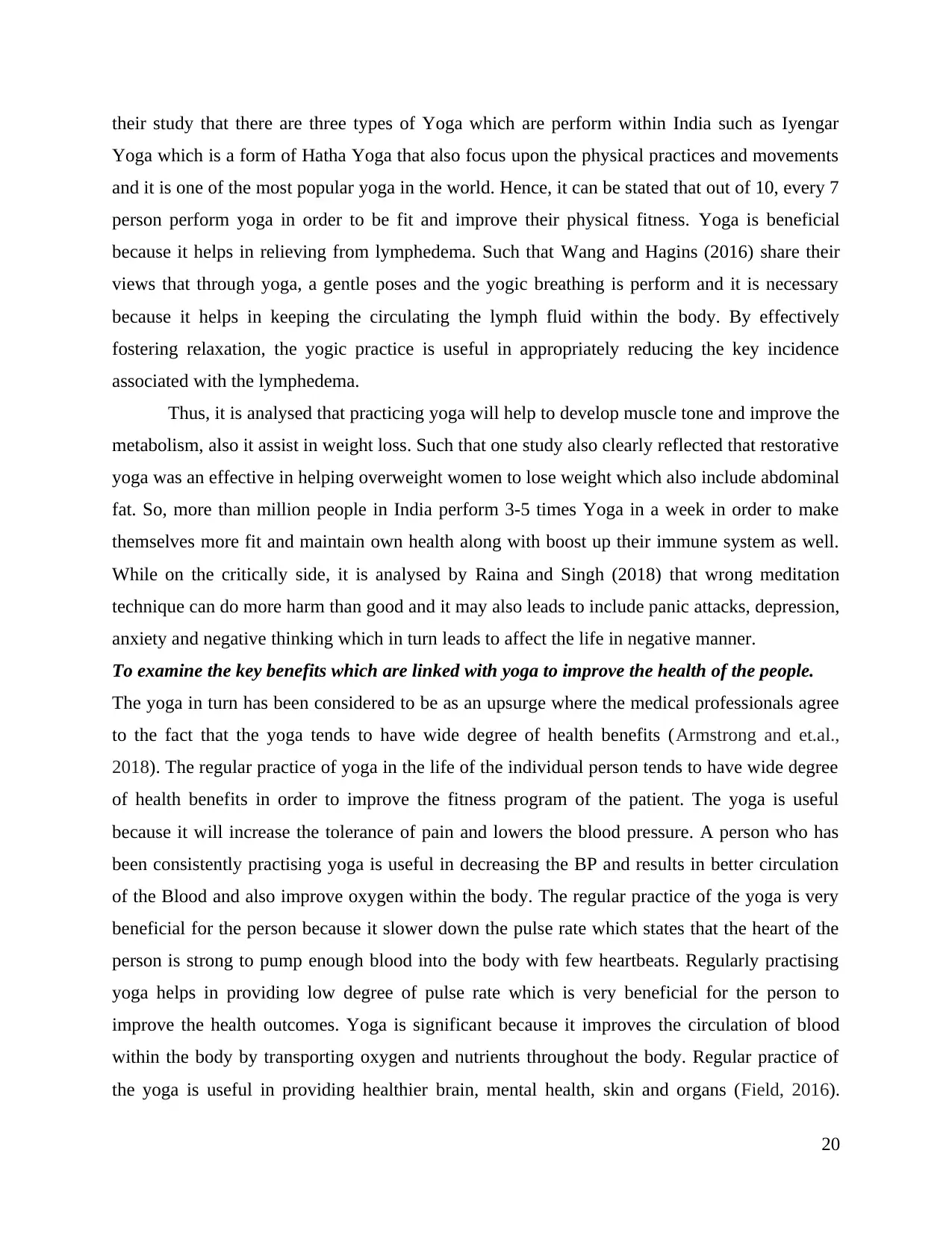
their study that there are three types of Yoga which are perform within India such as Iyengar
Yoga which is a form of Hatha Yoga that also focus upon the physical practices and movements
and it is one of the most popular yoga in the world. Hence, it can be stated that out of 10, every 7
person perform yoga in order to be fit and improve their physical fitness. Yoga is beneficial
because it helps in relieving from lymphedema. Such that Wang and Hagins (2016) share their
views that through yoga, a gentle poses and the yogic breathing is perform and it is necessary
because it helps in keeping the circulating the lymph fluid within the body. By effectively
fostering relaxation, the yogic practice is useful in appropriately reducing the key incidence
associated with the lymphedema.
Thus, it is analysed that practicing yoga will help to develop muscle tone and improve the
metabolism, also it assist in weight loss. Such that one study also clearly reflected that restorative
yoga was an effective in helping overweight women to lose weight which also include abdominal
fat. So, more than million people in India perform 3-5 times Yoga in a week in order to make
themselves more fit and maintain own health along with boost up their immune system as well.
While on the critically side, it is analysed by Raina and Singh (2018) that wrong meditation
technique can do more harm than good and it may also leads to include panic attacks, depression,
anxiety and negative thinking which in turn leads to affect the life in negative manner.
To examine the key benefits which are linked with yoga to improve the health of the people.
The yoga in turn has been considered to be as an upsurge where the medical professionals agree
to the fact that the yoga tends to have wide degree of health benefits (Armstrong and et.al.,
2018). The regular practice of yoga in the life of the individual person tends to have wide degree
of health benefits in order to improve the fitness program of the patient. The yoga is useful
because it will increase the tolerance of pain and lowers the blood pressure. A person who has
been consistently practising yoga is useful in decreasing the BP and results in better circulation
of the Blood and also improve oxygen within the body. The regular practice of the yoga is very
beneficial for the person because it slower down the pulse rate which states that the heart of the
person is strong to pump enough blood into the body with few heartbeats. Regularly practising
yoga helps in providing low degree of pulse rate which is very beneficial for the person to
improve the health outcomes. Yoga is significant because it improves the circulation of blood
within the body by transporting oxygen and nutrients throughout the body. Regular practice of
the yoga is useful in providing healthier brain, mental health, skin and organs (Field, 2016).
20
Yoga which is a form of Hatha Yoga that also focus upon the physical practices and movements
and it is one of the most popular yoga in the world. Hence, it can be stated that out of 10, every 7
person perform yoga in order to be fit and improve their physical fitness. Yoga is beneficial
because it helps in relieving from lymphedema. Such that Wang and Hagins (2016) share their
views that through yoga, a gentle poses and the yogic breathing is perform and it is necessary
because it helps in keeping the circulating the lymph fluid within the body. By effectively
fostering relaxation, the yogic practice is useful in appropriately reducing the key incidence
associated with the lymphedema.
Thus, it is analysed that practicing yoga will help to develop muscle tone and improve the
metabolism, also it assist in weight loss. Such that one study also clearly reflected that restorative
yoga was an effective in helping overweight women to lose weight which also include abdominal
fat. So, more than million people in India perform 3-5 times Yoga in a week in order to make
themselves more fit and maintain own health along with boost up their immune system as well.
While on the critically side, it is analysed by Raina and Singh (2018) that wrong meditation
technique can do more harm than good and it may also leads to include panic attacks, depression,
anxiety and negative thinking which in turn leads to affect the life in negative manner.
To examine the key benefits which are linked with yoga to improve the health of the people.
The yoga in turn has been considered to be as an upsurge where the medical professionals agree
to the fact that the yoga tends to have wide degree of health benefits (Armstrong and et.al.,
2018). The regular practice of yoga in the life of the individual person tends to have wide degree
of health benefits in order to improve the fitness program of the patient. The yoga is useful
because it will increase the tolerance of pain and lowers the blood pressure. A person who has
been consistently practising yoga is useful in decreasing the BP and results in better circulation
of the Blood and also improve oxygen within the body. The regular practice of the yoga is very
beneficial for the person because it slower down the pulse rate which states that the heart of the
person is strong to pump enough blood into the body with few heartbeats. Regularly practising
yoga helps in providing low degree of pulse rate which is very beneficial for the person to
improve the health outcomes. Yoga is significant because it improves the circulation of blood
within the body by transporting oxygen and nutrients throughout the body. Regular practice of
the yoga is useful in providing healthier brain, mental health, skin and organs (Field, 2016).
20
Secure Best Marks with AI Grader
Need help grading? Try our AI Grader for instant feedback on your assignments.
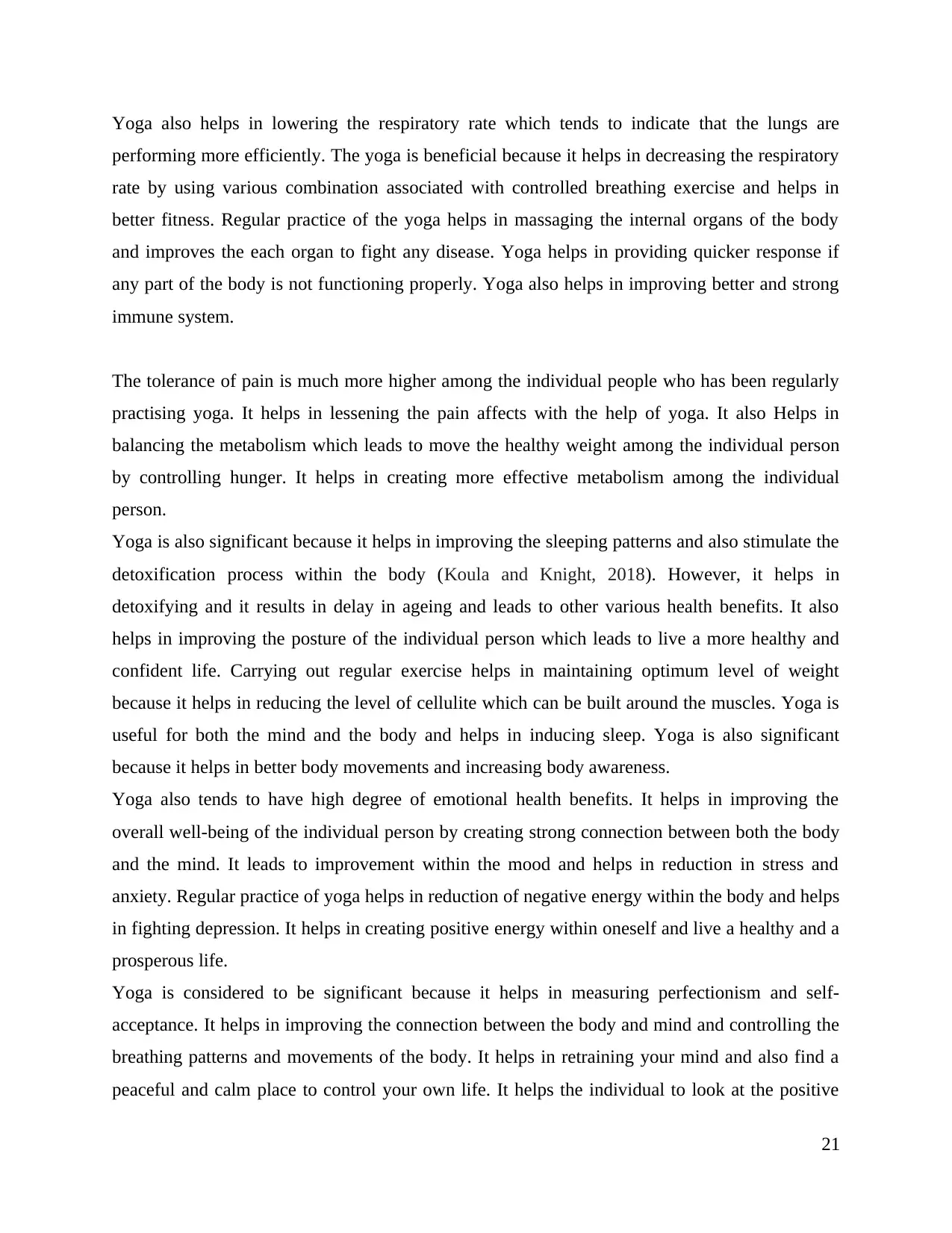
Yoga also helps in lowering the respiratory rate which tends to indicate that the lungs are
performing more efficiently. The yoga is beneficial because it helps in decreasing the respiratory
rate by using various combination associated with controlled breathing exercise and helps in
better fitness. Regular practice of the yoga helps in massaging the internal organs of the body
and improves the each organ to fight any disease. Yoga helps in providing quicker response if
any part of the body is not functioning properly. Yoga also helps in improving better and strong
immune system.
The tolerance of pain is much more higher among the individual people who has been regularly
practising yoga. It helps in lessening the pain affects with the help of yoga. It also Helps in
balancing the metabolism which leads to move the healthy weight among the individual person
by controlling hunger. It helps in creating more effective metabolism among the individual
person.
Yoga is also significant because it helps in improving the sleeping patterns and also stimulate the
detoxification process within the body (Koula and Knight, 2018). However, it helps in
detoxifying and it results in delay in ageing and leads to other various health benefits. It also
helps in improving the posture of the individual person which leads to live a more healthy and
confident life. Carrying out regular exercise helps in maintaining optimum level of weight
because it helps in reducing the level of cellulite which can be built around the muscles. Yoga is
useful for both the mind and the body and helps in inducing sleep. Yoga is also significant
because it helps in better body movements and increasing body awareness.
Yoga also tends to have high degree of emotional health benefits. It helps in improving the
overall well-being of the individual person by creating strong connection between both the body
and the mind. It leads to improvement within the mood and helps in reduction in stress and
anxiety. Regular practice of yoga helps in reduction of negative energy within the body and helps
in fighting depression. It helps in creating positive energy within oneself and live a healthy and a
prosperous life.
Yoga is considered to be significant because it helps in measuring perfectionism and self-
acceptance. It helps in improving the connection between the body and mind and controlling the
breathing patterns and movements of the body. It helps in retraining your mind and also find a
peaceful and calm place to control your own life. It helps the individual to look at the positive
21
performing more efficiently. The yoga is beneficial because it helps in decreasing the respiratory
rate by using various combination associated with controlled breathing exercise and helps in
better fitness. Regular practice of the yoga helps in massaging the internal organs of the body
and improves the each organ to fight any disease. Yoga helps in providing quicker response if
any part of the body is not functioning properly. Yoga also helps in improving better and strong
immune system.
The tolerance of pain is much more higher among the individual people who has been regularly
practising yoga. It helps in lessening the pain affects with the help of yoga. It also Helps in
balancing the metabolism which leads to move the healthy weight among the individual person
by controlling hunger. It helps in creating more effective metabolism among the individual
person.
Yoga is also significant because it helps in improving the sleeping patterns and also stimulate the
detoxification process within the body (Koula and Knight, 2018). However, it helps in
detoxifying and it results in delay in ageing and leads to other various health benefits. It also
helps in improving the posture of the individual person which leads to live a more healthy and
confident life. Carrying out regular exercise helps in maintaining optimum level of weight
because it helps in reducing the level of cellulite which can be built around the muscles. Yoga is
useful for both the mind and the body and helps in inducing sleep. Yoga is also significant
because it helps in better body movements and increasing body awareness.
Yoga also tends to have high degree of emotional health benefits. It helps in improving the
overall well-being of the individual person by creating strong connection between both the body
and the mind. It leads to improvement within the mood and helps in reduction in stress and
anxiety. Regular practice of yoga helps in reduction of negative energy within the body and helps
in fighting depression. It helps in creating positive energy within oneself and live a healthy and a
prosperous life.
Yoga is considered to be significant because it helps in measuring perfectionism and self-
acceptance. It helps in improving the connection between the body and mind and controlling the
breathing patterns and movements of the body. It helps in retraining your mind and also find a
peaceful and calm place to control your own life. It helps the individual to look at the positive
21
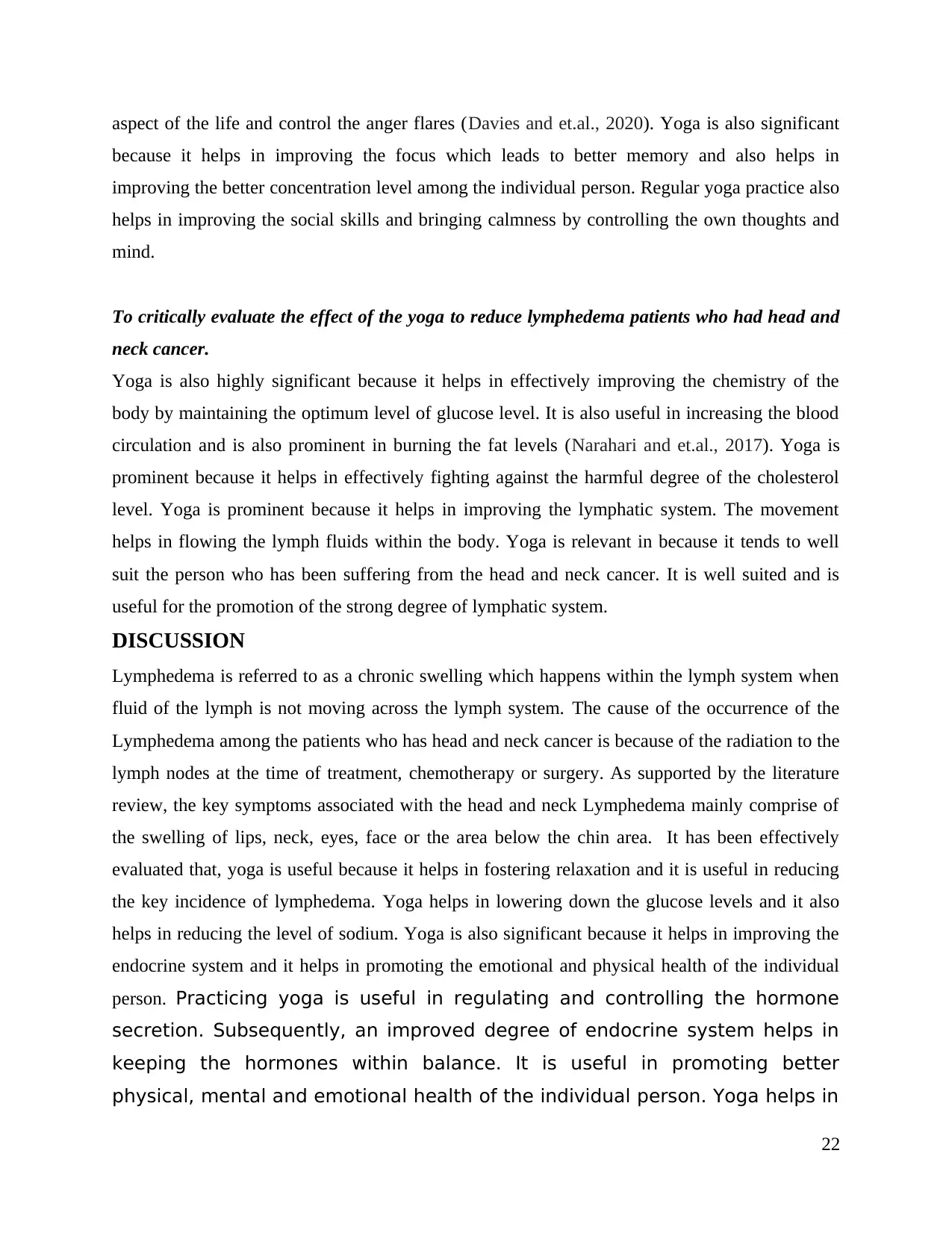
aspect of the life and control the anger flares (Davies and et.al., 2020). Yoga is also significant
because it helps in improving the focus which leads to better memory and also helps in
improving the better concentration level among the individual person. Regular yoga practice also
helps in improving the social skills and bringing calmness by controlling the own thoughts and
mind.
To critically evaluate the effect of the yoga to reduce lymphedema patients who had head and
neck cancer.
Yoga is also highly significant because it helps in effectively improving the chemistry of the
body by maintaining the optimum level of glucose level. It is also useful in increasing the blood
circulation and is also prominent in burning the fat levels (Narahari and et.al., 2017). Yoga is
prominent because it helps in effectively fighting against the harmful degree of the cholesterol
level. Yoga is prominent because it helps in improving the lymphatic system. The movement
helps in flowing the lymph fluids within the body. Yoga is relevant in because it tends to well
suit the person who has been suffering from the head and neck cancer. It is well suited and is
useful for the promotion of the strong degree of lymphatic system.
DISCUSSION
Lymphedema is referred to as a chronic swelling which happens within the lymph system when
fluid of the lymph is not moving across the lymph system. The cause of the occurrence of the
Lymphedema among the patients who has head and neck cancer is because of the radiation to the
lymph nodes at the time of treatment, chemotherapy or surgery. As supported by the literature
review, the key symptoms associated with the head and neck Lymphedema mainly comprise of
the swelling of lips, neck, eyes, face or the area below the chin area. It has been effectively
evaluated that, yoga is useful because it helps in fostering relaxation and it is useful in reducing
the key incidence of lymphedema. Yoga helps in lowering down the glucose levels and it also
helps in reducing the level of sodium. Yoga is also significant because it helps in improving the
endocrine system and it helps in promoting the emotional and physical health of the individual
person. Practicing yoga is useful in regulating and controlling the hormone
secretion. Subsequently, an improved degree of endocrine system helps in
keeping the hormones within balance. It is useful in promoting better
physical, mental and emotional health of the individual person. Yoga helps in
22
because it helps in improving the focus which leads to better memory and also helps in
improving the better concentration level among the individual person. Regular yoga practice also
helps in improving the social skills and bringing calmness by controlling the own thoughts and
mind.
To critically evaluate the effect of the yoga to reduce lymphedema patients who had head and
neck cancer.
Yoga is also highly significant because it helps in effectively improving the chemistry of the
body by maintaining the optimum level of glucose level. It is also useful in increasing the blood
circulation and is also prominent in burning the fat levels (Narahari and et.al., 2017). Yoga is
prominent because it helps in effectively fighting against the harmful degree of the cholesterol
level. Yoga is prominent because it helps in improving the lymphatic system. The movement
helps in flowing the lymph fluids within the body. Yoga is relevant in because it tends to well
suit the person who has been suffering from the head and neck cancer. It is well suited and is
useful for the promotion of the strong degree of lymphatic system.
DISCUSSION
Lymphedema is referred to as a chronic swelling which happens within the lymph system when
fluid of the lymph is not moving across the lymph system. The cause of the occurrence of the
Lymphedema among the patients who has head and neck cancer is because of the radiation to the
lymph nodes at the time of treatment, chemotherapy or surgery. As supported by the literature
review, the key symptoms associated with the head and neck Lymphedema mainly comprise of
the swelling of lips, neck, eyes, face or the area below the chin area. It has been effectively
evaluated that, yoga is useful because it helps in fostering relaxation and it is useful in reducing
the key incidence of lymphedema. Yoga helps in lowering down the glucose levels and it also
helps in reducing the level of sodium. Yoga is also significant because it helps in improving the
endocrine system and it helps in promoting the emotional and physical health of the individual
person. Practicing yoga is useful in regulating and controlling the hormone
secretion. Subsequently, an improved degree of endocrine system helps in
keeping the hormones within balance. It is useful in promoting better
physical, mental and emotional health of the individual person. Yoga helps in
22
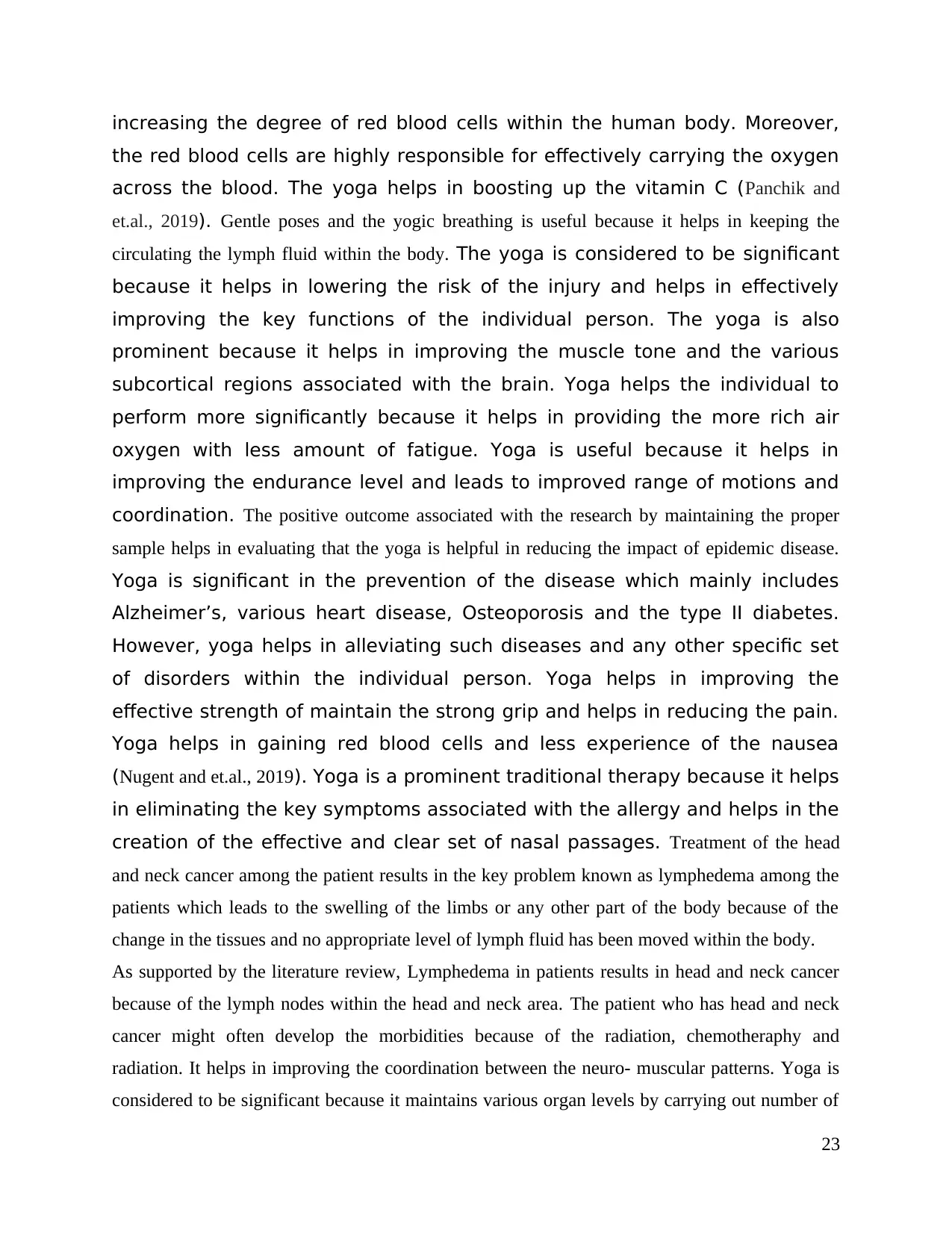
increasing the degree of red blood cells within the human body. Moreover,
the red blood cells are highly responsible for effectively carrying the oxygen
across the blood. The yoga helps in boosting up the vitamin C (Panchik and
et.al., 2019). Gentle poses and the yogic breathing is useful because it helps in keeping the
circulating the lymph fluid within the body. The yoga is considered to be significant
because it helps in lowering the risk of the injury and helps in effectively
improving the key functions of the individual person. The yoga is also
prominent because it helps in improving the muscle tone and the various
subcortical regions associated with the brain. Yoga helps the individual to
perform more significantly because it helps in providing the more rich air
oxygen with less amount of fatigue. Yoga is useful because it helps in
improving the endurance level and leads to improved range of motions and
coordination. The positive outcome associated with the research by maintaining the proper
sample helps in evaluating that the yoga is helpful in reducing the impact of epidemic disease.
Yoga is significant in the prevention of the disease which mainly includes
Alzheimer’s, various heart disease, Osteoporosis and the type II diabetes.
However, yoga helps in alleviating such diseases and any other specific set
of disorders within the individual person. Yoga helps in improving the
effective strength of maintain the strong grip and helps in reducing the pain.
Yoga helps in gaining red blood cells and less experience of the nausea
(Nugent and et.al., 2019). Yoga is a prominent traditional therapy because it helps
in eliminating the key symptoms associated with the allergy and helps in the
creation of the effective and clear set of nasal passages. Treatment of the head
and neck cancer among the patient results in the key problem known as lymphedema among the
patients which leads to the swelling of the limbs or any other part of the body because of the
change in the tissues and no appropriate level of lymph fluid has been moved within the body.
As supported by the literature review, Lymphedema in patients results in head and neck cancer
because of the lymph nodes within the head and neck area. The patient who has head and neck
cancer might often develop the morbidities because of the radiation, chemotheraphy and
radiation. It helps in improving the coordination between the neuro- muscular patterns. Yoga is
considered to be significant because it maintains various organ levels by carrying out number of
23
the red blood cells are highly responsible for effectively carrying the oxygen
across the blood. The yoga helps in boosting up the vitamin C (Panchik and
et.al., 2019). Gentle poses and the yogic breathing is useful because it helps in keeping the
circulating the lymph fluid within the body. The yoga is considered to be significant
because it helps in lowering the risk of the injury and helps in effectively
improving the key functions of the individual person. The yoga is also
prominent because it helps in improving the muscle tone and the various
subcortical regions associated with the brain. Yoga helps the individual to
perform more significantly because it helps in providing the more rich air
oxygen with less amount of fatigue. Yoga is useful because it helps in
improving the endurance level and leads to improved range of motions and
coordination. The positive outcome associated with the research by maintaining the proper
sample helps in evaluating that the yoga is helpful in reducing the impact of epidemic disease.
Yoga is significant in the prevention of the disease which mainly includes
Alzheimer’s, various heart disease, Osteoporosis and the type II diabetes.
However, yoga helps in alleviating such diseases and any other specific set
of disorders within the individual person. Yoga helps in improving the
effective strength of maintain the strong grip and helps in reducing the pain.
Yoga helps in gaining red blood cells and less experience of the nausea
(Nugent and et.al., 2019). Yoga is a prominent traditional therapy because it helps
in eliminating the key symptoms associated with the allergy and helps in the
creation of the effective and clear set of nasal passages. Treatment of the head
and neck cancer among the patient results in the key problem known as lymphedema among the
patients which leads to the swelling of the limbs or any other part of the body because of the
change in the tissues and no appropriate level of lymph fluid has been moved within the body.
As supported by the literature review, Lymphedema in patients results in head and neck cancer
because of the lymph nodes within the head and neck area. The patient who has head and neck
cancer might often develop the morbidities because of the radiation, chemotheraphy and
radiation. It helps in improving the coordination between the neuro- muscular patterns. Yoga is
considered to be significant because it maintains various organ levels by carrying out number of
23
Paraphrase This Document
Need a fresh take? Get an instant paraphrase of this document with our AI Paraphraser
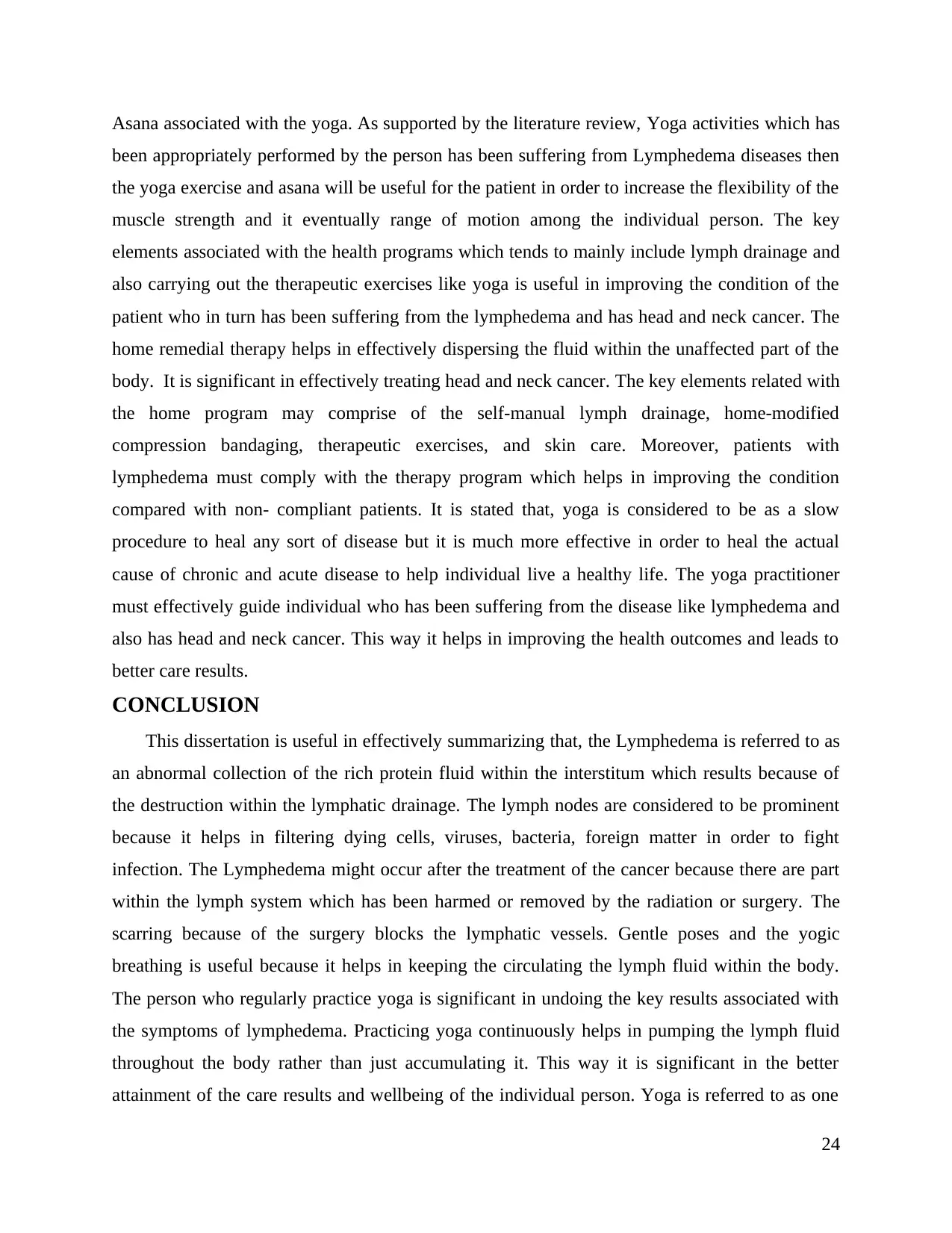
Asana associated with the yoga. As supported by the literature review, Yoga activities which has
been appropriately performed by the person has been suffering from Lymphedema diseases then
the yoga exercise and asana will be useful for the patient in order to increase the flexibility of the
muscle strength and it eventually range of motion among the individual person. The key
elements associated with the health programs which tends to mainly include lymph drainage and
also carrying out the therapeutic exercises like yoga is useful in improving the condition of the
patient who in turn has been suffering from the lymphedema and has head and neck cancer. The
home remedial therapy helps in effectively dispersing the fluid within the unaffected part of the
body. It is significant in effectively treating head and neck cancer. The key elements related with
the home program may comprise of the self-manual lymph drainage, home-modified
compression bandaging, therapeutic exercises, and skin care. Moreover, patients with
lymphedema must comply with the therapy program which helps in improving the condition
compared with non- compliant patients. It is stated that, yoga is considered to be as a slow
procedure to heal any sort of disease but it is much more effective in order to heal the actual
cause of chronic and acute disease to help individual live a healthy life. The yoga practitioner
must effectively guide individual who has been suffering from the disease like lymphedema and
also has head and neck cancer. This way it helps in improving the health outcomes and leads to
better care results.
CONCLUSION
This dissertation is useful in effectively summarizing that, the Lymphedema is referred to as
an abnormal collection of the rich protein fluid within the interstitum which results because of
the destruction within the lymphatic drainage. The lymph nodes are considered to be prominent
because it helps in filtering dying cells, viruses, bacteria, foreign matter in order to fight
infection. The Lymphedema might occur after the treatment of the cancer because there are part
within the lymph system which has been harmed or removed by the radiation or surgery. The
scarring because of the surgery blocks the lymphatic vessels. Gentle poses and the yogic
breathing is useful because it helps in keeping the circulating the lymph fluid within the body.
The person who regularly practice yoga is significant in undoing the key results associated with
the symptoms of lymphedema. Practicing yoga continuously helps in pumping the lymph fluid
throughout the body rather than just accumulating it. This way it is significant in the better
attainment of the care results and wellbeing of the individual person. Yoga is referred to as one
24
been appropriately performed by the person has been suffering from Lymphedema diseases then
the yoga exercise and asana will be useful for the patient in order to increase the flexibility of the
muscle strength and it eventually range of motion among the individual person. The key
elements associated with the health programs which tends to mainly include lymph drainage and
also carrying out the therapeutic exercises like yoga is useful in improving the condition of the
patient who in turn has been suffering from the lymphedema and has head and neck cancer. The
home remedial therapy helps in effectively dispersing the fluid within the unaffected part of the
body. It is significant in effectively treating head and neck cancer. The key elements related with
the home program may comprise of the self-manual lymph drainage, home-modified
compression bandaging, therapeutic exercises, and skin care. Moreover, patients with
lymphedema must comply with the therapy program which helps in improving the condition
compared with non- compliant patients. It is stated that, yoga is considered to be as a slow
procedure to heal any sort of disease but it is much more effective in order to heal the actual
cause of chronic and acute disease to help individual live a healthy life. The yoga practitioner
must effectively guide individual who has been suffering from the disease like lymphedema and
also has head and neck cancer. This way it helps in improving the health outcomes and leads to
better care results.
CONCLUSION
This dissertation is useful in effectively summarizing that, the Lymphedema is referred to as
an abnormal collection of the rich protein fluid within the interstitum which results because of
the destruction within the lymphatic drainage. The lymph nodes are considered to be prominent
because it helps in filtering dying cells, viruses, bacteria, foreign matter in order to fight
infection. The Lymphedema might occur after the treatment of the cancer because there are part
within the lymph system which has been harmed or removed by the radiation or surgery. The
scarring because of the surgery blocks the lymphatic vessels. Gentle poses and the yogic
breathing is useful because it helps in keeping the circulating the lymph fluid within the body.
The person who regularly practice yoga is significant in undoing the key results associated with
the symptoms of lymphedema. Practicing yoga continuously helps in pumping the lymph fluid
throughout the body rather than just accumulating it. This way it is significant in the better
attainment of the care results and wellbeing of the individual person. Yoga is referred to as one
24
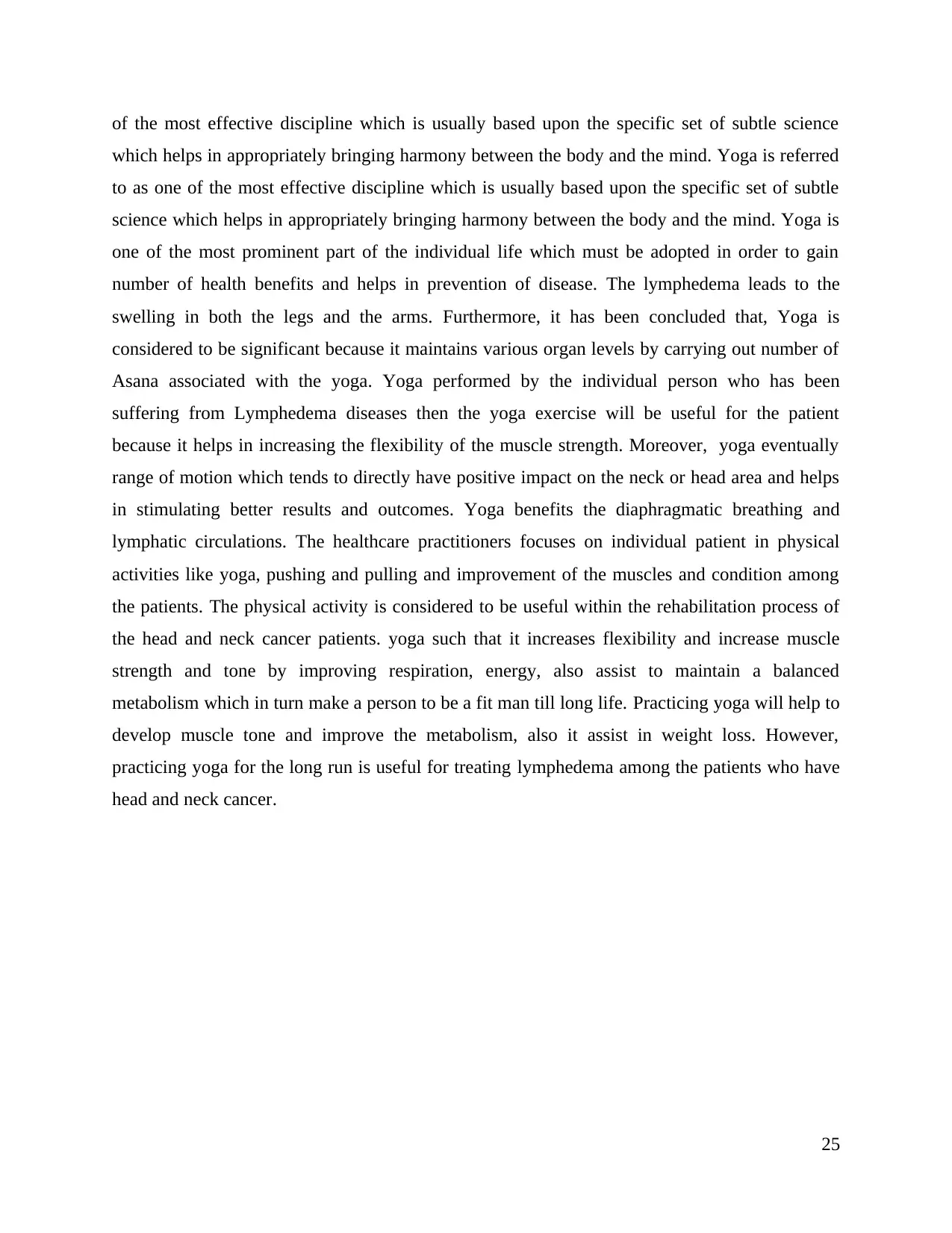
of the most effective discipline which is usually based upon the specific set of subtle science
which helps in appropriately bringing harmony between the body and the mind. Yoga is referred
to as one of the most effective discipline which is usually based upon the specific set of subtle
science which helps in appropriately bringing harmony between the body and the mind. Yoga is
one of the most prominent part of the individual life which must be adopted in order to gain
number of health benefits and helps in prevention of disease. The lymphedema leads to the
swelling in both the legs and the arms. Furthermore, it has been concluded that, Yoga is
considered to be significant because it maintains various organ levels by carrying out number of
Asana associated with the yoga. Yoga performed by the individual person who has been
suffering from Lymphedema diseases then the yoga exercise will be useful for the patient
because it helps in increasing the flexibility of the muscle strength. Moreover, yoga eventually
range of motion which tends to directly have positive impact on the neck or head area and helps
in stimulating better results and outcomes. Yoga benefits the diaphragmatic breathing and
lymphatic circulations. The healthcare practitioners focuses on individual patient in physical
activities like yoga, pushing and pulling and improvement of the muscles and condition among
the patients. The physical activity is considered to be useful within the rehabilitation process of
the head and neck cancer patients. yoga such that it increases flexibility and increase muscle
strength and tone by improving respiration, energy, also assist to maintain a balanced
metabolism which in turn make a person to be a fit man till long life. Practicing yoga will help to
develop muscle tone and improve the metabolism, also it assist in weight loss. However,
practicing yoga for the long run is useful for treating lymphedema among the patients who have
head and neck cancer.
25
which helps in appropriately bringing harmony between the body and the mind. Yoga is referred
to as one of the most effective discipline which is usually based upon the specific set of subtle
science which helps in appropriately bringing harmony between the body and the mind. Yoga is
one of the most prominent part of the individual life which must be adopted in order to gain
number of health benefits and helps in prevention of disease. The lymphedema leads to the
swelling in both the legs and the arms. Furthermore, it has been concluded that, Yoga is
considered to be significant because it maintains various organ levels by carrying out number of
Asana associated with the yoga. Yoga performed by the individual person who has been
suffering from Lymphedema diseases then the yoga exercise will be useful for the patient
because it helps in increasing the flexibility of the muscle strength. Moreover, yoga eventually
range of motion which tends to directly have positive impact on the neck or head area and helps
in stimulating better results and outcomes. Yoga benefits the diaphragmatic breathing and
lymphatic circulations. The healthcare practitioners focuses on individual patient in physical
activities like yoga, pushing and pulling and improvement of the muscles and condition among
the patients. The physical activity is considered to be useful within the rehabilitation process of
the head and neck cancer patients. yoga such that it increases flexibility and increase muscle
strength and tone by improving respiration, energy, also assist to maintain a balanced
metabolism which in turn make a person to be a fit man till long life. Practicing yoga will help to
develop muscle tone and improve the metabolism, also it assist in weight loss. However,
practicing yoga for the long run is useful for treating lymphedema among the patients who have
head and neck cancer.
25
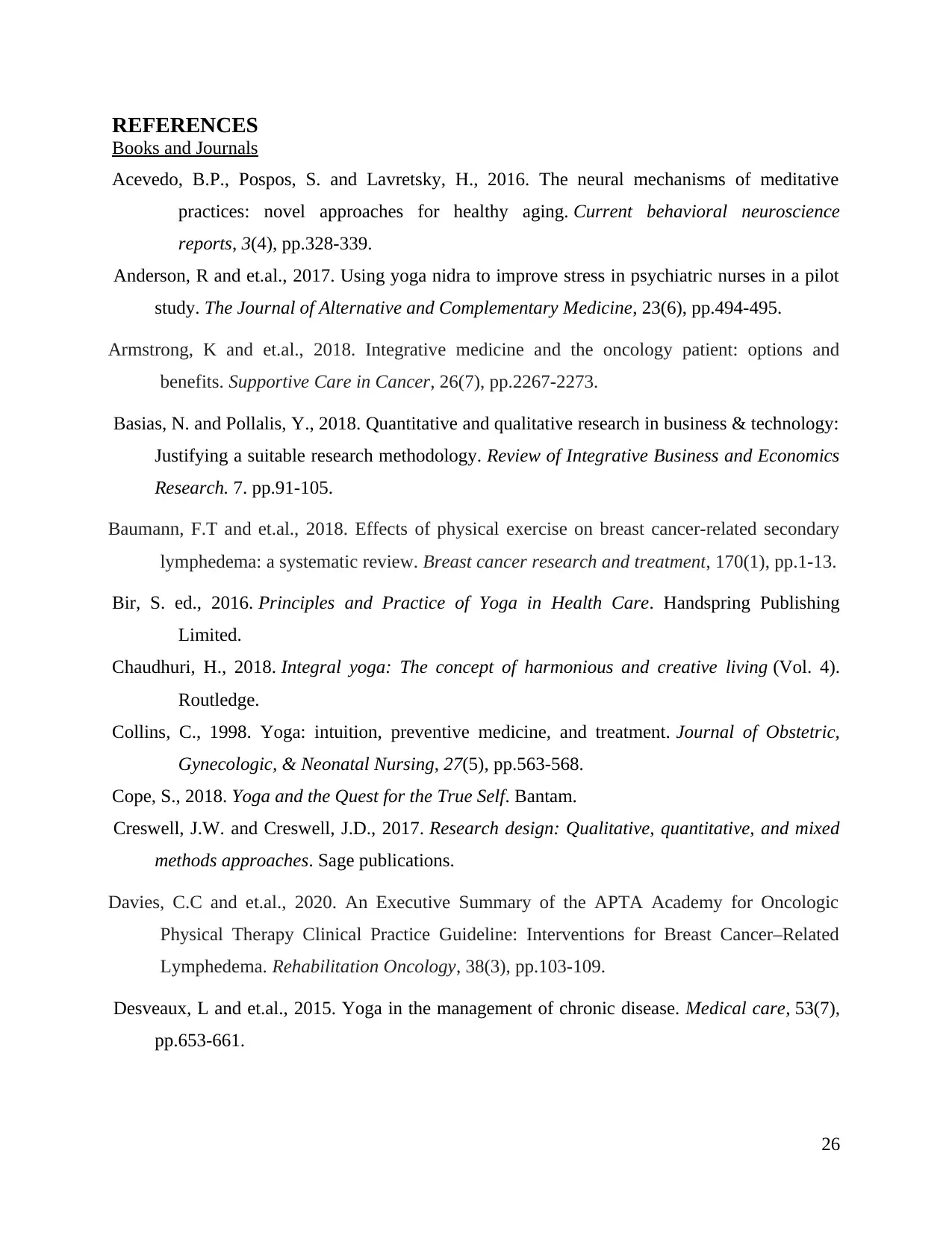
REFERENCES
Books and Journals
Acevedo, B.P., Pospos, S. and Lavretsky, H., 2016. The neural mechanisms of meditative
practices: novel approaches for healthy aging. Current behavioral neuroscience
reports, 3(4), pp.328-339.
Anderson, R and et.al., 2017. Using yoga nidra to improve stress in psychiatric nurses in a pilot
study. The Journal of Alternative and Complementary Medicine, 23(6), pp.494-495.
Armstrong, K and et.al., 2018. Integrative medicine and the oncology patient: options and
benefits. Supportive Care in Cancer, 26(7), pp.2267-2273.
Basias, N. and Pollalis, Y., 2018. Quantitative and qualitative research in business & technology:
Justifying a suitable research methodology. Review of Integrative Business and Economics
Research. 7. pp.91-105.
Baumann, F.T and et.al., 2018. Effects of physical exercise on breast cancer-related secondary
lymphedema: a systematic review. Breast cancer research and treatment, 170(1), pp.1-13.
Bir, S. ed., 2016. Principles and Practice of Yoga in Health Care. Handspring Publishing
Limited.
Chaudhuri, H., 2018. Integral yoga: The concept of harmonious and creative living (Vol. 4).
Routledge.
Collins, C., 1998. Yoga: intuition, preventive medicine, and treatment. Journal of Obstetric,
Gynecologic, & Neonatal Nursing, 27(5), pp.563-568.
Cope, S., 2018. Yoga and the Quest for the True Self. Bantam.
Creswell, J.W. and Creswell, J.D., 2017. Research design: Qualitative, quantitative, and mixed
methods approaches. Sage publications.
Davies, C.C and et.al., 2020. An Executive Summary of the APTA Academy for Oncologic
Physical Therapy Clinical Practice Guideline: Interventions for Breast Cancer–Related
Lymphedema. Rehabilitation Oncology, 38(3), pp.103-109.
Desveaux, L and et.al., 2015. Yoga in the management of chronic disease. Medical care, 53(7),
pp.653-661.
26
Books and Journals
Acevedo, B.P., Pospos, S. and Lavretsky, H., 2016. The neural mechanisms of meditative
practices: novel approaches for healthy aging. Current behavioral neuroscience
reports, 3(4), pp.328-339.
Anderson, R and et.al., 2017. Using yoga nidra to improve stress in psychiatric nurses in a pilot
study. The Journal of Alternative and Complementary Medicine, 23(6), pp.494-495.
Armstrong, K and et.al., 2018. Integrative medicine and the oncology patient: options and
benefits. Supportive Care in Cancer, 26(7), pp.2267-2273.
Basias, N. and Pollalis, Y., 2018. Quantitative and qualitative research in business & technology:
Justifying a suitable research methodology. Review of Integrative Business and Economics
Research. 7. pp.91-105.
Baumann, F.T and et.al., 2018. Effects of physical exercise on breast cancer-related secondary
lymphedema: a systematic review. Breast cancer research and treatment, 170(1), pp.1-13.
Bir, S. ed., 2016. Principles and Practice of Yoga in Health Care. Handspring Publishing
Limited.
Chaudhuri, H., 2018. Integral yoga: The concept of harmonious and creative living (Vol. 4).
Routledge.
Collins, C., 1998. Yoga: intuition, preventive medicine, and treatment. Journal of Obstetric,
Gynecologic, & Neonatal Nursing, 27(5), pp.563-568.
Cope, S., 2018. Yoga and the Quest for the True Self. Bantam.
Creswell, J.W. and Creswell, J.D., 2017. Research design: Qualitative, quantitative, and mixed
methods approaches. Sage publications.
Davies, C.C and et.al., 2020. An Executive Summary of the APTA Academy for Oncologic
Physical Therapy Clinical Practice Guideline: Interventions for Breast Cancer–Related
Lymphedema. Rehabilitation Oncology, 38(3), pp.103-109.
Desveaux, L and et.al., 2015. Yoga in the management of chronic disease. Medical care, 53(7),
pp.653-661.
26
Secure Best Marks with AI Grader
Need help grading? Try our AI Grader for instant feedback on your assignments.
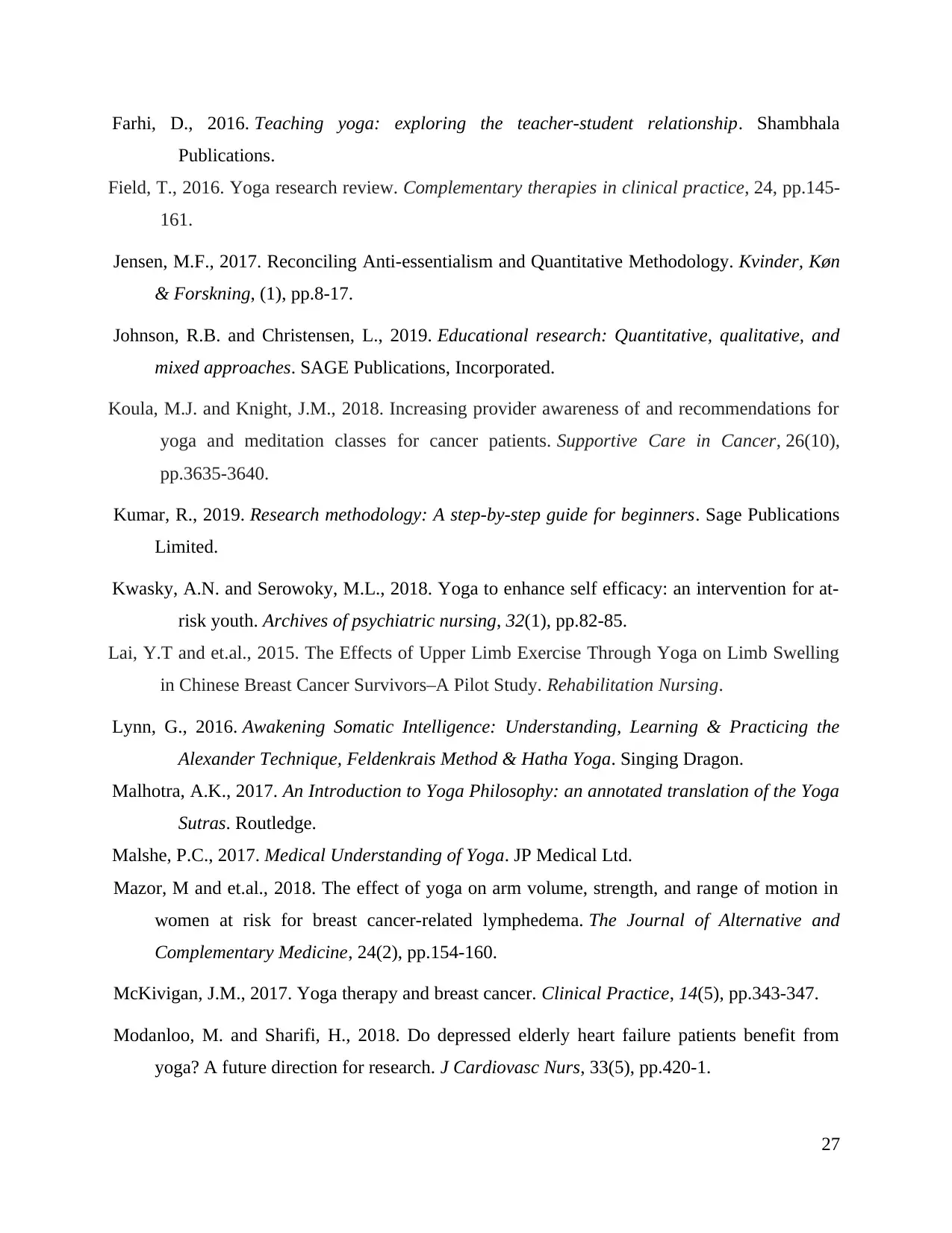
Farhi, D., 2016. Teaching yoga: exploring the teacher-student relationship. Shambhala
Publications.
Field, T., 2016. Yoga research review. Complementary therapies in clinical practice, 24, pp.145-
161.
Jensen, M.F., 2017. Reconciling Anti-essentialism and Quantitative Methodology. Kvinder, Køn
& Forskning, (1), pp.8-17.
Johnson, R.B. and Christensen, L., 2019. Educational research: Quantitative, qualitative, and
mixed approaches. SAGE Publications, Incorporated.
Koula, M.J. and Knight, J.M., 2018. Increasing provider awareness of and recommendations for
yoga and meditation classes for cancer patients. Supportive Care in Cancer, 26(10),
pp.3635-3640.
Kumar, R., 2019. Research methodology: A step-by-step guide for beginners. Sage Publications
Limited.
Kwasky, A.N. and Serowoky, M.L., 2018. Yoga to enhance self efficacy: an intervention for at-
risk youth. Archives of psychiatric nursing, 32(1), pp.82-85.
Lai, Y.T and et.al., 2015. The Effects of Upper Limb Exercise Through Yoga on Limb Swelling
in Chinese Breast Cancer Survivors–A Pilot Study. Rehabilitation Nursing.
Lynn, G., 2016. Awakening Somatic Intelligence: Understanding, Learning & Practicing the
Alexander Technique, Feldenkrais Method & Hatha Yoga. Singing Dragon.
Malhotra, A.K., 2017. An Introduction to Yoga Philosophy: an annotated translation of the Yoga
Sutras. Routledge.
Malshe, P.C., 2017. Medical Understanding of Yoga. JP Medical Ltd.
Mazor, M and et.al., 2018. The effect of yoga on arm volume, strength, and range of motion in
women at risk for breast cancer-related lymphedema. The Journal of Alternative and
Complementary Medicine, 24(2), pp.154-160.
McKivigan, J.M., 2017. Yoga therapy and breast cancer. Clinical Practice, 14(5), pp.343-347.
Modanloo, M. and Sharifi, H., 2018. Do depressed elderly heart failure patients benefit from
yoga? A future direction for research. J Cardiovasc Nurs, 33(5), pp.420-1.
27
Publications.
Field, T., 2016. Yoga research review. Complementary therapies in clinical practice, 24, pp.145-
161.
Jensen, M.F., 2017. Reconciling Anti-essentialism and Quantitative Methodology. Kvinder, Køn
& Forskning, (1), pp.8-17.
Johnson, R.B. and Christensen, L., 2019. Educational research: Quantitative, qualitative, and
mixed approaches. SAGE Publications, Incorporated.
Koula, M.J. and Knight, J.M., 2018. Increasing provider awareness of and recommendations for
yoga and meditation classes for cancer patients. Supportive Care in Cancer, 26(10),
pp.3635-3640.
Kumar, R., 2019. Research methodology: A step-by-step guide for beginners. Sage Publications
Limited.
Kwasky, A.N. and Serowoky, M.L., 2018. Yoga to enhance self efficacy: an intervention for at-
risk youth. Archives of psychiatric nursing, 32(1), pp.82-85.
Lai, Y.T and et.al., 2015. The Effects of Upper Limb Exercise Through Yoga on Limb Swelling
in Chinese Breast Cancer Survivors–A Pilot Study. Rehabilitation Nursing.
Lynn, G., 2016. Awakening Somatic Intelligence: Understanding, Learning & Practicing the
Alexander Technique, Feldenkrais Method & Hatha Yoga. Singing Dragon.
Malhotra, A.K., 2017. An Introduction to Yoga Philosophy: an annotated translation of the Yoga
Sutras. Routledge.
Malshe, P.C., 2017. Medical Understanding of Yoga. JP Medical Ltd.
Mazor, M and et.al., 2018. The effect of yoga on arm volume, strength, and range of motion in
women at risk for breast cancer-related lymphedema. The Journal of Alternative and
Complementary Medicine, 24(2), pp.154-160.
McKivigan, J.M., 2017. Yoga therapy and breast cancer. Clinical Practice, 14(5), pp.343-347.
Modanloo, M. and Sharifi, H., 2018. Do depressed elderly heart failure patients benefit from
yoga? A future direction for research. J Cardiovasc Nurs, 33(5), pp.420-1.
27
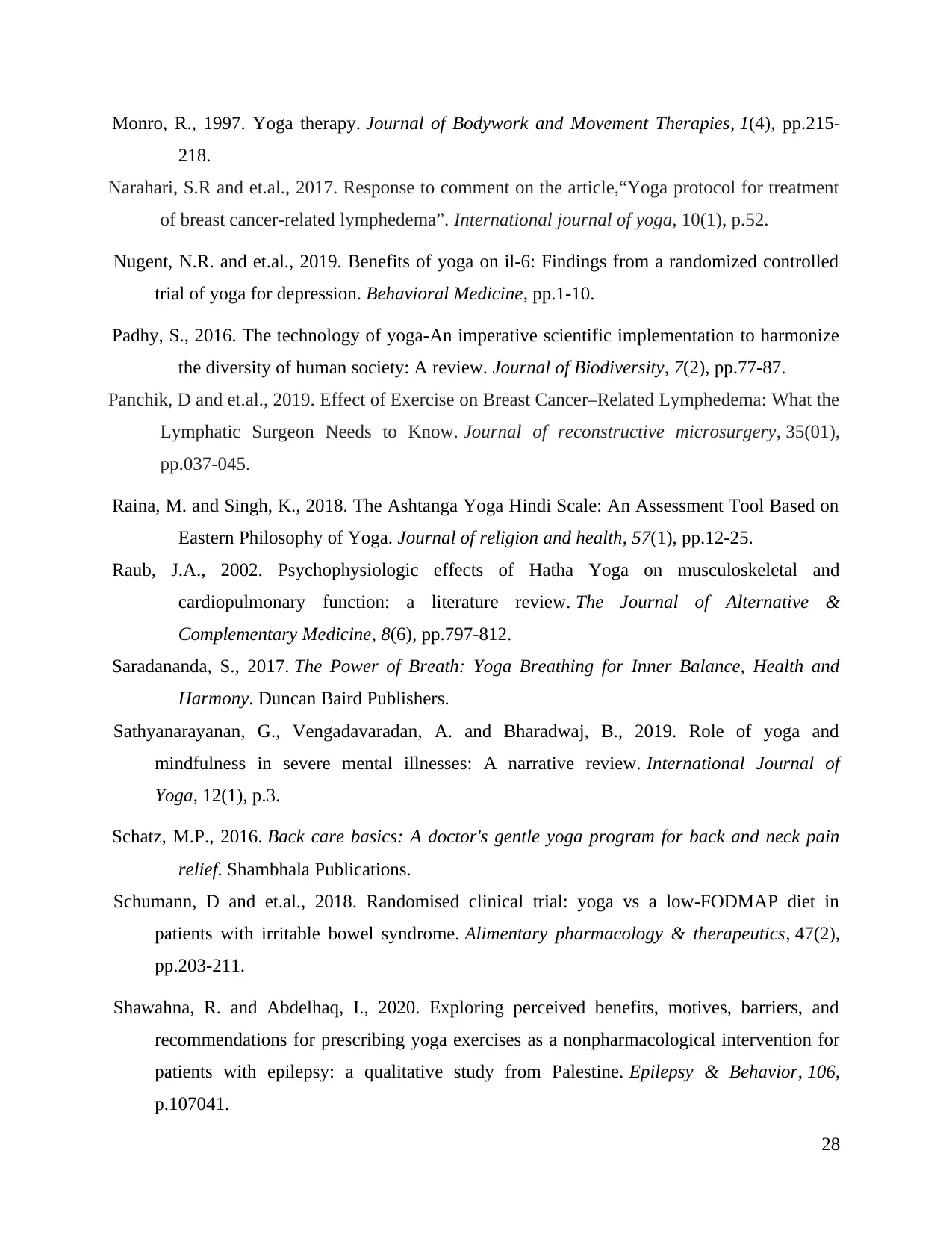
Monro, R., 1997. Yoga therapy. Journal of Bodywork and Movement Therapies, 1(4), pp.215-
218.
Narahari, S.R and et.al., 2017. Response to comment on the article,“Yoga protocol for treatment
of breast cancer-related lymphedema”. International journal of yoga, 10(1), p.52.
Nugent, N.R. and et.al., 2019. Benefits of yoga on il-6: Findings from a randomized controlled
trial of yoga for depression. Behavioral Medicine, pp.1-10.
Padhy, S., 2016. The technology of yoga-An imperative scientific implementation to harmonize
the diversity of human society: A review. Journal of Biodiversity, 7(2), pp.77-87.
Panchik, D and et.al., 2019. Effect of Exercise on Breast Cancer–Related Lymphedema: What the
Lymphatic Surgeon Needs to Know. Journal of reconstructive microsurgery, 35(01),
pp.037-045.
Raina, M. and Singh, K., 2018. The Ashtanga Yoga Hindi Scale: An Assessment Tool Based on
Eastern Philosophy of Yoga. Journal of religion and health, 57(1), pp.12-25.
Raub, J.A., 2002. Psychophysiologic effects of Hatha Yoga on musculoskeletal and
cardiopulmonary function: a literature review. The Journal of Alternative &
Complementary Medicine, 8(6), pp.797-812.
Saradananda, S., 2017. The Power of Breath: Yoga Breathing for Inner Balance, Health and
Harmony. Duncan Baird Publishers.
Sathyanarayanan, G., Vengadavaradan, A. and Bharadwaj, B., 2019. Role of yoga and
mindfulness in severe mental illnesses: A narrative review. International Journal of
Yoga, 12(1), p.3.
Schatz, M.P., 2016. Back care basics: A doctor's gentle yoga program for back and neck pain
relief. Shambhala Publications.
Schumann, D and et.al., 2018. Randomised clinical trial: yoga vs a low‐FODMAP diet in
patients with irritable bowel syndrome. Alimentary pharmacology & therapeutics, 47(2),
pp.203-211.
Shawahna, R. and Abdelhaq, I., 2020. Exploring perceived benefits, motives, barriers, and
recommendations for prescribing yoga exercises as a nonpharmacological intervention for
patients with epilepsy: a qualitative study from Palestine. Epilepsy & Behavior, 106,
p.107041.
28
218.
Narahari, S.R and et.al., 2017. Response to comment on the article,“Yoga protocol for treatment
of breast cancer-related lymphedema”. International journal of yoga, 10(1), p.52.
Nugent, N.R. and et.al., 2019. Benefits of yoga on il-6: Findings from a randomized controlled
trial of yoga for depression. Behavioral Medicine, pp.1-10.
Padhy, S., 2016. The technology of yoga-An imperative scientific implementation to harmonize
the diversity of human society: A review. Journal of Biodiversity, 7(2), pp.77-87.
Panchik, D and et.al., 2019. Effect of Exercise on Breast Cancer–Related Lymphedema: What the
Lymphatic Surgeon Needs to Know. Journal of reconstructive microsurgery, 35(01),
pp.037-045.
Raina, M. and Singh, K., 2018. The Ashtanga Yoga Hindi Scale: An Assessment Tool Based on
Eastern Philosophy of Yoga. Journal of religion and health, 57(1), pp.12-25.
Raub, J.A., 2002. Psychophysiologic effects of Hatha Yoga on musculoskeletal and
cardiopulmonary function: a literature review. The Journal of Alternative &
Complementary Medicine, 8(6), pp.797-812.
Saradananda, S., 2017. The Power of Breath: Yoga Breathing for Inner Balance, Health and
Harmony. Duncan Baird Publishers.
Sathyanarayanan, G., Vengadavaradan, A. and Bharadwaj, B., 2019. Role of yoga and
mindfulness in severe mental illnesses: A narrative review. International Journal of
Yoga, 12(1), p.3.
Schatz, M.P., 2016. Back care basics: A doctor's gentle yoga program for back and neck pain
relief. Shambhala Publications.
Schumann, D and et.al., 2018. Randomised clinical trial: yoga vs a low‐FODMAP diet in
patients with irritable bowel syndrome. Alimentary pharmacology & therapeutics, 47(2),
pp.203-211.
Shawahna, R. and Abdelhaq, I., 2020. Exploring perceived benefits, motives, barriers, and
recommendations for prescribing yoga exercises as a nonpharmacological intervention for
patients with epilepsy: a qualitative study from Palestine. Epilepsy & Behavior, 106,
p.107041.
28
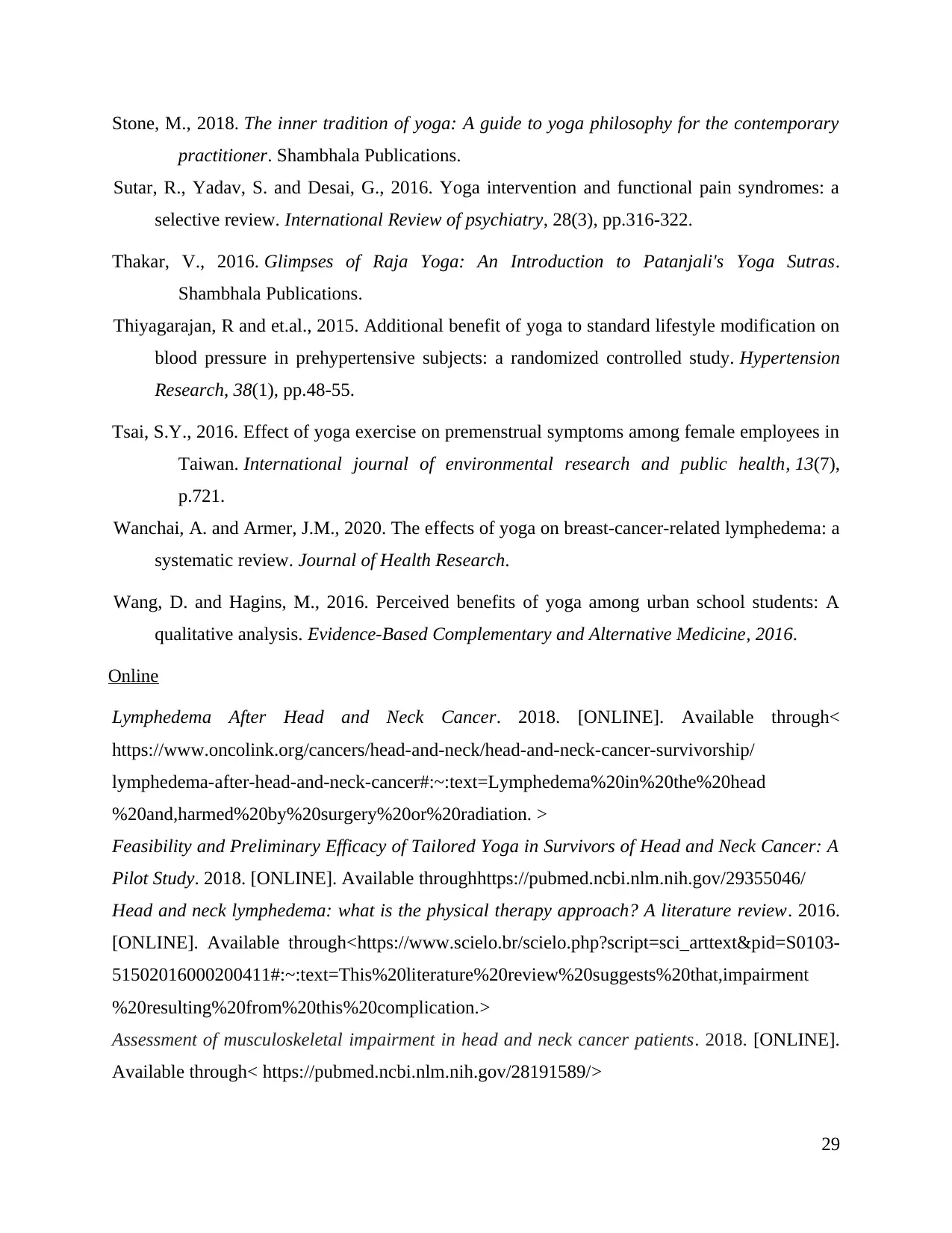
Stone, M., 2018. The inner tradition of yoga: A guide to yoga philosophy for the contemporary
practitioner. Shambhala Publications.
Sutar, R., Yadav, S. and Desai, G., 2016. Yoga intervention and functional pain syndromes: a
selective review. International Review of psychiatry, 28(3), pp.316-322.
Thakar, V., 2016. Glimpses of Raja Yoga: An Introduction to Patanjali's Yoga Sutras.
Shambhala Publications.
Thiyagarajan, R and et.al., 2015. Additional benefit of yoga to standard lifestyle modification on
blood pressure in prehypertensive subjects: a randomized controlled study. Hypertension
Research, 38(1), pp.48-55.
Tsai, S.Y., 2016. Effect of yoga exercise on premenstrual symptoms among female employees in
Taiwan. International journal of environmental research and public health, 13(7),
p.721.
Wanchai, A. and Armer, J.M., 2020. The effects of yoga on breast-cancer-related lymphedema: a
systematic review. Journal of Health Research.
Wang, D. and Hagins, M., 2016. Perceived benefits of yoga among urban school students: A
qualitative analysis. Evidence-Based Complementary and Alternative Medicine, 2016.
Online
Lymphedema After Head and Neck Cancer. 2018. [ONLINE]. Available through<
https://www.oncolink.org/cancers/head-and-neck/head-and-neck-cancer-survivorship/
lymphedema-after-head-and-neck-cancer#:~:text=Lymphedema%20in%20the%20head
%20and,harmed%20by%20surgery%20or%20radiation. >
Feasibility and Preliminary Efficacy of Tailored Yoga in Survivors of Head and Neck Cancer: A
Pilot Study. 2018. [ONLINE]. Available throughhttps://pubmed.ncbi.nlm.nih.gov/29355046/
Head and neck lymphedema: what is the physical therapy approach? A literature review. 2016.
[ONLINE]. Available through<https://www.scielo.br/scielo.php?script=sci_arttext&pid=S0103-
51502016000200411#:~:text=This%20literature%20review%20suggests%20that,impairment
%20resulting%20from%20this%20complication.>
Assessment of musculoskeletal impairment in head and neck cancer patients. 2018. [ONLINE].
Available through< https://pubmed.ncbi.nlm.nih.gov/28191589/>
29
practitioner. Shambhala Publications.
Sutar, R., Yadav, S. and Desai, G., 2016. Yoga intervention and functional pain syndromes: a
selective review. International Review of psychiatry, 28(3), pp.316-322.
Thakar, V., 2016. Glimpses of Raja Yoga: An Introduction to Patanjali's Yoga Sutras.
Shambhala Publications.
Thiyagarajan, R and et.al., 2015. Additional benefit of yoga to standard lifestyle modification on
blood pressure in prehypertensive subjects: a randomized controlled study. Hypertension
Research, 38(1), pp.48-55.
Tsai, S.Y., 2016. Effect of yoga exercise on premenstrual symptoms among female employees in
Taiwan. International journal of environmental research and public health, 13(7),
p.721.
Wanchai, A. and Armer, J.M., 2020. The effects of yoga on breast-cancer-related lymphedema: a
systematic review. Journal of Health Research.
Wang, D. and Hagins, M., 2016. Perceived benefits of yoga among urban school students: A
qualitative analysis. Evidence-Based Complementary and Alternative Medicine, 2016.
Online
Lymphedema After Head and Neck Cancer. 2018. [ONLINE]. Available through<
https://www.oncolink.org/cancers/head-and-neck/head-and-neck-cancer-survivorship/
lymphedema-after-head-and-neck-cancer#:~:text=Lymphedema%20in%20the%20head
%20and,harmed%20by%20surgery%20or%20radiation. >
Feasibility and Preliminary Efficacy of Tailored Yoga in Survivors of Head and Neck Cancer: A
Pilot Study. 2018. [ONLINE]. Available throughhttps://pubmed.ncbi.nlm.nih.gov/29355046/
Head and neck lymphedema: what is the physical therapy approach? A literature review. 2016.
[ONLINE]. Available through<https://www.scielo.br/scielo.php?script=sci_arttext&pid=S0103-
51502016000200411#:~:text=This%20literature%20review%20suggests%20that,impairment
%20resulting%20from%20this%20complication.>
Assessment of musculoskeletal impairment in head and neck cancer patients. 2018. [ONLINE].
Available through< https://pubmed.ncbi.nlm.nih.gov/28191589/>
29
Paraphrase This Document
Need a fresh take? Get an instant paraphrase of this document with our AI Paraphraser
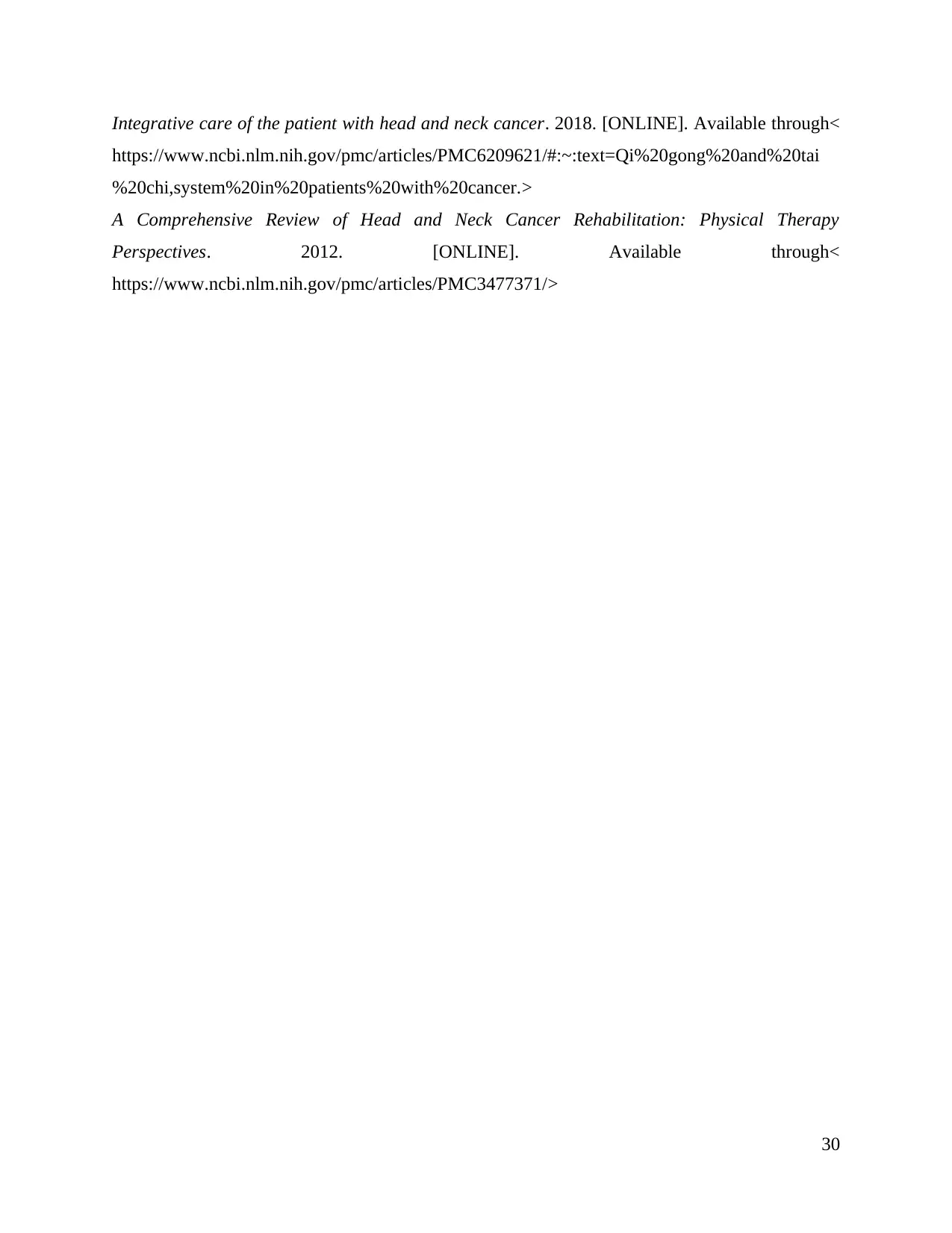
Integrative care of the patient with head and neck cancer. 2018. [ONLINE]. Available through<
https://www.ncbi.nlm.nih.gov/pmc/articles/PMC6209621/#:~:text=Qi%20gong%20and%20tai
%20chi,system%20in%20patients%20with%20cancer.>
A Comprehensive Review of Head and Neck Cancer Rehabilitation: Physical Therapy
Perspectives. 2012. [ONLINE]. Available through<
https://www.ncbi.nlm.nih.gov/pmc/articles/PMC3477371/>
30
https://www.ncbi.nlm.nih.gov/pmc/articles/PMC6209621/#:~:text=Qi%20gong%20and%20tai
%20chi,system%20in%20patients%20with%20cancer.>
A Comprehensive Review of Head and Neck Cancer Rehabilitation: Physical Therapy
Perspectives. 2012. [ONLINE]. Available through<
https://www.ncbi.nlm.nih.gov/pmc/articles/PMC3477371/>
30
1 out of 32
Related Documents
Your All-in-One AI-Powered Toolkit for Academic Success.
+13062052269
info@desklib.com
Available 24*7 on WhatsApp / Email
![[object Object]](/_next/static/media/star-bottom.7253800d.svg)
Unlock your academic potential
© 2024 | Zucol Services PVT LTD | All rights reserved.





